Microwave-Assisted Synthesis of Bioactive Six-Membered Heterocycles and Their Fused Analogues
Abstract
:1. Introduction
2. Synthesis of Heterocyclic Compounds
2.1. Six-Membered Heterocycles with One Heteroatom
2.1.1. Pyridines, Dihydropyridines, Piperidines
2.1.2. Quinolines
2.1.3. Pyrans
2.1.4. Benzopyrones: Coumarins and Chromones
2.2. Six-Membered Heterocycles with Two Heteroatoms
2.2.1. Pyridazines
2.2.2. Pyrimidines, Quinazolines
2.2.3. Piperazines, Pyrazines and Oxazines
2.3. Six-Membered Heterocycles with Three or Four Nitrogen: Triazines and Tetrazines
3. Conclusions
Acknowledgments
Author Contributions
Conflicts of Interest
Abbreviations
| ATP | Adenosine TriPhosphate |
| ATR | Ataxia Telangiectasia and Rad3-related protein |
| BINAP | 2,2′-Bis(diphenylphosphino)-1,1′-binaphthyl |
| DBU | 1,8-Diazabicyclo[5.4.0]undec-7-ene |
| DCB | 1,4-Dichlorobenzene |
| DIPA | Diisopropylamine |
| DMS | DiMethyl Sulfate |
| GABA | Gamma-AminoButyric Acid |
| HATU | 1-[Bis(dimethylamino)methylene]-1H-1,2,3-triazolo[4,5-b]pyridinium-3-oxid hexafluorophosphate |
| HBTU | 2-(1H-benzotriazol-1-yl)-1,1,3,3-tetramethyluronium hexafluorophosphate |
| HOBt | Hydroxybenzotriazole |
| HPLC | High-Performance Liquid Cchromatography |
| IC50 | Half maximal inhibitory concentration |
| LUMOdiene | Lowest Unoccupied Molecular Orbital in the dienophile |
| MIC | Minimum Inhibitory Concentration |
| MW | Microwave |
| NAD | Nicotinamide Adenine Dinucleotide |
| NADPH | Nicotinamide Adenine Dinucleotide Phosphate Hydrogen |
| Nos | The nosyl group |
| Pbf | 2,2,4,6,7-Pentamethyldihydrobenzofuran-5-sulfonyl |
| PEG | Polyethylene glycol |
| PPE | PolyPhosphoric Ester |
| SES | The 2-(trimethylsilyl)ethanesulfonyl group |
| SNAr | Nucleophilic aromatic substitution |
| TBAB | Tetrabutylammonium bromide |
| TBDMS | Tert-butyldimethylsilyl |
| TEA | Triethylamine |
| TFA | Trifluoroacetic acid |
| U-4CR | Ugi four-Component Reaction |
| UHP | Urea Hydrogen Peroxide |
References
- Bougrin, K.; Loupy, A.; Soufiaoui, M. Microwave-assisted solvent free heterocyclic synthesis. J. Photochem. Photobiol. C Photochem. Rev. 2005, 6, 139–167. [Google Scholar] [CrossRef]
- Kappe, C.O.; Dallinger, D. Controlled microwave heating in modern organic synthesis: Highlights from the 2004–2008 literature. Mol. Divers. 2009, 13, 71–193. [Google Scholar] [CrossRef] [PubMed]
- Caddick, S.; Fitzmaurice, R. Microwave enhanced synthesis. Tetrahedron 2009, 65, 3325–3355. [Google Scholar] [CrossRef]
- Appukkuttan, P.; Mehta, V.P.; van der Eycken, E. Microwave-assisted cycloaddition reactions. Chem. Soc. Rev. 2010, 39, 1467–1477. [Google Scholar] [CrossRef] [PubMed]
- Marzag, H.; Saber, A.; Bougrin, K.; Benhida, R. Microwave-assisted cycloaddition reactions in carbo- and heterocyclic chemistry. Curr. Org. Chem. 2014, 18, 2139–2180. [Google Scholar]
- De la Hoz, A.; Loupy, A. Microwaves in Organic Synthesis, 3rd ed.; Wiley-VCH: Weinheim, Germany, 2012. [Google Scholar]
- Eicher, T.; Hauptmann, S.; Speicher, A. The Chemistry of Heterocycles: Structures, Reactions, Synthesis, and Applications, 3rd ed.; Wiley-VCH: Weinheim, Germany, 2013. [Google Scholar]
- Chauhan, M.; Kumar, R. A comprehensive review on bioactive fused heterocycles as purine-utilizing enzymes inhibitors. Med. Chem. Res. 2015, 24, 2259–2282. [Google Scholar] [CrossRef]
- Dallinger, D.; Kappe, C.O. Microwave-assisted synthesis in water as solvent. Chem. Rev. 2007, 107, 2563–2591. [Google Scholar] [CrossRef] [PubMed]
- Pedersen, S.L.; Pernille Tofteng, A.; Malika, L.; Jensen, K.J. Microwave heating in solid-phase peptide synthesis. Chem. Soc. Rev. 2012, 41, 1826–1844. [Google Scholar] [CrossRef] [PubMed]
- Chauveau, E.; Marestin, C.; Mercier, R. Microwave-assisted synthesis of tetrasubstituted aryl imidazole based polymers via cascade polycondensation process. Polymer 2014, 55, 6435–6438. [Google Scholar] [CrossRef]
- Pineiro, M. Microwave-assisted synthesis and reactivity of porphyrins. Curr. Org. Synth. 2014, 11, 89–109. [Google Scholar] [CrossRef]
- Zhu, Y.J.; Chen, F. Microwave-assisted preparation of inorganic nanostructures in liquid phase. Chem. Rev. 2014, 114, 6462–6555. [Google Scholar] [CrossRef] [PubMed]
- Chemat, F.; Cravotto, G. (Eds.) Microwave-Assisted Extraction for Bioactive Compounds; Springer: New York, NY, USA, 2013.
- Polshettiwar, V.; Varma, R.S. Greener and expeditious synthesis of bioactive heterocycles using microwave irradiation. Pure Appl. Chem. 2008, 80, 777–790. [Google Scholar] [CrossRef]
- Kumar, R.; Ermolat’ev, D.S.; van der Eycken, E.V. Synthesis of differentially substituted 2-aminoimidazolidines via a microwave-assisted tandem Staudinger/aza-Wittig cyclization. J. Org. Chem. 2013, 78, 5737–5743. [Google Scholar] [CrossRef] [PubMed]
- Driowya, M.; Bougrin, K.; Benhida, R. Recent advances in microwave-assisted heterocyclic chemistry. Synthesis of three, four and five-membred heterocycles. In Targets in Heterocyclic Systems-Chemistry and Properties; Attanasi, O.A., Spinelli, D., Eds.; Royal Society of Chemistry: Cambridge, UK, 2011; Volume 15, pp. 327–371. [Google Scholar]
- Nagender, P.; Reddy, G.M.; Kumar, R.N.; Poornachandra, Y.; Kumar, C.G.; Narsaiah, B. Synthesis, cytotoxicity, antimicrobial and anti-biofilm activities of novel pyrazolo[3,4-b]pyridine and pyrimidine functionalized 1,2,3-triazole derivatives. Bioorg. Med. Chem. Lett. 2014, 24, 2905–2908. [Google Scholar] [CrossRef] [PubMed]
- Guo, K.; Mutter, R.; Heal, W.; Reddy, T.R.K.; Cope, H.; Pratt, S.; Thompson, M.J.; Chen, B.N. Synthesis and evaluation of a focused library of pyridine dicarbonitriles against prion disease. Eur. J. Med. Chem. 2008, 43, 93–106. [Google Scholar] [CrossRef] [PubMed]
- Altaf, A.A.; Shahzad, A.; Gul, Z.; Rasool, N.; Badshah, A.; Lal, B.; Khan, E. A review on the medicinal importance of pyridine derivatives. J. Drug Des. Med. Chem. 2015, 1, 1–11. [Google Scholar]
- Lohray, B.B.; Lohray, V.B.; Srivastava, B.K. Novel tetrahydro-thieno pyridyl oxazolidinone: An antibacterial agent. Bioorg. Med. Chem. 2004, 17, 4557–4564. [Google Scholar] [CrossRef] [PubMed]
- Thompson, A.M.; Bridges, A.J.; Fry, D.W. Tyrosine kinase inhibitors. 7. 7-amino-4-(phenylamino)- and 7-amino-4[(phenylmethyl)amino]pyrido[4,3-d]pyrimidines: A new class of inhibitors of the tyrosine kinase activity of the epidermal growth factor receptor. J. Med. Chem. 1995, 38, 3780–3788. [Google Scholar] [CrossRef] [PubMed]
- Rewcastle, G.W.; Palmer, B.D.; Thompson, A.M. Tyrosine kinase inhibitors. 9. Synthesis and evaluation of fused tricyclic quinazoline analogues as ATP site inhibitors of the tyrosine kinase activity of the epidermal growth factor receptor. J. Med. Chem. 1996, 39, 1823–1835. [Google Scholar] [CrossRef] [PubMed]
- Smaill, J.B.; Palmer, B.D.; Rewcastle, G.W. Tyrosine kinase inhibitors. 15. 4-(phenylamino)quinazoline and 4-(phenylamino)pyrido[d]pyrimidine acrylamides as irreversible inhibitors of the atp binding site of the epidermal growth factor receptor. J. Med. Chem. 1999, 42, 1803–1815. [Google Scholar] [CrossRef] [PubMed]
- Merja, B.C.; Joshi, A.M.; Parikh, K.A. Synthesis and biological evaluation of pyrido[1,2-a]pyrimidine and isoxazoline derivatives. Indian J. Chem. Sect. B 2004, 4, 909–912. [Google Scholar] [CrossRef]
- Chaki, H.; Yamabe, H.; Sugano, M.; Morita, S.; Bessho, T.; Tabata, R.; Saito, K.I.; Egawa, M.; Tobe, A.; Morinaka, Y. Design and syntheses of 4-acylaminopyridine derivatives: Novel high affinity choline uptake enhancers II. Bioorg. Med. Chem. Lett. 1995, 5, 1495–1500. [Google Scholar] [CrossRef]
- Balasubramanian, M.; Keay, J.G. Comprehensive Heterocyclic Chemistry II; Katritzky, A.R., Rees, C.W., Scriven, E.V.F., Eds.; Pergamon Press: London, UK, 1996; Volume 5, pp. 245–300. [Google Scholar]
- Wagenaar, M.M.; Gibson, D.M.; Clardy, J. Akanthomycin, a new antibiotic pyridone from the entomopathogenic fungus akanthomyces gracilis. Org. Lett. 2002, 4, 671–673. [Google Scholar] [CrossRef] [PubMed]
- Dolle, R.E.; Nicolaou, K.C. Total synthesis of elfamycins: Aurodox and efrotomycin. 1. Strategy and construction of key intermediates. J. Am. Chem. Soc. 1985, 107, 1691–1694. [Google Scholar] [CrossRef]
- Hu, J.D.; Cao, C.D.; Lin, W.; Hu, M.-H.; Huang, Z.-B.; Shi, D.-Q. Selective synthesis of polyfunctionalized pyrido[2,3-b]indoles by multicomponent domino reactions. J. Org. Chem. 2014, 79, 7935–7944. [Google Scholar] [CrossRef] [PubMed]
- El-borai, M.A.; Rizk, H.F.; Abd-Aal, M.F.; El-Deeb, I.Y. Synthesis of pyrazolo[3,4-b]pyridines under microwave irradiation in multi-component reactions and their antitumor and antimicrobial activities—Part 1. Eur. J. Med. Chem. 2012, 48, 92–96. [Google Scholar] [CrossRef] [PubMed]
- Sridhar, M.; Ramanaiah, B.C.; Narsaiah, C.; Mahesh, B.; Kumaraswamy, M.; Mallu, K.K.R.; Ankathi, V.M.; Shanthan Rao, P. Novel ZnCl2-catalyzed one-pot multicomponent synthesis of 2-amino-3,5-dicarbonitrile-6-thio-pyridines. Tetrahedron Lett. 2009, 50, 3897–3900. [Google Scholar] [CrossRef]
- Linder, I.; Gerhard, M.; Schefzig, L.; Andrä, M.; Bentz, C.; Reissig, H.-U.; Zimmer, R. A modular synthesis of functionalized pyridines through Lewis-acid-mediated and microwave-assisted cycloadditions between azapyrylium intermediates and alkynes. Eur. J. Org. Chem. 2011, 2011, 6070–6077. [Google Scholar] [CrossRef]
- Weike, S.; Shaozheng, G.; Zhi, H.; Ren’er, C. Microwave-assisted novel synthesis of amino-thieno[3,2-b]pyridines under solvent-free conditions. Tetrahedron Lett. 2010, 51, 5718–5720. [Google Scholar]
- Hilgeroth, A.; Wiese, M.; Billich, A. Synthesis and biological evaluation of the first N-alkyl cage dimeric 4-aryl-1,4-dihydropyridines as novel nonpeptidic HIV-1 protease inhibitors. J. Med. Chem. 1999, 42, 4729–4732. [Google Scholar] [CrossRef] [PubMed]
- Chhillara, A.K.; Arya, P.; Mukherjee, C.; Kumar, P.; Yadav, Y.; Sharma, A.K.; Yadav, V.; Gupta, J.; Dabur, R.; Jhac, H.N.; et al. Microwave-assisted synthesis of antimicrobial dihydropyridines and tetrahydropyrimidin-2-ones: Novel compounds against aspergillosis. Bioorg. Med. Chem. 2006, 14, 973–981. [Google Scholar] [CrossRef] [PubMed]
- Fasani, E.; Fagnoni, M.; Dondi, D.; Albini, A. Intramolecular electron transfer in the photochemistry of some nitrophenyldihydropyridines. J. Org. Chem. 2006, 71, 2037–2045. [Google Scholar] [CrossRef] [PubMed]
- Iqbal, N.; Akula, M.R.; Vo, D.; Matowe, W.C.; McEwen, C.A.; Wolowyk, M.W.; Knaus, E.E. Synthesis, rotamer orientation, and calcium channel modulation activities of alkyl and 2-phenethyl 1,4-dihydro-2,6-dimethyl-3-nitro-4-(3- or 6-substituted-2-pyridyl)-5-pyridinecarboxylates. J. Med. Chem. 1998, 41, 1827–1837. [Google Scholar] [CrossRef] [PubMed]
- Vanden Eynde, J.J.; Mayence, A. Synthesis and aromatization of hantzsch 1,4-dihydropyridines under microwave irradiation. An Overview. Molecules 2003, 8, 381–391. [Google Scholar] [CrossRef]
- Flaim, S.F.; Zelis, R. Clinical use of calcium entry blockers. Fed. Proc. 1981, 40, 2877–2881. [Google Scholar] [PubMed]
- Schramm, M.; Thomas, G.; Towart, R.; Franckowiak, G. Novel dihydropyridines with positive inotropic action through activation of Ca2+ channels. Nature 1983, 303, 535–537. [Google Scholar] [CrossRef] [PubMed]
- Triggle, D.J.; Rampe, D. 1,4-Dihydropyridine activators and antagonists: Structural and functional distinctions. Trends Pharmacol. Sci. 1989, 12, 507–511. [Google Scholar] [CrossRef]
- Kuraitheerthakumaran, A.; Pazhamalai, S.; Gopalakrishnan, M. An efficient and solvent-free one-pot synthesis of 1,4-dihydropyridines under microwave irradiation. Chin. Chem. Lett. 2011, 22, 1199–1202. [Google Scholar] [CrossRef]
- Sharma, S.D.; Hazarika, P.; Konwar, D. A simple, green and one-pot four-component synthesis of 1,4-dihydropyridines and their aromatization. Catal. Commun. 2008, 9, 709–714. [Google Scholar] [CrossRef]
- Debache, A.; Ghalem, W.; Boulcina, R. An efficient one-step synthesis of 1,4-dihydropyridines via a triphenylphosphine-catalyzed three-component Hantzsch reaction under mild conditions. Tetrahedron Lett. 2009, 50, 5248–5250. [Google Scholar] [CrossRef]
- Sridhar, R.; Perumal, P.T. A new protocol to synthesize 1,4-dihydropyridines by using 3,4,5-trifluorobenzeneboronic acid as a catalyst in ionic liquid: Synthesis of novel 4-(3-carboxyl-1H-pyrazol-4-yl)-1,4-dihydropyridines. Tetrahedron 2005, 61, 2465–2470. [Google Scholar] [CrossRef]
- Ladani, N.K.; Mungra, D.C.; Patel, M.P.; Patel, R.G. Microwave assisted synthesis of novel Hantzsch 1,4-dihydropyridines, acridine-1,8-diones and polyhydroquinolines bearing the tetrazolo[1,5-a]quinoline moiety and their antimicrobial activity assess. Chin. Chem. Lett. 2011, 22, 1407–1410. [Google Scholar] [CrossRef]
- Finke, P.E.; Oates, B.; Mills, S.G.; MacCoss, M.; Malkowitz, L.; Springer, M.S.; Gould, S.L.; Demartino, J.A.; Carella, A.; Carver, G.; et al. Antagonists of the human CCR5 receptor as anti-HIV-1 agents. Part 4: Synthesis and structure–Activity relationships for 1-[N-(Methyl)-N-(phenylsulfonyl)amino]-2-(phenyl)-4-(4-(N-(alkyl)-N-(benzyloxycarbonyl)amino)piperidin-1-yl)butanes. Bioorg. Med. Chem. Lett. 2001, 11, 2475–2479. [Google Scholar] [CrossRef]
- Trabaco, A.A.; Aerts, N.; Alvarez, R.M.; Andres, J.I.; Boeckx, I.; Fernandez, J.; Gomez, A.; Janssens, F.E.; Leenaerts, J.E.; Lucas, A.I.D.; et al. 4-Phenyl-4-[1H-imidazol-2-yl]-piperidine derivatives as non-peptidic selective δ-opioid agonists with potential anxiolytic/antidepressant properties. Part 2. Bioorg. Med. Chem. Lett. 2007, 17, 3860–3863. [Google Scholar] [CrossRef] [PubMed]
- Takaya, Y.; Tasaka, H.; Chiba, T.; Uwai, K.; Tanitsu, M.; Kim, H.S.; Wataya, Y.; Miura, M.; Takeshita, M.; Oshima, Y. New type of febrifugine analogues, bearing a quinolizidine moiety, show potent antimalarial activity against plasmodium malaria parasite. J. Med. Chem. 1999, 42, 3163–3166. [Google Scholar] [CrossRef] [PubMed]
- Ravindran, G.; Muthusubramanian, S.; Perumal, S. A convenient one-pot synthesis of highly substituted piperidines through a Michael addition-aldol cyclization sequence. ARKIVOC 2008, 13, 57–64. [Google Scholar]
- Solomon, V.R.; Haq, W.; Srivastava, K.; Puri, S.K.; Katti, S.B. Synthesis and antimalarial activity of side chain modified 4-aminoquinoline derivatives. J. Med. Chem. 2007, 50, 394–398. [Google Scholar] [CrossRef] [PubMed]
- Chauhan, P.M.S.; Srivastava, S.K. Present trends and future strategy in chemotherapy of malaria. Curr. Med. Chem. 2001, 8, 1535–1542. [Google Scholar]
- Michael, J.P. Quinoline, quinazoline and acridone alkaloids. Nat. Prod. Rep. 2007, 24, 223–246. [Google Scholar] [CrossRef] [PubMed]
- Kim, J.I.; Shin, I.-S.; Kim, H.; Lee, J.-K. Efficient electrogenerated chemiluminescence from cyclometalated Iridium(III) complexes. J. Am. Chem. Soc. 2005, 127, 1614–1615. [Google Scholar] [CrossRef] [PubMed]
- Kouznetsov, V.V.; Gomez-Barrio, A. Recent developments in the design and synthesis of hybrid molecules basedon aminoquinoline ring and their antiplasmodial evaluation. Eur. J. Med. Chem. 2009, 44, 3091–3113. [Google Scholar] [CrossRef] [PubMed]
- Kaur, K.; Jain, M.; Reddy, R.P.; Jain, R. Quinolines and structurally related heterocycles as antimalarials. Eur. J. Med. Chem. 2010, 45, 3245–3264. [Google Scholar] [CrossRef] [PubMed]
- Blackie, M.A. Metal Containing chloroquinolines: Beyond hit and miss antimalarial efficacy to solid science. Mini Rev. Med. Chem. 2013, 13, 597–606. [Google Scholar] [CrossRef] [PubMed]
- Jain, P.P.; Degani, M.S.; Raju, A.; Ray, M.; Rajan, M.G. Rational drug design based synthesis of novel arylquinolines as anti-tuberculosis agents. Bioorg. Med. Chem. Lett. 2013, 23, 6097–6105. [Google Scholar] [CrossRef] [PubMed]
- Karras, S.; Pontikides, N.; Krassas, G.E. Pharmacokinetic evaluation of cabozantinib for the treatment of thyroid cancer. Expert Opin. Drug Metab. Toxicol. 2013, 9, 507–515. [Google Scholar] [CrossRef] [PubMed]
- Kulkarni, A.; Török, B. Microwave-assisted multicomponent domino cyclization–aromatization: An efficient approach for the synthesis of substituted uinolines. Green Chem. 2010, 12, 875–878. [Google Scholar] [CrossRef]
- Kumar, S.; Patel, A.; Ahmed, N. Microwave-assisted expeditious and efficient synthesis of novel quinolin-4-ylmethoxychromen-2- and -4-ones catalyzed by YbCl3 under a solvent free one-pot three component domino reaction and their antimicrobial activity. RSC Adv. 2015, 5, 93067–93080. [Google Scholar] [CrossRef]
- Li, MY.; Xu, H.W.; Fan, W.; Ye, Q.; Wang, X.; Jiang, B.; Wang, S.L.; Tu, S.J. New formal [3+3] cycloaddition of enaminones for forming tetracyclic indolo[2,3-b]quinolines under microwave irradiation. Tetrahedron 2014, 70, 1004–1010. [Google Scholar] [CrossRef]
- Barluenga, J.; Quinones, N.; Cabal, M.P.; Aznar, F.; Valdés, C. Tosylhydrazide-promoted Palladium-catalyzed reaction of β-aminoketones with o-dihaloarenes: Combining organocatalysis and transition-metal catalysis. Angew. Chem. 2011, 123, 2398–2401. [Google Scholar] [CrossRef]
- Bala, B.D.; Balamurugan, K.; Perumal, S. Facile, four-component, domino reactions for the regioselective synthesis of tetrahydrobenzo[g]quinolones. Tetrahedron Lett. 2011, 52, 4562–4566. [Google Scholar] [CrossRef]
- Sapkal, S.B.; Shelke, K.F.; Shingate, B.B.; Shingare, M. Nickel nanoparticle-catalyzed facile and efficient one-pot synthesis of polyhydroquinoline derivatives via Hantzsch condensation under solvent-free conditions. Tetrahedron Lett. 2009, 50, 1754–1756. [Google Scholar] [CrossRef]
- Park, S.; Kim, H.-S.; Ok, K.; Kim, Y.; Park, H.-D.; Byun, Y. Design, synthesis and biological evaluation of 4-(alkyloxy)-6-methyl-2H-pyran-2-one derivatives as quorum sensing inhibitors. Bioorg. Med. Chem. Lett. 2015, 25, 2913–2917. [Google Scholar] [CrossRef] [PubMed]
- Kumar, A.; Reddy, V.B.; Sharad, S.; Dube, U.; Kapur, S. A facile one-pot green synthesis and antibacterial activity of 2-amino-4H-pyrans and 2-amino-5-oxo-5,6,7,8-tetrahydro-4H-chromenes. Eur. J. Med. Chem. 2009, 44, 3805–3809. [Google Scholar] [CrossRef] [PubMed]
- Pinto, M.M.M.; Sousa, M.E.; Nascimento, M.S. Xanthone derivatives: New insights in biological activities. Curr. Med. Chem. 2005, 12, 2517–2538. [Google Scholar] [CrossRef] [PubMed]
- Moharram, S.; Zhou, A.; Wiebe, L.I.; Knaus, E.E. Design and synthesis of 3′- and 5′-O-(3-benzenesulfonylfuroxan-4-yl)-2′-deoxyuridines: Biological evaluation as hybrid nitric oxide donor—Nucleoside anticancer agents. J. Med. Chem. 2004, 47, 1840–1846. [Google Scholar] [CrossRef] [PubMed]
- Peng, Y.; Song, G. Amino-functionalized ionic liquid as catalytically active solvent for microwave-assisted synthesis of 4H-pyrans. Catal. Commun. 2007, 8, 111–114. [Google Scholar] [CrossRef]
- Kamalraja, J.; Perumal, P.T. Microwave assisted InCl3 mediated regioselective synthesis of highly functionalized indolylpyran under solvent-free condition and its chemical transformation to indolyltriazolylpyran hybrids. Tetrahedron Lett. 2014, 55, 3561–3564. [Google Scholar] [CrossRef]
- Sakemi, S.; Sun, H.H. Nortopsentins A, B, and C. Cytotoxic and antifungal imidazolediylbis [indoles] from the sponge Spongosorites ruetzleri. J. Org. Chem. 1991, 56, 4304–4307. [Google Scholar]
- Kawasaki, I.; Yamashita, M.; Ohta, S. Total synthesis of nortopsentins A-D, marine alkaloids. Chem. Pharm. Bull. 1996, 44, 1831–1839. [Google Scholar] [CrossRef]
- Kouko, T.; Matsumura, K.; Kawasaki, T. Total synthesis of marine bisindole alkaloids, (+)-hamacanthins A, B and (−)-antipode of cis-dihydrohamacanthin B. Tetrahedron 2005, 61, 2309–2318. [Google Scholar] [CrossRef]
- Higuchi, K.; Takei, R.; Kouko, T.; Kawasaki, T. Total synthesis of marine bisindole alkaloid (+)-cis-dihydrohamacanthin B. Synthesis 2007, 5, 669–674. [Google Scholar] [CrossRef]
- Jiang, B.; Yang, C.G.; Xiong, W.N.; Wang, J. Synthesis and cytotoxicity evaluation of novel indolylpyrimidines and indolylpyrazines as potential antitumor agents. Bioorg. Med. Chem. 2001, 9, 1149–1154. [Google Scholar] [CrossRef]
- Gompel, M.; Leost, M.; Joffe, E.B.K.; Puricelli, L.; Franco, L.H.; Palermo, J.; Meijer, L. Meridianins, a new family of protein kinase inhibitors isolated from the Ascidian Aplidium meridianum. Bioorg. Med. Chem. Lett. 2004, 14, 1703–1707. [Google Scholar] [CrossRef] [PubMed]
- Curini, M.; Cravotto, G.; Epifano, F.; Giannone, G. Chemistry and biological activity of natural and synthetic prenyloxycoumarins. Curr. Med. Chem. 2006, 13, 199–222. [Google Scholar] [CrossRef] [PubMed]
- Yu, D.; Suzuki, M.; Xie, L.; Morris-Natschke, S.L.; Lee, K.-H. Recent progress in the development of coumarin derivatives as potent anti-HIV agents. Med. Res. Rev. 2003, 23, 322–345. [Google Scholar] [CrossRef] [PubMed]
- Khan, K.M.; Saify, Z.S.; Khan, M.Z.; Choudhary, M.I.; Perveen, S.; Chohan, Z.H.; Supuran, C.T.; Ullah, Z.; Rahman, A.U. Synthesis of coumarin derivatives with cytotoxic, antibacterial and antifungal activity. J. Enz. Inhib. Med. Chem. 2004, 19, 373–379. [Google Scholar] [CrossRef]
- Borges, F.; Roleira, F.; Milhazes, N.; Santana, L.; Uriarte, E. Simple coumarins and analogues in medicinal chemistry: Occurrence, synthesis and biological activity. Curr. Med. Chem. 2005, 12, 887–916. [Google Scholar] [CrossRef] [PubMed]
- Kulkarni, M.V.; Kulkarni, G.M.; Lin, C.H.; Sun, C.M. Recent advances in coumarins and 1-azacoumarins as versatile biodynamic agents. Curr. Med. Chem. 2006, 13, 2795–2818. [Google Scholar] [CrossRef] [PubMed]
- Bhat, A.S.; Yu, D.L.; Chen, C.H.; Brossi, A.; Lee, K.H. Anti-AIDS agents. 60. Substituted 3′R,4′R-di-O-(−)-camphanoyl-2′,2′-dimethyldihydropyrano[2,3-f]chromone (DCP) analogues as potent anti-HIV agents. J. Med. Chem. 2004, 47, 4072–4082. [Google Scholar]
- Bennett, C.J.; Caldwell, S.T.; McPhail, D.B.; Morrice, P.C.; Duthie, G.G.; Hartley, R.C. Potential therapeutic antioxidants that combine the radical scavenging ability of myricetin and the lipophilic chain of vitamin E to effectively inhibit microsomal lipid peroxidation. Bioorg. Med. Chem. 2004, 12, 2079–2098. [Google Scholar] [CrossRef] [PubMed]
- Krishnamachari, V.; Levine, L.H.; Zhou, C.; Pare, P.W. In vitro flavon-3-ol oxidation mediated by a bring hydroxylation pattern. Chem. Res. Toxicol. 2004, 17, 795–804. [Google Scholar] [CrossRef] [PubMed]
- Kim, H.P.; Son, K.H.; Chang, H.W.; Kang, S.S. Anti-inflammatory plant flavonoids and cellular action mechanisms. J. Pharmacol. Sci. 2004, 96, 229–245. [Google Scholar] [CrossRef] [PubMed]
- Middleton, E.; Kandaswami, C.; Theoharides, T.C. The effects of plant flavonoids on mammalian cells: Implications for inflammation, heart disease, and cancer. Pharmacol. Rev. 2000, 52, 673–751. [Google Scholar] [PubMed]
- Bauvois, B.; Puiffe, M.L.; Bongui, J.B.; Paillat, S.; Monneret, C.; Dauzonne, D. Synthesis and biological evaluation of novel flavone-8-acetic acid derivatives as reversible inhibitors of aminopeptidase N/CD13. J. Med. Chem. 2003, 46, 3900–3913. [Google Scholar] [CrossRef] [PubMed]
- Griffin, R.J.; Fontana, G.; Golding, B.T.; Guiard, S.; Hardcastle, I.R.; Leahy, J.J.J.; Martin, N.; Richardson, C.; Rigoreau, L.; Stockley, M.; et al. Selective benzopyranone and pyrimido[2,1-a]isoquinolin-4-one inhibitors of DNA-dependent protein kinase: Synthesis, Structure-activity studies, and radiosensitization of a human tumor cell line in vitro. J. Med. Chem. 2005, 48, 569–585. [Google Scholar] [CrossRef] [PubMed]
- Leahy, J.J.J.; Golding, B.T.; Griffin, R.J.; Hardcastle, I.R.; Richardson, C.; Rigoreau, L.; Smith, G.C.M. Identification of a highly potent and selective DNA-dependent protein kinase (DNA-PK) inhibitor (NU7441) by screening of chromenone libraries. Bioorg. Med. Chem. Lett. 2004, 14, 6083–6087. [Google Scholar] [CrossRef] [PubMed]
- Edwards, A.M.; Howell, J.B.L. The chromones: History, chemistry and clinical development. A tribute to the work of Dr R.E.C. Altounyan. Clin. Exp. Allergy 2000, 30, 756–774. [Google Scholar] [CrossRef] [PubMed]
- Nordlund, J.J. The Pigmentary System: Physiology and Pathophysiology, 2th ed.; Blackwell Publishing, Inc.: Malden, MA, USA, 2006. [Google Scholar]
- de Leeuw, J.; Assen, Y.J.; van der Beek, N.; Bjerring, P.; Neumann, H.A.M. Treatment of vitiligo with khellin liposomes, ultraviolet light and blister roof transplantation. J. Eur. Acad. Dermatol. Venereol. 2011, 25, 74–81. [Google Scholar] [CrossRef] [PubMed]
- Holgate, S.T.; Polosao, R. Treatment strategies for allergy and asthma. Nat. Rev. Immunol. 2008, 8, 218–230. [Google Scholar] [CrossRef] [PubMed]
- Frick, R.W. Three treatments for chronic venous insufficiency: Escin, hydroxyethylrutoside, and Daflon. Angiology 2000, 51, 197–205. [Google Scholar] [CrossRef] [PubMed]
- Dziuba, D.; Benhida, R.; Burger, A. A mild and efficient protocol for the protection of 3-hydroxychromones under phase-transfer catalysis. Synthesis 2011. [Google Scholar] [CrossRef]
- Dziuba, D.; Postupalenko, V.Y.; Spadafora, M.; Klymchenko, A.S.; Guérineau, V.; Mély, Y.; Benhida, R.; Burger, A. The oligonucleotides incorporating a 3-hydroxychromone as a fluorescent base surrogate: A bicolor ratiometric fluorescent probe able to detect DNA—Protein interactions. J. Am. Chem. Soc. 2012, 34, 10209–10213. [Google Scholar] [CrossRef] [PubMed]
- Dziuba, D.; Karpenko, I.A.; Barthes, N.P.F.; Michel, B.Y.; Klymchenko, A.S.; Benhida, R.; Demchenko, A.P.; Mély, Y.; Burger, A. Rational design of a solvatochromic fluorescent uracil analogue with dual-band ratiometric response based on 3-hydroxychromone. Chem. Eur. J. 2014, 20, 1998–2079. [Google Scholar] [CrossRef] [PubMed]
- Spadafora, M.; Postopalenko, V.; Klemchenko, A.; Mély, Y.; Burger, A.; Benhida, R. Efficient synthesis of ratiometric fluorescent nucleosides featuring 3-hydroxy-chromone nucleobases. Tetrahedron 2009, 65, 7809–7816. [Google Scholar] [CrossRef]
- Peyron, C.; Navarre, J.M.; Dubreuil, D.; Vierling, P.; Benhida, R. A stereo- and regio-controlled synthesis of bromothiophenyl-C-nucleosides. Tandem bromination-glycosydation via halogen dance process. Tetrahedron Lett. 2008, 49, 6171–6174. [Google Scholar] [CrossRef]
- Guezguez, R.; Bougrin, K.; El Akri, K.; Benhida, R. Efficient microwave-assisted solvent-free synthesis of α- and β-2′-deoxy-1,2,3-triazolyl-nucleosides. Tetrahedron Lett. 2006, 47, 4807–4811. [Google Scholar] [CrossRef]
- Hannedouche, S.; Souchard, J.P.; Jacquemond-Collet, I.; Moulis, C. Molluscicidal and radical scavenging activity of quinones from the root bark of Caryopteris × clandonensis. Fitoterapia 2002, 73, 520–522. [Google Scholar] [CrossRef]
- De Lima, O.G.; D’Albuquerque, I.L.; de Lima, C.G. Antibiotic substances in higher plants. XX. Antimicrobial activity of some derivatives of lapachol as compared with xyloidone, a new natural O-naphthoquinone isolated from extracts of heartwood of Tabebuia avellanedae. Rev. Inst. Antibiot. Univ. Recife 1962, 4, 3–17. [Google Scholar]
- Machado, T.B.; Pinto, A.V.; Pinto, M.C.F.R.; Leal, I.C.R.; Silva, M.G.; Amaral, A.C.F.; Kuster, R.M.; Netto dos Santos, K.R. In vitro activity of Brazilian medicinal plants, naturally occurring naphthoquinones and their analogues, against methicillin-resistant Staphylococcus aureus. Int. J. Antimicrob. Agents 2003, 21, 279–284. [Google Scholar] [CrossRef]
- Cho, J.Y.; Kim, H.Y.; Choi, G.J.; Jang, K.S.; Lim, H.K.; Lim, C.H.; Cho, K.Y.; Kim, J.C. Dehydro-α-lapachone isolated from Catalpa ovata stems: Activity against plant pathogenic fungi. Pest. Manage. Sci. 2006, 62, 414–418. [Google Scholar] [CrossRef] [PubMed]
- Lee, T.; Kashiwada, Y.; Huang, L.; Snider, J.; Cosentino, M.; Lee, K.H. Suksdorfin: An anti-HIV principle from Lomatium suksdorfii, its structure-activity correlation with related coumarins, and synergistic effects with anti-AIDS nucleosides. Bioorg. Med.Chem. 1994, 2, 1051–1056. [Google Scholar] [CrossRef]
- O’Kennedy, R.; Thornes, R.D. Coumarins: Biology, Applications and Mode of Action; John Wiley & Sons: Chichester, UK, 1997. [Google Scholar]
- Kontogiorgis, C.A.; Savvoglou, K.; Hadjipavlou-Litina, D.J. Antiinflammatory and antioxidant evaluation of novel coumarin derivatives. J. Enzyme Inhib. Med. Chem. 2006, 21, 21–29. [Google Scholar] [CrossRef] [PubMed]
- Guilet, D.; Helesbeux, J.J.; Seraphin, D.; Sevenet, T.; Richomme, P.; Bruneton, J. Novel cytotoxic 4-phenylfuranocoumarins from Calophyllum dispar. J. Nat. Prod. 2001, 64, 563–568. [Google Scholar] [CrossRef] [PubMed] [Green Version]
- Vilar, S.; Quezada, E.; Santana, L.; Uriarte, E.; Yanez, M.; Fraiz, N.; Alcaide, C.; Cano, E.; Orallo, F. Design, synthesis, and vasorelaxant and platelet antiaggregatory activities of coumarin-resveratrol hybrids. Bioorg. Med. Chem. Lett. 2006, 16, 257–261. [Google Scholar] [CrossRef] [PubMed]
- Yeh, J.Y.; Coumar, M.S.; Horng, J.T.; Shiao, H.Y.; Kuo, F.-M.; Lee, H.-L.; Chen, I.C.; Chang, C.W.; Tang, W.F.; Tseng, S.N.; et al. Anti-influenza drug discovery: Structure-activity relationship and mechanistic insight into novel angelicin derivatives. J. Med. Chem. 2010, 53, 1519–1533. [Google Scholar] [CrossRef] [PubMed]
- Hwu, J.R.; Singha, R.; Hong, S.C.; Chang, Y.H.; Das, A.R.; Vliegen, I.; de Clercq, E.; Neyts, J. Synthesis of new benzimidazole-coumarin conjugates as anti-hepatitis C virus agents. Antiviral Res. 2008, 77, 157–162. [Google Scholar] [CrossRef] [PubMed]
- Kontogiorgis, C.A.; Hadjipavlou-Litina, D.J. Synthesis and antiinflammatory activity of coumarin derivatives. J. Med. Chem. 2005, 48, 6400–6408. [Google Scholar] [CrossRef] [PubMed]
- Fylaktakidou, K.C.; Hadjipavlou-Litina, D.J.; Litinas, K.E.; Nicolaides, D.N. Natural and synthetic coumarin derivatives with anti-inflammatory/antioxidant activities. Curr. Pharm. Design 2004, 10, 3813–3826. [Google Scholar] [CrossRef]
- Ghate, M.D.; Kulkarni, M.V.; Shobha, R.; Kattimani, S.Y. Synthesis of vanillin ethers from 4-(bromomethyl) coumarins as anti-inflammatory agents. Eur. J. Med. Chem. 2003, 38, 297–304. [Google Scholar] [CrossRef]
- Shekhar, A.C.; Kumar, A.R.; Sathaiaha, G.; Raju, K.; Shanthan Rao, P.; Sridhar, M.; Narsaiah, B.; Surya Srinivas, P.V.S.; Sridhar, B. An efficient one-pot synthesis of substituted 1H-naphtho[2,1-b]pyrans and 4H-1-benzopyrans (=chromenes) under solvent-free microwave-irradiation conditions. Helv. Chim. Acta 2012, 95, 502–508. [Google Scholar] [CrossRef]
- Wang, S.-L.; Wu, F.-Y.; Cheng, C.; Zhang, G.; Liu, Y.-P.; Jiang, B.; Shi, F.; Tu, S.-J. Multicomponent synthesis of poly-substituted benzo[a]pyrano[2,3-c]phenazine derivatives under microwave heating. ACS Comb. Sci. 2011, 13, 135–139. [Google Scholar] [CrossRef] [PubMed]
- Andrade-Nieto, V.; Goulart, M.; da Silva, J.F.; da Silva, M.J.; Pinto, M.; Pinto, A.; Zalis, M.; Carvalho, L.; Krettli, A. Antimalarial activity of phenazines from lapachol, β-lapachone and its derivatives against Plasmodium falciparum in vitro and Plasmodium berghei in vivo. Bioorg. Med. Chem. Lett. 2004, 14, 1145–1149. [Google Scholar] [CrossRef] [PubMed]
- Neves-Pinto, C.; Malta, V.R.S.; Pinto, M.D.C.F.R.; Santos, R.; Castro, S.; Pinto, A. A trypanocidal phenazine derived from β-lapachone. J. Med. Chem. 2002, 45, 2112–2115. [Google Scholar] [CrossRef] [PubMed]
- Gamage, S.; Spicer, J.; Rewcastle, G.; Milton, J.; Sohal, S.; Dangerfield, W.; Mistry, P.; Vicker, N.; Charlton, P.; Denny, W. Structure-activity relationships for pyrido-, imidazo-, pyrazolo-, pyrazino-, and pyrrolophenazinecarboxamides as topoisomerase-targeted anticancer agents. J. Med. Chem. 2002, 45, 740–743. [Google Scholar] [CrossRef] [PubMed]
- Patil, S.A.; Wang, J.; Li, X.S.; Chen, J.; Jones, T.S.; Ahmed, A.H.; Patil, R.; Seibel, W.L.; Li, W.; Miller, D.D. New substituted 4H-chromenes as anticancer agents. Bioorg. Med.Chem. Lett. 2012, 22, 4458–4461. [Google Scholar] [CrossRef] [PubMed]
- Fridén-Saxin, M.; Pemberton, N.; Andersson, K.S.; Dyrager, C.; Friberg, A.; Grøtli, M.; Luthman, K. Synthesis of 2-alkyl-substituted chromone derivatives using microwave irradiation. J. Org. Chem. 2009, 74, 2755–2759. [Google Scholar] [CrossRef] [PubMed]
- Fridén-Saxin, M.; Seifert, T.; Landergren, M.R.; Suuronen, T.; Lahtela-Kakkonen, M.; Jarho, E.M.; Luthman, K. Synthesis and evaluation of substituted chroman-4-one and chromone derivatives as sirtuin 2-selective inhibitors. J. Med. Chem. 2012, 55, 7104–7113. [Google Scholar] [CrossRef] [PubMed]
- Wen, L.R.; Sun, J.H.; Li, M.; Sun, E.T.; Zhang, S.S. Application of β-(2-chloroaroyl) thioacetanilides in synthesis: An unusual and highly efficient access to thiochromeno[2,3-b]pyridine derivatives. J. Org. Chem. 2008, 73, 1852–1863. [Google Scholar] [CrossRef] [PubMed]
- Jha, M.; Guy, S.; Chou, T.Y. Microwave assisted synthesis of indole-annulated dihydropyrano[3,4-c]chromene derivatives via hetero-Diels–Alder reaction. Tetrahedron Lett. 2011, 52, 4337–4341. [Google Scholar] [CrossRef]
- Sinhamahapatra, A.; Sutradhar, N.; Pahari, S.; Bajaj, H.C.; Panda, A.B. Mesoporous zirconium phosphate: An efficient catalyst for the synthesis of coumarin derivatives through Pechmann condensation reaction. Appl. Catal. A Gen. 2011, 394, 93–100. [Google Scholar] [CrossRef]
- Tyagi, B.; Mishra, M.K.; Jasra, R.V. Microwave-assisted solvent free synthesis of hydroxy derivatives of 4-methyl coumarin using nano-crystalline sulfated-zirconia catalyst. J. Mol. Catal. A Chem. 2008, 286, 41–46. [Google Scholar] [CrossRef]
- Katkevičs, M.; Kontijevskis, A.; Mutule, I.; Sūna, E. Microwave-promoted automated synthesis of a coumarin library. Chem. Heterocycl. Compd. 2007, 43, 151–159. [Google Scholar] [CrossRef]
- Hellal, M.; Bourguignon, J.J.; Bihel, F.J.J. 6-endo-dig Cyclization of heteroarylesters to alkynes promoted by Lewis acid catalyst in the presence of Brønsted acid. Tetrahedron Lett. 2008, 49, 62–65. [Google Scholar] [CrossRef]
- May, M.V.D.; Bommele, K.M.; Boss, H.; Hatzelmann, A.; Slingerland, M.V.; Sterk, G.J.; Timmerman, H. Synthesis and structure-activity relationships of cis-tetrahydrophthalazinone/pyridazinone hybrids: A novel series of potent dual PDE3/PDE4 inhibitory agents. J. Med. Chem. 2003, 46, 2008–2016. [Google Scholar]
- Carotti, A.; Catto, M.; Leonetti, F.; Campagna, F.; Soto-Otero, R.; Méndez-Alvarez, E.; Thull, U.; Testa, B.; Altomare, C. Synthesis and monoamine oxidase inhibitory activity of new pyridazine-, pyrimidine- and 1,2,4-triazine-containing tricyclic derivatives. J. Med. Chem. 2007, 50, 5364–5371. [Google Scholar] [CrossRef] [PubMed]
- Betti, L.; Zanelli, M.; Giannacini, G.; Manetti, F.; Schenone, S.; Strappaghetti, G. Synthesis of new piperazine–pyridazinone derivatives and their binding affinity toward α1-, α2-adrenergic and 5-HT1A serotoninergic receptors. Bioorg. Med. Chem. Lett. 2006, 14, 2828–2836. [Google Scholar] [CrossRef] [PubMed]
- Demirayak, S.; Karaburun, A.C.; Beis, R. Some pyrrole substituted aryl pyridazinone and phthalazinone derivatives and their antihypertensive activities. Eur. J. Med. Chem. 2004, 39, 1089–1095. [Google Scholar] [CrossRef] [PubMed]
- Rodriguez-Ciria, M.; Sanz, A.M.; Yunta, M.J.; Gomez-Contreras, F.; Navarro, P.; Fernandez, I.; Pardo, M.; Cano, C. Synthesis and cytotoxic activity of N,N-bis-{3-[N-(4-chlorobenzo[g]-phthalazin-1-yl)]aminopropyl}-N-methylamine: A new potential DNA bisintercalator. Bioorg. Med. Chem. 2003, 11, 2143–2148. [Google Scholar] [CrossRef]
- Demange, L.; Nait-Abdellah, F.; Lozach, O.; Ferandin, Y.; Gresh, N.; Meijer, L.; Galons, H. Potent inhibitors of CDK5 derived from roscovitine: Synthesis, biological evaluation and molecular modelling. Bioorg. Med. Chem. Lett. 2013, 23, 125–131. [Google Scholar] [CrossRef] [PubMed]
- Carboni, R.A.; Lindsey, R.V. Reactions of tetrazines with unsaturated compounds. A new synthesis of pyridazines. J. Am. Chem. Soc. 1959, 81, 4342–4346. [Google Scholar] [CrossRef]
- Heldmann, D.K.; Sauer, J. Synthesis of metallated (metal = Si, Ge, Sn) pyridazines by cycloaddition of metal substituted alkynes to 1,2,4,5-tetrazine. Tetrahedron Lett. 1997, 38, 5791–5794. [Google Scholar] [CrossRef]
- Sauer, J.; Heldmann, D.K.; Hetzenegger, J.; Krauthan, J.; Sichert, H.; Schuster, J. 1,2,4,5-Tetrazine: Synthesis and reactivity in [4+2] cycloadditions. Eur. J. Org. Chem. 1998, 1998, 2885–2896. [Google Scholar] [CrossRef]
- Soenen, D.R.; Zimpleman, J.M.; Boger, D.L. Synthesis and inverse electron demand diels-alder reactions of 3,6-bis(3,4-dimethoxybenzoyl)-1,2,4,5-tetrazine. J. Org. Chem. 2003, 68, 3593–3598. [Google Scholar] [CrossRef] [PubMed]
- Hoogenboom, R.; Kickelbick, G.; Schubert, U.S. Synthesis and characterization of novel substituted 3,6-di(2-pyridyl)pyridazine metal-coordinating ligands. Eur. J. Org. Chem. 2003, 2003, 4887–4896. [Google Scholar] [CrossRef]
- Helm, M.D.; Moore, J.E.; Plant, A.; Harrity, J.P.A. Synthesis of highly substituted pyridazines through alkynyl boronic ester cycloaddition reactions. Angew. Chem. Int. Ed. 2005, 44, 3889–3892. [Google Scholar] [CrossRef] [PubMed]
- Sauer, J. Comprehensive heterocyclic chemistry II. Pergamon. Lond. 1996, 6, 901–965. [Google Scholar]
- Boger, D.L.; Schaum, R.P.; Garbaccio, R.M. Regioselective inverse electron demand diels-alder reactions of N-acyl 6-amino-3-(methylthio)-1,2,4,5-tetrazines. J. Org. Chem. 1998, 63, 6329–6337. [Google Scholar] [CrossRef] [PubMed]
- Sparey, T.J.; Harrison, T. Inverse electron demand Diels-Alder reactions of 3,6-dichloro-[1,2,4,5]tetrazine. Tetrahedron Lett. 1998, 39, 5873–5874. [Google Scholar] [CrossRef]
- Che, D.; Wegge, T.; Stubbs, M.T.; Seitz, G.; Meier, H.; Methfessel, C. exo-2-(Pyridazin-4-yl)-7-azabicyclo[2.2.1]heptanes: Syntheses and nicotinic acetylcholine receptor agonist activity of potent pyridazine analogues of (±)-epibatidine. J. Med. Chem. 2001, 44, 47–51. [Google Scholar] [CrossRef] [PubMed]
- Hoogenboom, R.; Moore, B.C.; Schubert, U.S. Microwave-assisted synthesis of 3,6-di(pyridin-2-yl)pyridazines: Unexpected ketone and aldehyde cycloadditions. J. Org. Chem. 2006, 71, 4903–4909. [Google Scholar] [CrossRef] [PubMed]
- Horikoshi, S.; Iida, S.; Kajitani, M.; Sato, S.; Serpone, N. Chemical reactions with a novel 5.8-GHz microwave apparatus. 1. Characterization of properties of common solvents and application in a Diels–Alder organic synthesis. Org. Process. Res. Dev. 2008, 12, 257–263. [Google Scholar] [CrossRef]
- Mecadon, H.; Myrboh, B. Potassium hydroxide impregnated Alumina (KOH-Alumina) as a recyclable catalyst for the solvent-free multicomponent synthesis of highly functionalized substituted pyridazines and/or substituted pyridazin-3(2H)-ones under microwave irradiation. ISRN Org. Chem. 2011. [Google Scholar] [CrossRef] [PubMed]
- Agarwal, A.; Srivastava, K.; Purib, S.K.; Chauhana, P.M.S. Synthesis of 2,4,6-trisubstituted pyrimidines as antimalarial agents. Bioorg. Med. Chem. 2005, 13, 4645–4650. [Google Scholar] [CrossRef] [PubMed]
- Chang, L.C.W.; Spanjersberg, R.F.; Künzel, J.K.V.F.D.; Krieger, T.M.; Hout, G.V.D.; Beukers, M.W.; Brussee, J.; IJzerman, A.P. 2,4,6-Trisubstituted pyrimidines as a new class of selective adenosine A1 receptor antagonists. J. Med. Chem. 2004, 47, 6529–6540. [Google Scholar] [CrossRef] [PubMed]
- Bailey, J.P.; Giles, M.B.; Pass, M. 2,4,6-Trisubstituted Pyrimidines as Phosphotidylinositol (pi) 3-Kinase Inhibitors and Their Use in the Treatment of Cancer. Patent WO 2006005914 A1, 19 January 2006. [Google Scholar]
- Agarwal, A.; Srivastava, K.; Puri, S.K.; Sinha, S.; Chauhana, P.M.S. A small library of trisubstituted pyrimidines as antimalarial and antitubercular agents. Bioorg. Med. Chem. Lett. 2005, 15, 5218–5221. [Google Scholar] [CrossRef] [PubMed]
- Nie, A.; Wang, J.; Huang, Z. Microwave-assisted solution-phase parallel synthesis of 2,4,6-trisubstituted pyrimidines. J. Comb. Chem. 2006, 8, 646–648. [Google Scholar] [CrossRef] [PubMed]
- Guo, C. A facile synthesis of pyrimidin-4-ones. Tetrahedron Lett. 2010, 51, 548–549. [Google Scholar] [CrossRef]
- Jiang, B.; Xue, L.-Y.; Wang, X.-H.; Tu, M.-S.; Liu, Y.-P.; Tu, S.-J. Microwave-assisted multicomponent reaction of aryl amidines: Regiospecific synthesis of new polysubstituted thiopyrano-, and pyrano[4,3-d]pyrimidines. Tetrahedron Lett. 2012, 53, 1261–1264. [Google Scholar] [CrossRef]
- Yildirim, M.; Celikel, D.; Durust, Y.; Knight, D.W.; Kariuki, B.M. A rapid and efficient protocol for the synthesis of novel nitrothiazolo[3,2-c]pyrimidines via microwave-mediated Mannich cyclisation. Tetrahedron 2014, 70, 2122–2128. [Google Scholar] [CrossRef]
- Fatima, S.; Sharma, A.; Saxena, R.; Tripathi, R.; Shukla, S.K.; Pandey, S.K.; Tripathi, R.; Tripathi, R.P. One pot efficient diversity oriented synthesis of polyfunctional styryl thiazolopyrimidines and their bio-evaluation as antimalarial and anti-HIV agents. Eur. J. Med. Chem. 2012, 55, 195–204. [Google Scholar] [CrossRef] [PubMed]
- Beck, J.P.; Curry, M.A.; Chorvat, R.J.; Fitzgerrald, L.W.; Gillian, P.J.; Zaczek, R.; Trainor, G.L. Thiazolo[4,5-d]pyrimidine thiones and -ones as corticotropin-releasing hormone (CRH-R1) receptor antagonists. Bioorg. Med. Chem. Lett. 1999, 9, 1185–1188. [Google Scholar] [CrossRef]
- Al-Omary, F.A.M.; Hassan, G.S.; El-Messery, S.M.; El-Subbagh, H.I. Substituted thiazoles V. Synthesis and antitumor activity of novel thiazolo[2,3-b]quinazoline and pyrido[4,3-d]thiazolo[3,2-a]pyrimidine analogues. Eur. J. Med. Chem. 2012, 47, 65–72. [Google Scholar] [CrossRef] [PubMed]
- Polshettiwar, V.; Varma, R.S. Biginelli reaction in aqueous medium: A greener and sustainable approach to substituted 3,4-dihydropyrimidin-2(1H)-ones. Tetrahedron Lett. 2007, 48, 7343–7346. [Google Scholar] [CrossRef]
- Hosamani, K.M.; Reddy, D.S.; Devarajegowda, H.C. Microwave-assisted synthesis of new fluorinated coumarin–pyrimidine hybrids as potent anticancer agents, their DNA cleavage and X-ray crystal studies. RSC Adv. 2015, 5, 11261–11271. [Google Scholar] [CrossRef]
- Matloobi, M.; Kappe, C.O. Microwave-assisted solution- and solid-phase synthesis of 2-amino-4-arylpyrimidine derivatives. J. Comb. Chem. 2007, 9, 275–284. [Google Scholar] [CrossRef] [PubMed]
- Movassaghi, M.; Hill, M.D. Single-step synthesis of pyrimidine derivatives. J. Am. Chem. Soc. 2006, 128, 14254–14255. [Google Scholar] [CrossRef] [PubMed]
- Avalos, M.; Babiano, R.; Cintas, P.; Hursthouse, M.B.; Jiménez, J.L.; Lerma, E.; Light, M.E.; Palacios, J.C. A one-pot domino reaction in constructing isoorotate bases and their nucleosides. Tetrahedron Lett. 2006, 47, 1989–1992. [Google Scholar] [CrossRef]
- Burgula, L.N.; Radhakrishnan, K.; Kundu, M.L. Synthesis of modified uracil and cytosine nucleobases using a microwave-assisted method. Tetrahedron Lett. 2012, 53, 2639–2642. [Google Scholar] [CrossRef]
- Liang, B.; Wang, X.; Wang, J.X.; Du, Z. New three-component cyclocondensation reaction: Microwave-assisted one-pot synthesis of 5-unsubstituted-3,4-dihydropyrimidin-2(1H)-ones under solvent-free conditions. Tetrahedron 2007, 63, 1981–1986. [Google Scholar] [CrossRef]
- Liu, Q.S.; Chang, J.W.; Wang, J.H.; Kang, S.A.; Thoreen, C.C.; Markhard, A.; Hur, W.; Zhang, J.M.; Sim, T.; Sabatini, D.M.; et al. Discovery of 1-(4-(4-Propionylpiperazin-1-yl)-3-(trifluoromethyl)phenyl)-9-(quinolin-3-yl)benzo[h][1,6]naphthyridin-2(1H)-one as a Highly Potent, Selective Mammalian Target of Rapamycin (mTOR) Inhibitor for the Treatment of Cancer. J. Med. Chem. 2010, 53, 7146–7155. [Google Scholar] [CrossRef] [PubMed]
- Lassiter, L.K.; Tummala, M.K.; Hussain, M.H.; Stadler, W.M.; Petrylak, D.P.; Carducci, M.A. Phase II open-label study of oral piritrexim in patients with advanced carcinoma of the urothelium who have experienced failure with standard chemotherapy. Clin. Genitourin. Cancer 2008, 6, 31–35. [Google Scholar] [CrossRef] [PubMed]
- Krueger, A.C.; Madigan, D.L.; Beno, D.W.; Betebenner, D.A.; Carrick, R.; Green, B.E.; He, W.P.; Liu, D.C.; Maring, C.J.; McDaniel, K.F.; et al. Novel Hepatitis C virus replicon inhibitors: Synthesis and structure–activity relationships of fused pyrimidine derivatives. J. Bioorg. Med. Chem. Lett. 2012, 22, 2212–2215. [Google Scholar] [CrossRef] [PubMed]
- Fjellstrom, O.; Deinum, J.; Sjogren, T.; Johansson, C.; Geschwindner, S.; Nerme, V.; Legnehed, A.; McPheat, J.; Olsson, K.; Bodin, C.; et al. Characterization of a small molecule inhibitor of plasminogen activator inhibitor type 1 that accelerates the transition into the latent conformation. J. Biol. Chem. 2013, 288, 873–885. [Google Scholar] [CrossRef] [PubMed]
- Gong, H.W.; Qi, H.; Sun, W.; Zhang, Y.; Jiang, D.; Xiao, J.H.; Yang, X.H.; Wang, Y.; Li, S. Design and synthesis of a series of pyrido[2,3-d]pyrimidine derivatives as CCR4 antagonists. Molecules 2012, 17, 9961–9970. [Google Scholar] [CrossRef] [PubMed]
- El-Gazzar, A.R.B.A.; Hafez, H.N. Synthesis of 4-substituted pyrido[2,3-d]pyrimidin-4(1H)-one as analgesic and anti-inflammatory agents. Bioorg. Med. Chem. Lett. 2009, 19, 3392–3397. [Google Scholar] [CrossRef] [PubMed]
- Narayana, B.L.; Rao, A.R.R.; Rao, P.S. Synthesis of new 2-substituted pyrido[2,3-d]pyrimidin-4(1H)-ones and their antibacterial activity. Eur. J. Med. Chem. 2009, 44, 1369–1376. [Google Scholar] [CrossRef] [PubMed]
- Saundane, A.R.; Vijaykumar, K.; Vaijinath, A.V.; Walmik, P. Synthesis, antimicrobial and antioxidant activities of some new indole derivatives containing pyridopyrimidine and pyrazolopyridine moieties. Med. Chem. Res. 2013, 22, 806–817. [Google Scholar] [CrossRef]
- Wendt, J.A.; Deeter, S.D.; Bove, S.E.; Knauer, C.S.; Brooker, R.M.; Augelli-Szafran, C.E.; Schwarz, R.D.; Kinsora, J.J.; Kilgore, K.S. Synthesis and SAR of 2-aryl pyrido[2,3-d]pyrimidines as potent mGlu5 receptor antagonists. Bioorg. Med. Chem. Lett. 2007, 17, 5396–5399. [Google Scholar] [CrossRef] [PubMed]
- Basiri, A.; Murugaiyah, V.; Osman, H.; Kumar, R.S.; Kia, Y.; Ali, M.A. An expedient, ionic liquid mediated multi-component synthesis of novel piperidone grafted cholinesterase enzymes inhibitors and their molecular modeling study. Bioorg. Med. Chem. 2013, 21, 3022–3031. [Google Scholar] [CrossRef] [PubMed]
- Horn, K.S.V.; Burda, W.N.; Fleeman, R.; Shaw, L.N.; Manetsch, R. Antibacterial activity of a series of N2,N4-disubstituted quinazoline-2,4-diamines. J. Med. Chem. 2014, 57, 3075–3093. [Google Scholar] [CrossRef] [PubMed]
- Pereira, M.F.; Chevrot, R.; Rosenfeld, E.; Thiery, V.; Besson, T. Synthesis and evaluation of the antimicrobial activity of novel quinazolinones. J. Enzyme Inhib. Med. Chem. 2007, 22, 577–583. [Google Scholar] [CrossRef] [PubMed]
- Alagarsamy, V.; Pathak, U.S. Synthesis and antihypertensive activity of novel 3-benzyl-2-substituted-3H-[1,2,4]triazolo[5,1-b]quinazolin-9-ones. Bioorg. Med. Chem. 2007, 15, 3457–3462. [Google Scholar] [CrossRef] [PubMed]
- Collins, I.; Workman, P. New approaches to molecular cancer therapeutics. Nat. Chem. Biol. 2006, 2, 689–700. [Google Scholar] [CrossRef] [PubMed]
- Lagoja, I.M. Pyrimidine as constituent of natural biologically active compounds. Chem. Biodivers. 2005, 2, 1–50. [Google Scholar] [CrossRef] [PubMed]
- Schreiber, S.L. Small molecules: The missing link in the central dogma. Nat. Chem. Biol. 2005, 1, 64–66. [Google Scholar] [CrossRef] [PubMed]
- Young, R.A.; Brogden, R.N. Doxazosin: A review of its pharmacodynamic and pharmacokinetic properties, and therapeutic efficacy in mild or moderate hypertension. Drugs 1988, 35, 525–541. [Google Scholar] [CrossRef] [PubMed]
- Gundla, R.; Kazemi, R.; Sanam, R.; Muttineni, R.; Sarma, J.A.R.P.; Dayam, R.; Neamati, N. Discovery of novel small-molecule inhibitors of human epidermal growth factor receptor-2: Combined ligand and target-based approach. J. Med. Chem. 2008, 51, 3367–3377. [Google Scholar] [CrossRef] [PubMed]
- Luth, A.; Lowe, W. Syntheses of 4-(indole-3-yl)quinazolines—A new class of epidermal growth factor receptor tyrosine kinase inhibitors. Eur. J. Med. Chem. 2008, 43, 1478–1488. [Google Scholar] [CrossRef] [PubMed]
- Kabri, Y.; Gellis, A.; Vanelle, P. Microwave-assisted synthesis in aqueous medium of new quinazoline derivatives as anticancer agent precursors. Green Chem. 2009, 11, 201–208. [Google Scholar] [CrossRef]
- Kabri, Y.; Gellis, A.; Vanelle, P. Synthesis of original 2-substituted 4-arylquinazolines by microwave-irradiated suzuki–miyaura cross-coupling reactions. Eur. J. Org. Chem. 2009, 2009, 4059–4066. [Google Scholar] [CrossRef]
- Hill, M.D.; Movassaghi, M. Observations on the use of microwave irradiation in azaheterocycle synthesis. Tetrahedron Lett. 2008, 49, 4286–4288. [Google Scholar] [CrossRef]
- Ferrini, S.; Ponticelli, F.; Taddei, M. Convenient synthetic approach to 2,4-disubstituted quinazolines. Org. Lett. 2007, 9, 69–72. [Google Scholar] [CrossRef] [PubMed]
- Portela-Cubillo, F.; Scott, J.S.; Walton, J.C. Microwave-promoted syntheses of quinazolines and dihydroquinazolines from 2-aminoarylalkanone O-phenyl oximes. J. Org. Chem. 2009, 74, 4934–4942. [Google Scholar] [CrossRef] [PubMed]
- Li, G.; Kakarla, R.; Gerritz, S.W.; Pendri, A.; Ma, B. A facile one-step synthesis of 5-chloro-imidazo[1,5-a]quinazoline by microwave irradiation. Tetrahedron Lett. 2009, 50, 6048–6052. [Google Scholar] [CrossRef]
- Chilin, A.; Marzaro, G.; Zanatta, S.; Guiotto, A. A microwave improvement in the synthesis of the quinazoline scaffold. Tetrahedron Lett. 2007, 48, 3229–3231. [Google Scholar] [CrossRef]
- Saari, R.; Törmä, J.C.; Nevalainen, T. Microwave-assisted synthesis of quinoline, isoquinoline, quinoxaline and quinazoline derivatives as CB2 receptor agonists. Bioorg. Med. Chem. 2011, 19, 939–950. [Google Scholar] [CrossRef] [PubMed]
- Redondo, M.; Zarruk, J.G.; Ceballos, P.; Pérez, D.I.; Pérez, C.; Perez-Castillo, A.; Moro, M.A.; Brea, J.; Val, C.; Cadavid, M.I.; et al. Neuroprotective efficacy of quinazoline type phosphodiesterase 7 inhibitors in cellular cultures and experimental stroke model. Eur. J. Med. Chem. 2012, 47, 175–185. [Google Scholar] [CrossRef] [PubMed]
- Jiang, B.; Tu, S.J.; Kaur, P.; Wever, W.; Li, G. Four-component domino reaction leading to multifunctionalized quinazolines. J. Am. Chem. Soc. 2009, 131, 11660–11661. [Google Scholar] [CrossRef] [PubMed]
- Zhang, X.; Ye, D.; Sun, H.; Guo, D.; Wang, J.; Huang, H.; Zhang, X.; Jiang, H.; Liu, H. Microwave-assisted synthesis of quinazolinone derivatives by efficient and rapid iron-catalyzed cyclization in water. Green Chem. 2009, 11, 1881–1888. [Google Scholar] [CrossRef]
- Niralwad, K.S.; Shingate, B.B.; Shingare, M.S. Microwave-assisted one-pot synthesis of octahydroquinazolinone derivatives using ammonium metavanadate under solvent-free condition. Tetrahedron Lett. 2010, 51, 3616–3618. [Google Scholar] [CrossRef]
- Khattab, S.N.; Haiba, N.S.; Asal, A.M.; Bekhit, A.A.; Amer, A.; Abdel-Rahman, H.M.; El-Faham, A. Synthesis and evaluation of quinazoline amino acid derivatives as mono amine oxidase (MAO) inhibitors. Bioorg. Med. Chem. 2015, 23, 3574–3585. [Google Scholar] [CrossRef] [PubMed]
- Liu, J.F.; Kaselj, M.; Isome, Y.; Ye, P.; Sargent, K.; Sprague, K.; Cherrak, D.; Wilson, C.J.; Si, Y.; Yohannes, D.; et al. Design and synthesis of a quinazolinone natural product-templated library with cytotoxic activity. J. Comb. Chem. 2006, 8, 7–10. [Google Scholar] [CrossRef] [PubMed]
- Edmondson, S.; Danishefsky, S.J.; Sepp-Lorenzino, L.; Rosen, N. Total synthesis of spirotryprostatin A, leading to the discovery of some biologically promising analogues. J. Am. Chem. Soc. 1999, 121, 2147–2155. [Google Scholar] [CrossRef]
- Movassaghi, M.; Schmidt, M.A.; Ashenhurst, J.A. Concise total synthesis of (+)-WIN 64821 and (−)-ditryptophenaline. Angew. Chem. 2008, 120, 1507–1509. [Google Scholar] [CrossRef]
- Tan, R.X.; Jensen, P.R.; Williams, P.G.; Fenical, W. Isolation and structure assignments of rostratins A−D, cytotoxic disulfides produced by the marine-derived fungus Exserohilum rostratum. J. Nat. Prod. 2004, 67, 1374–1382. [Google Scholar] [CrossRef] [PubMed]
- Jida, M.; Soueidan, M.; Willand, N.; Agbossou-Niedercorn, F.; Pelinski, L.; Laconde, G.; Deprez-Poulain, R.; Deprez, B. A facile and rapid synthesis of N-benzyl-2-substituted piperazines. Tetrahedron Lett. 2011, 52, 1705–1708. [Google Scholar] [CrossRef]
- Jainta, M.; Nieger, M.; Bräse, S. Microwave-assisted stereoselective one-pot synthesis of symmetrical and unsymmetrical 2,5-diketopiperazines from unprotected amino acids. Eur. J. Org. Chem. 2008, 2008, 5418–5424. [Google Scholar] [CrossRef]
- Jam, F.; Tullberg, M.; Luthman, K.; Grøtli, M. Microwave assisted synthesis of spiro-2,5-diketopiperazines. Tetrahedron 2007, 63, 9881–9889. [Google Scholar] [CrossRef]
- Gao, R.; Canney, D.J. A Versatile and practical microwave-assisted synthesis of sterically hindered N-arylpiperazines. J. Org. Chem. 2010, 75, 7451–7453. [Google Scholar] [CrossRef] [PubMed]
- Carlsson, A.C.; Jam, F.; Tullberg, M.; Pilotti, A.; Ioannidis, P.; Luthman, K.; Grøtli, M. Microwave-assisted synthesis of the Schöllkopf chiral auxiliaries: (3S)- and (3R)-3,6-dihydro-2,5-diethoxy-3-isopropyl-pyrazine. Tetrahedron Lett. 2006, 47, 5199–5201. [Google Scholar] [CrossRef]
- Tullberg, M.; Grøtli, M.; Luthman, K. Efficient synthesis of 2,5-diketopiperazines using microwave assisted heating. Tetrahedron 2006, 62, 7484–7491. [Google Scholar] [CrossRef]
- Wang, H.J.; Earley, W.G.; Lewis, R.M.; Srivastava, R.R.; Zych, A.J.; Jenkins, D.M.; Fairfax, D.J. An efficient one-pot, two-step synthesis of 4-substituted 1-heteroarylpiperazines under microwave irradiation conditions. Tetrahedron Lett. 2007, 48, 3043–3046. [Google Scholar] [CrossRef]
- Wennemers, H.; Conza, M.; Nold, M.; Krattiger, P. Diketopiperazine receptors: A novel class of highly selective receptors for binding small peptides. Chem. Eur. J. 2001, 7, 3342–3347. [Google Scholar] [CrossRef]
- Kanoh, K.; Kohno, S.; Katada, J.; Takahashi, J.; Uno, I. (−)-Phenylahistin arrests cells in mitosis by inhibiting tubulin polymerization. J. Antibiot. 1999, 52, 134–141. [Google Scholar] [CrossRef] [PubMed]
- Nicholson, B.; Lloyd, G.K.; Miller, B.R.; Palladino, M.A.; Kiso, Y.; Hayashi, Y.; Neuteboom, S.T.C. NPI-2358 is a tubulin-depolymerizing agent: In vitro evidence for activity as a tumor vascular-disrupting agent. Anti-Cancer Drugs 2006, 17, 25–31. [Google Scholar] [CrossRef] [PubMed]
- Sinha, S.; Srivastava, R.; de Clercq, E.; Singh, R.K. Synthesis and antiviral properties of arabino and ribonucleosides of 1,3-dideazaadenine, 4-nitro-1,3-dideazaadenine and diketopiperazine. Nucleosides Nucleotides Nucleic Acids 2004, 23, 1815–1824. [Google Scholar] [CrossRef] [PubMed]
- Houston, D.R.; Synstad, B.; Eijsink, V.G.H.; Stark, M.J.R.; Eggleston, I.M.; Van Aalten, D.M.F. Structure-based exploration of cyclic dipeptide chitinase inhibitors. J. Med. Chem. 2004, 47, 5713–5720. [Google Scholar] [CrossRef] [PubMed]
- Byun, H.G.; Zhang, H.; Mochizuki, M.; Adachi, K.; Shizuri, Y.; Lee, W.J.; Kim, S.K. Novel antifungal diketopiperazine from marine fungus. J. Antibiot. 2003, 56, 102–106. [Google Scholar] [CrossRef] [PubMed]
- Fdhila, F.; Vázquez, V.; Sánchez, J.L.; Riguera, R. dd-Diketopiperazines: Antibiotics active against Vibrio anguillarum isolated from marine bacteria associated with cultures of Pecten maximus. J. Nat. Prod. 2003, 66, 1299–1301. [Google Scholar] [CrossRef] [PubMed]
- Abraham, W.R. Controlling pathogenic gram-negative bacteria by interfering with their biofilm formation. Drug Des. Rev. 2005, 2, 13–33. [Google Scholar] [CrossRef]
- Li, X.; Dobretsov, S.; Xu, Y.; Xiao, X.; Hung, O.S.; Qian, P.Y. Antifouling diketopiperazines produced by a deep-sea bacterium, Streptomyces fungicidicus. Biofouling 2006, 22, 187–194. [Google Scholar] [CrossRef] [PubMed]
- Stark, T.; Hofmann, T. Structures, sensory activity, and dose/response functions of 2,5-diketopiperazines in roasted cocoa nibs (Theobroma cacao). J. Agric. Food Chem. 2005, 53, 7222–7231. [Google Scholar] [CrossRef] [PubMed]
- Becker, C.; Hoben, C.; Schollmeyer, D.; Scherr, G.; Kunz, H. Investigation of diketopiperazines containing a guanidino-functionalized sidechain as potential catalysts of enantioselective strecker reactions. Eur. J. Org. Chem. 2005, 2005, 1497–1499. [Google Scholar] [CrossRef]
- Maga, J.A. Pyrazines in foods: An update. Crit. Rev. Food Sci. Nutr. 1982, 16, 1–48. [Google Scholar] [CrossRef] [PubMed]
- Leunissen, M.; Davidson, V.J.; Kakuda, Y. Analysis of volatile flavor components in roasted peanuts using supercritical fluid extraction and gas chromatography-mass spectrometry. J. Agric. Food Chem. 1996, 44, 2694. [Google Scholar] [CrossRef]
- Wailzer, B.; Klocker, J.; Buchbauer, G.; Ecker, G.; Wolschann, P. Prediction of the aroma quality and the threshold values of some pyrazines using artificial neural networks. J. Med. Chem. 2001, 44, 2805–2813. [Google Scholar] [CrossRef] [PubMed]
- Barlin, G.B. The Chemistry of Heterocyclic Compounds; Wiley: New York, NY, USA, 1982. [Google Scholar]
- Walker, J.A.; Liu, W.; Wise, D.S.; Drach, J.C.; Townsend, L.B. Synthesis and antiviral evaluation of certain novel pyrazinoic acid C-nucleosides. J. Med. Chem. 1998, 41, 1236–1241. [Google Scholar] [CrossRef] [PubMed]
- De Clercq, E. Yet another ten stories on antiviral drug discovery (part D): Paradigms, paradoxes, and paraductions. Med. Res. Rev. 2010, 30, 667–707. [Google Scholar] [CrossRef] [PubMed]
- Jean-Damien, C.; Durrant, S.; Kay, D.; O’donnell, M.; Knegtel, R.; Maccormick, S.; Pinder, J.; Virani, A.; Young, S.; Binch, H.; et al. Composés Utiles Comme Inhibiteurs de l′atr Kinase. Patent WO2010054398A1, 14 May 2010. [Google Scholar]
- Hazeldine, S.T.; Polin, L.; Kushner, J.; White, K.; Bouregeois, N.M.; Crantz, B.; Palo mino, E.; Corbett, T.H.; Horwitz, J.P., II. Synthesis and biological evaluation of some bioisosteres and congeners of the antitumor agent, 2-{4-[(7-chloro-2-quinoxalinyl)oxy]phenoxy}propionic acid (XK469). J. Med. Chem. 2002, 45, 3130–3137. [Google Scholar] [CrossRef] [PubMed]
- Kuo, G.H.; DeAngelis, A.; Emanuel, S.; Wang, A.; Zhang, Y.; Connolly, P.J.; Chen, X.; Gruninger, R.H.; Rugg, C.; Pesquera, A.F.; et al. Synthesis and identification of [1,3,5]triazine-pyridine biheteroaryl as a novel series of potent cyclin-dependent kinase inhibitors. J. Med. Chem. 2005, 48, 4535–4546. [Google Scholar] [CrossRef] [PubMed]
- Hirsh, A.J.; Molino, B.F.; Zhang, J.; Astakhova, N.; Geiss, W.B.; Sargent, B.J.; Swenson, B.D.; Usyatinsky, A.; Wyle, M.J.; Boucher, R.C.; Smith, R.T.; Zamurs, A.; Johnson, M.R. Design, synthesis, and structure-activity relationships of novel 2-substituted pyrazinoylguanidine epithelial sodium channel blockers: drugs for cystic fibrosis and chronic bronchitis. J. Med. Chem. 2006, 49, 4098–4115. [Google Scholar] [CrossRef] [PubMed]
- El-Shaieb, K.M. Microwave irradiation assisted facile synthesis of new imidazole, pyrazine, and benzodiazocine derivatives using diaminomaleonitrile. Heteroatom Chem. 2006, 17, 365–368. [Google Scholar] [CrossRef]
- Alfonsi, M.; Dell’Acqua, M.; Facoetti, D.; Arcadi, A.; Abbiati, G.; Rossi, E. Microwave-promoted synthesis of N-heterocycles by tandem imination/annulation of γ- and δ-ketoalkynes in the presence of ammonia. Eur. J. Org. Chem. 2009, 2009, 2852–2862. [Google Scholar] [CrossRef]
- Haffner, C.D.; Diaz, C.J.; Miller, A.B.; Reid, R.A.; Madauss, K.P.; Hassell, A.; Hanlon, M.H.; Porter, D.J.T.; Becherer, J.D.; Carter, L.H. Pyrrolidinyl pyridone and pyrazinone analogues as potent inhibitors of prolyl oligopeptidase (POP). Bioorg. Med. Chem. Lett. 2008, 18, 4360–4363. [Google Scholar] [CrossRef] [PubMed]
- Trujillo, J.I.; Huang, H.C.; Neumann, W.L.; Mahoney, M.W.; Long, S.; Huang, W.D.; Garland, J.; Kusturin, C.; Abbas, Z.; South, M.S.; et al. Design, synthesis, and biological evaluation of pyrazinones containing novel P1 needles as inhibitors of TF/VIIa. Bioorg. Med. Chem. Lett. 2007, 17, 4568–4574. [Google Scholar] [CrossRef] [PubMed]
- Hopkins, C.R.; Neuenschwander, K.; Scotese, A.; Jackson, S.; Nieduzak, T.; Pauls, H.; Liang, G.Y.; Sides, K.; Cramer, D.; Cairns, J.; et al. Novel pyrazinone inhibitors of mast cell tryptase: Synthesis and SAR evaluation. Bioorg. Med. Chem. Lett. 2004, 14, 4819–4823. [Google Scholar] [CrossRef] [PubMed]
- Gising, J.; Örtqvist, P.; Sandström, A.; Larhed, M. A straightforward microwave method for rapid synthesis of N-1, C-6 functionalized 3,5-dichloro-2(1H)-pyrazinones. Org. Biomol. Chem. 2009, 7, 2809–2815. [Google Scholar] [CrossRef] [PubMed]
- Zheng, L.W.; Shao, J.H.; Zhao, B.X.; Miao, J.Y. Synthesis of novel pyrazolo[1,5-a]pyrazin-4(5H)-one derivatives and their inhibition against growth of A549 and H322 lung cancer cells. Bioorg. Med. Chem. Lett. 2011, 21, 3909–3913. [Google Scholar] [CrossRef] [PubMed]
- Quiroga, J.; Sánchez, N.E.; Acosta, P.; Insuasty, B.; Abonia, R. Microwave-assisted synthesis of fused pyrazolo[3,4-b]pyrazines by the reaction of ortho-aminonitrosopyrazoles and cyclic β-diketones. Tetrahedron Lett. 2012, 53, 3181–3187. [Google Scholar] [CrossRef]
- Sainsbury, M. Oxazines, Thiazines and Their Benzoderivatives. In Comprehensive Heterocyclic Chemistry; Katritzky, A.R., Rees, C.W., Eds.; Pergamon: New York, NY, USA, 1984; Volume 3, pp. 995–1038. [Google Scholar]
- Minami, Y.; Yoshida, K.; Azuma, R.; Saeki, M.; Otani, T. Structure of an aromatization product of C-1027 chromophore. Tetrahedron Lett. 1993, 34, 2633–2636. [Google Scholar] [CrossRef]
- Niemeyer, H.M. Hydroxamic acids (4-hydroxy-1,4-benzoxazin-3-ones), defence chemicals in the gramineae. Phytochemistry 1988, 27, 3349–3358. [Google Scholar] [CrossRef]
- Kawakita, T.; Kuroita, T.; Yasumoto, M.; Sano, M.; Inaba, K.; Fukuda, T.; Tahara, T. Synthesis and pharmacology of 3,4-dihydro-3-oxo-1,4-benzoxazine-8-carboxamide derivatives, a new class of potent serotonin-3 (5-HT3) receptor antagonists. Chem. Pharm. Bull. 1992, 40, 624–630. [Google Scholar] [CrossRef] [PubMed]
- Kuroita, T.; Sakamori, M.; Kawakita, T. Design and synthesis of 6-chloro-3,4-dihydro-4-methyl-2H-1,4-benzoxazine-8-carboxamide derivatives as potent serotonin-3 (5-HT3) receptor antagonists. Chem. Pharm. Bull. 1996, 44, 756–764. [Google Scholar] [PubMed]
- Kuroita, T.; Marubayashi, N.; Sano, M.; Kanzaki, K.; Inaba, K.; Kawakita, T. Benzoxazines. II. Synthesis, conformational analysis, and structure--activity relationships of 3,4-dihydro-2H-1,4-benzoxazine-8-carboxamide derivatives as potent and long-acting serotonin-3 (5-HT3) receptor antagonists. Chem. Pharm. Bull. 1996, 44, 2051–2060. [Google Scholar] [CrossRef] [PubMed]
- Sebille, S.; Tullio, P.D.; Boverie, S.; Antoine, M.H.; Lebrun, P.; Pirotte, B. Recent developments in the chemistry of potassium channel activators: The cromakalim analogs. Curr. Med. Chem. 2004, 11, 1213–1222. [Google Scholar] [CrossRef] [PubMed]
- Poupaert, J.; Carato, P.; Colacino, E. 2(3H)-benzoxazolone and bioisosters as “privileged scaffold” in the design of pharmacological probes. Curr. Med. Chem. 2005, 12, 877–885. [Google Scholar] [CrossRef] [PubMed]
- Wahidulla, S.; Bhattacharjee, J.J. Benzoxazinoids from acanthus illicifolius. J. Indian Inst. Sci. 2001, 81, 485–489. [Google Scholar]
- Katsura, Y.; Nishino, S.; Takasugi, H. Studies on antiulcer drugs. I. Synthesis and antiulcer activities of imidazo[1,2-alpha]pyridinyl-2-oxobenzoxazolidines-3-oxo-2H-1,4-benzoxaz ines and related compounds. Chem. Pharm. Bull. 1991, 39, 2937–2943. [Google Scholar] [CrossRef] [PubMed]
- Hassan, G.S. Synthesis and pharmacological evaluation of certain furo-1,3-benzoxazole and furo-1,4-benzoxazine derivatives as analgesic, antipyretic and anti-inflammatory agents. Alexandria J. Pharm. Sci. 2004, 18, 129–137. [Google Scholar]
- Kajino, N.; Shibouta, Y.; Nishikawa, K.; Meguro, K. Synthesis and biological activities of new 2-substituted 1, 4-benzoxazine derivatives. Chem. Pharm. Bull. 1991, 39, 2896–2905. [Google Scholar] [CrossRef] [PubMed]
- Fringuelli, R.; Pietrella, D.; Schiaffella, F.; Guarraci, A.; Perito, S.; Bistoni, F.; Vecchiarelli, A. Anti-Candida albicans properties of novel benzoxazine analogues. Bioorg. Med. Chem. 2002, 10, 1681–1686. [Google Scholar] [CrossRef]
- Dougherty, K.J.; Bannatyne, B.A.; Jankowska, E.; Krutki, P.; Maxwell, D.J. Membrane receptors involved in modulation of responses of spinal dorsal horn interneurons evoked by feline group II muscle afferents. J. Neurosci. 2005, 25, 584–593. [Google Scholar] [CrossRef] [PubMed]
- Iwahashi, M.; Kobayashi, K.; Nambu, F. Carboxyoic Acid Compounds and Drugs Containing the Compounds as the Active Ingredient. Patent WO 2003078409 A1, 25 September 2003. [Google Scholar]
- Vianello, P.; Bandiera, T. Novel Substituted Benzoxazines as Integrin antagonists. US Patent 20030073688 A1, 17 April 2003. [Google Scholar]
- Austin, J.F.; MacMillan, D.W.C. Enantioselective organocatalytic indole alkylations. design of a new and highly effective chiral amine for iminium catalysis. J. Am. Chem. Soc. 2002, 124, 1172–1173. [Google Scholar] [CrossRef] [PubMed]
- Triggle, D.J. The 1,4-dihydropyridine nucleus: A pharmacophoric template Part 1. Actions at ion channels. Mini-Rev. Med. Chem. 2003, 3, 215–223. [Google Scholar] [CrossRef] [PubMed]
- DeSimone, R.W.; Currie, K.S.; Mitchell, S.A.; Darrow, J.W.; Pippin, D.A. Privileged structures: Applications in drug discovery. Comb. Chem. High. Throughput Screen. 2004, 7, 473–493. [Google Scholar] [CrossRef] [PubMed]
- Ge, H.; Liu, P.; Li, W.; Sun, W.; Li, J.; Yang, B.; Shi, Z. S–Co(II) cascade catalysis: Cyclocondensation of aromatic nitriles with alkamine. Tetrahedron 2013, 69, 6591–6597. [Google Scholar] [CrossRef]
- De Moliner, F.; Crosignani, S.; Galatini, A.; Riva, R.; Basso, A. Novel application of α-azido aldehydes in multicomponent reactions: Synthesis of triazolo-fused dihydrooxazinones via a passerini reaction—Dipolar cycloaddition strategy. ACS Comb. Sci. 2011, 13, 453–457. [Google Scholar] [CrossRef] [PubMed]
- Xing, X.; Wu, J.; Fenga, G.; Dai, W.M. Microwave-assisted one-pot U-4CR and intramolecular O-alkylation toward heterocyclic scaffolds. Tetrahedron 2006, 62, 6774–6781. [Google Scholar] [CrossRef]
- Prokhorov, A.M.; Kozhevnikov, D.N. Reactions of triazines and tetrazines with dienophiles. Chem. Heterocycl. Comp. 2012, 48, 1153–1176. [Google Scholar] [CrossRef]
- Saracoglu, N. Recent advances and applications in 1,2,4,5-tetrazine chemistry. Tetrahedron 2007, 63, 4199–4236. [Google Scholar] [CrossRef]
- Kovalev, E.G.; Postovskii, I.Y.; Rusinov, G.L.; Shegal, I.L. Cycloaddition to sym-tetrazines (the Carboni Lindsey reaction). Chem. Heterocycl. Compd. 1981, 17, 1063–1076. [Google Scholar] [CrossRef]
- Anderson, E.D.; Boger, D.L. inverse electron demand diels-alder reactions of 1,2,3-triazines: Pronounced substituent effects on reactivity and cycloaddition scope. J. Am. Chem. Soc. 2011, 133, 12285–12292. [Google Scholar] [CrossRef] [PubMed]
- Liu, J.; Wang, K.; Zhang, X.; Li, C.; You, X. Triazine dyes as photosensitizers for dye-sensitized solar cells. Tetrahedron 2013, 69, 190–200. [Google Scholar] [CrossRef]
- Trimble, A.J.; Lydy, M.J. Effects of triazine herbicides on organophosphate insecticide toxicity in Hyalella azteca. Arch. Environ. Contam. Toxicol. 2006, 51, 29–34. [Google Scholar] [CrossRef] [PubMed]
- Rao, G.W.; Hu, W.X. Synthesis, X-ray crystallographic analysis, and antitumor activity of 1-acyl-3,6-disubstituted phenyl-1,4-dihydro-1,2,4,5-tetrazines. Bioorg. Med. Chem. Lett. 2005, 15, 3174–3176. [Google Scholar] [CrossRef] [PubMed]
- Hu, W.X.; Rao, G.W.; Sun, Y.Q. Synthesis and antitumor activity of s-tetrazine derivatives. Bioorg. Med. Chem. Lett. 2004, 14, 1177–1181. [Google Scholar] [CrossRef] [PubMed]
- Shie, J.J.; Fang, J.M. Microwave-assisted one-pot tandem reactions for direct conversion of primary alcohols and aldehydes to triazines and tetrazoles in aqueous media. J. Org. Chem. 2007, 72, 3141–3144. [Google Scholar] [CrossRef] [PubMed]
- Li, N.; Tu, M.S.; Jiang, B.; Wang, X.; Tu, S.J. Domino [3+2+1] heterocyclization of isothiocyanates with aryl amidines leading to polysubstituted 1,3,5-triazine derivatives. Tetrahedron Lett. 2013, 54, 1743–1746. [Google Scholar] [CrossRef]
- Shi, B.; Lewis, W.; Campbell, I.B.; Moody, C.J. A Concise route to pyridines from hydrazides by metal carbene N-H insertion, 1,2,4-triazine formation, and diels-alder reaction. Org. Lett. 2009, 11, 3686–3688. [Google Scholar] [CrossRef] [PubMed]
- Honey, M.A.; Pasceri, R.; Lewis, W.; Moody, C.J. Diverse trifluoromethyl heterocycles from a single precurs. J. Org. Chem. 2012, 77, 1396–1405. [Google Scholar] [CrossRef] [PubMed]
- Bigot, A.; Blythe, J.; Pandya, C.; Wagner, T.; Loiseleur, O. DAST-mediated cyclization of α,α-disubstituted-α-acylaminoketones: Efficient and divergent synthesis of unprecedented heterocycles. Org. Lett. 2011, 13, 192–195. [Google Scholar] [CrossRef] [PubMed]
- Sagot, E.; Le Roux, A.; Soulivet, C.; Pasquinet, E.; Poullain, D.; Girard, E.; Palmashave, P. Synthesis of linear and hyperbranched tetrazine-based polyhetarylene assemblies with high nitrogen content. Tetrahedron 2007, 63, 11189–11194. [Google Scholar] [CrossRef]
- Kanagarajan, V.; Sureshkumar, P.; Thanusu, J.; Gopalakrishnan, M. Environmentally safe one-pot solvent-free synthesis of 6-aryl-1,2,4,5-tetrazinane-3-thiones(ones) catalyzed by NaHSO4-SiO2. Russ. J. Org. Chem. 2009, 45, 1707–1713. [Google Scholar] [CrossRef]
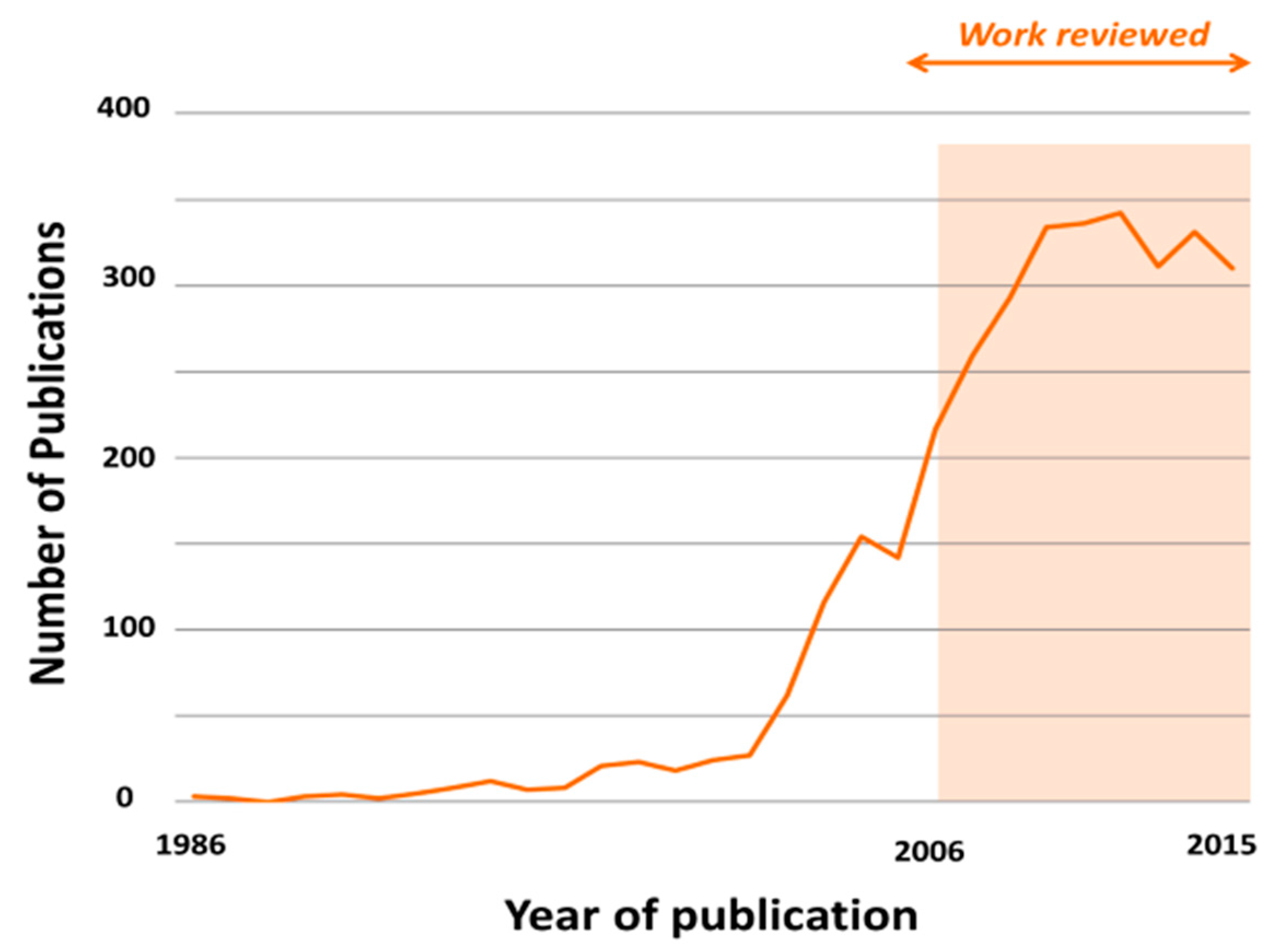

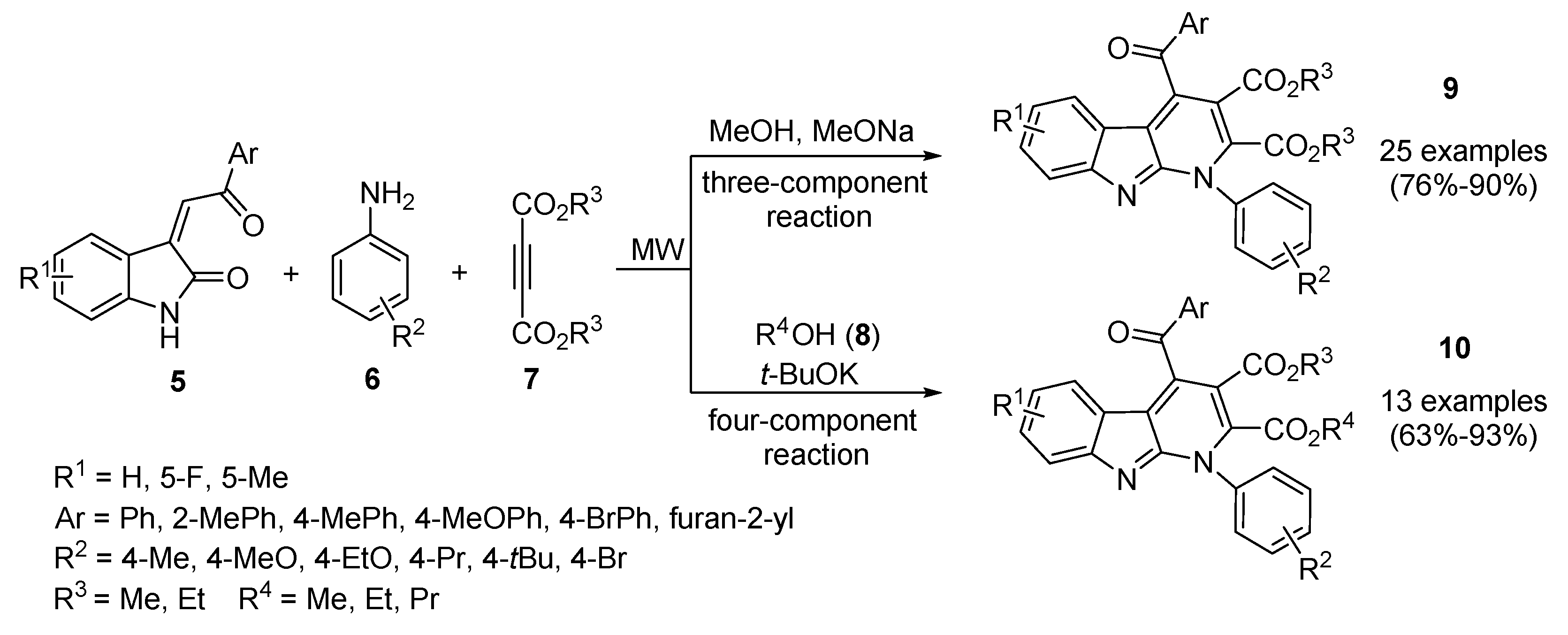
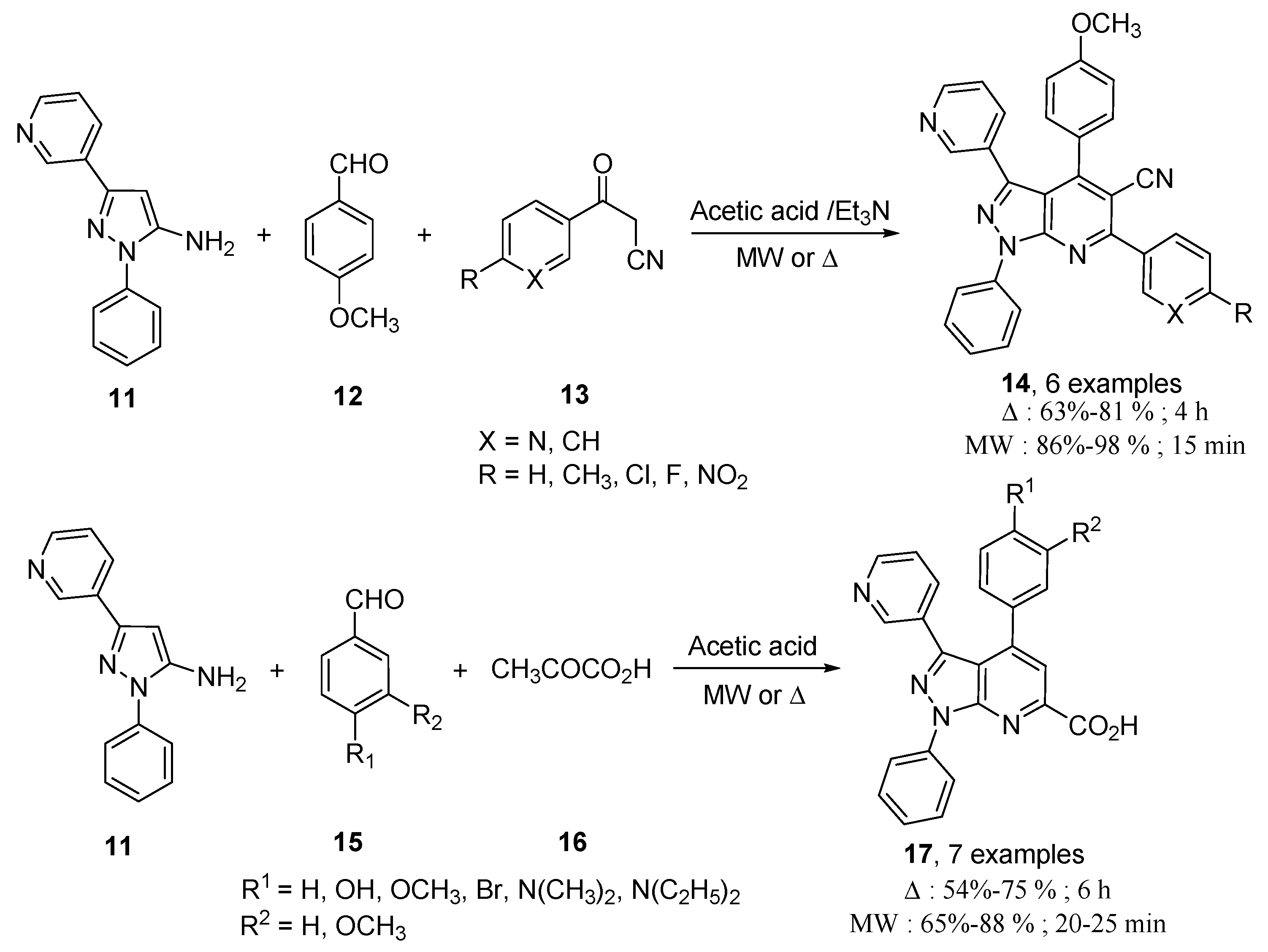

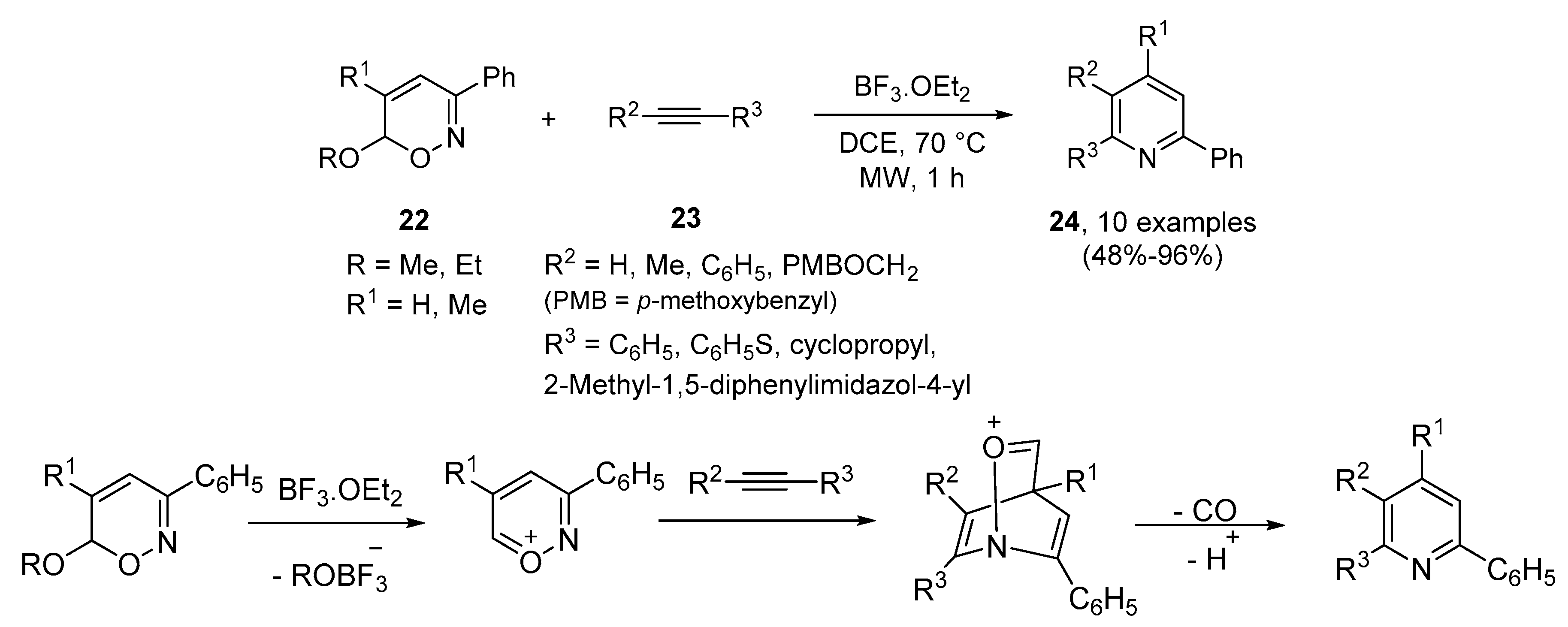


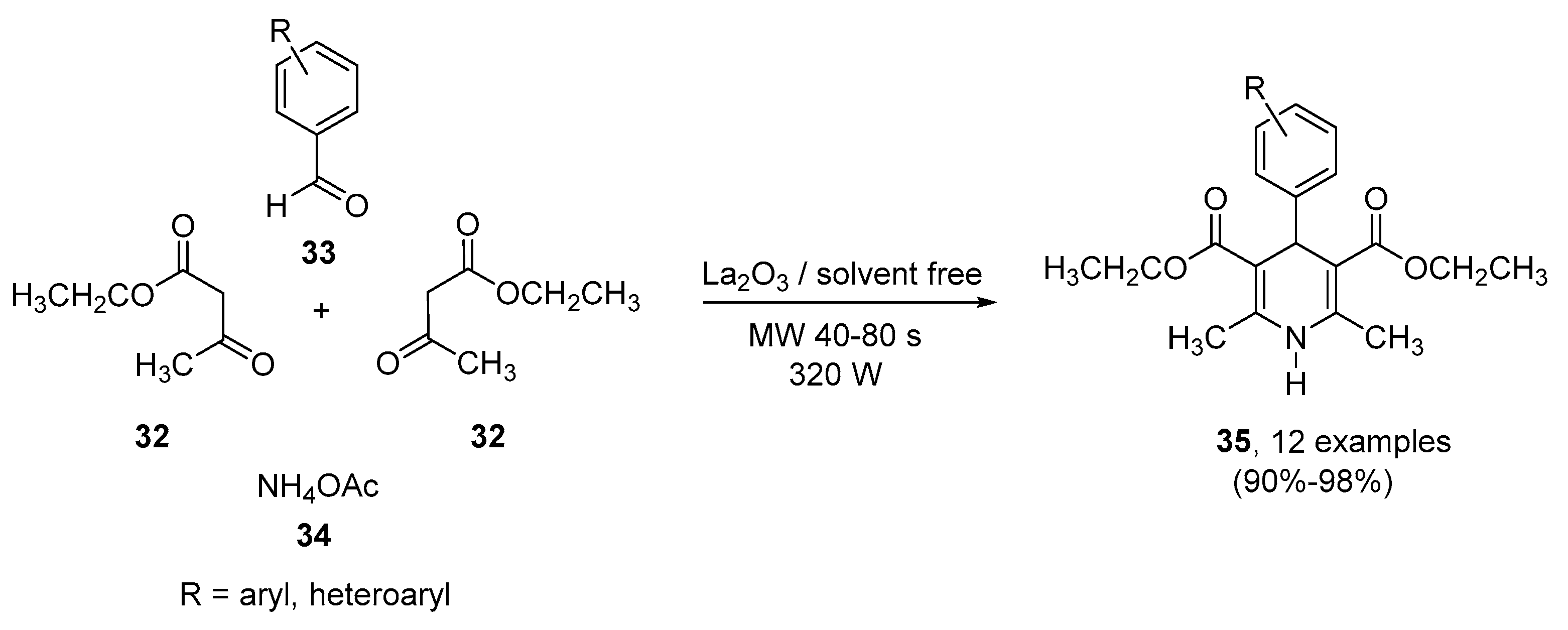
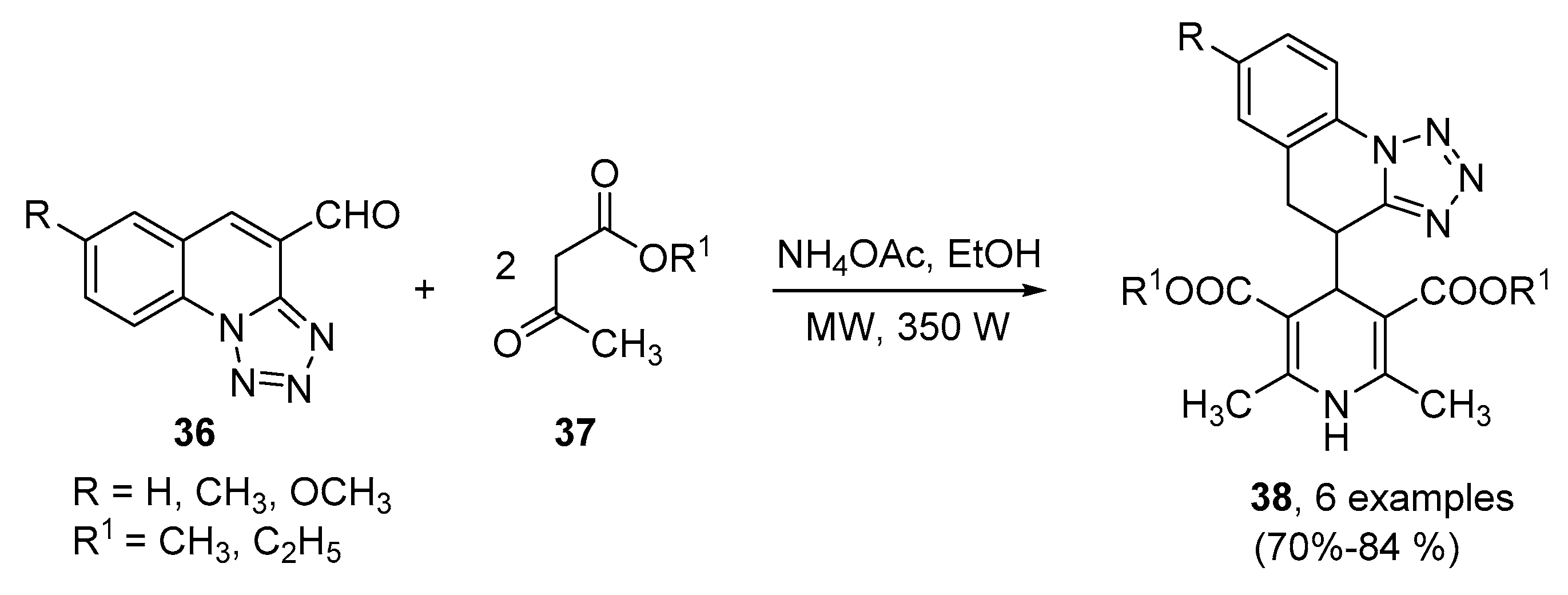
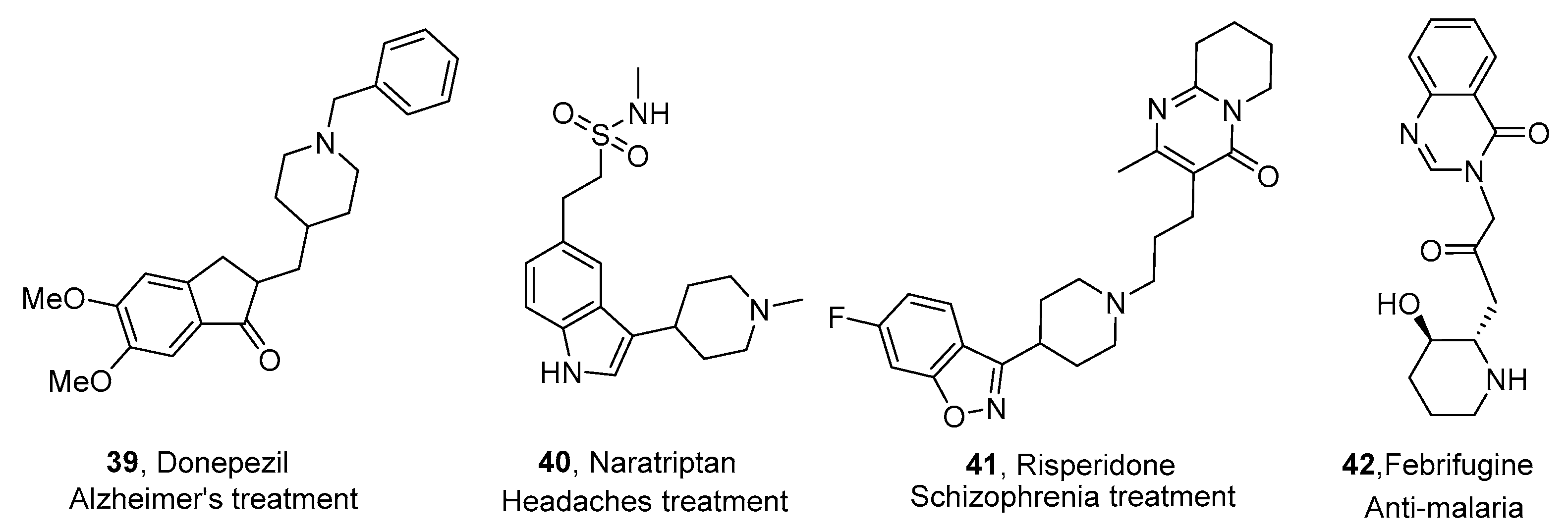
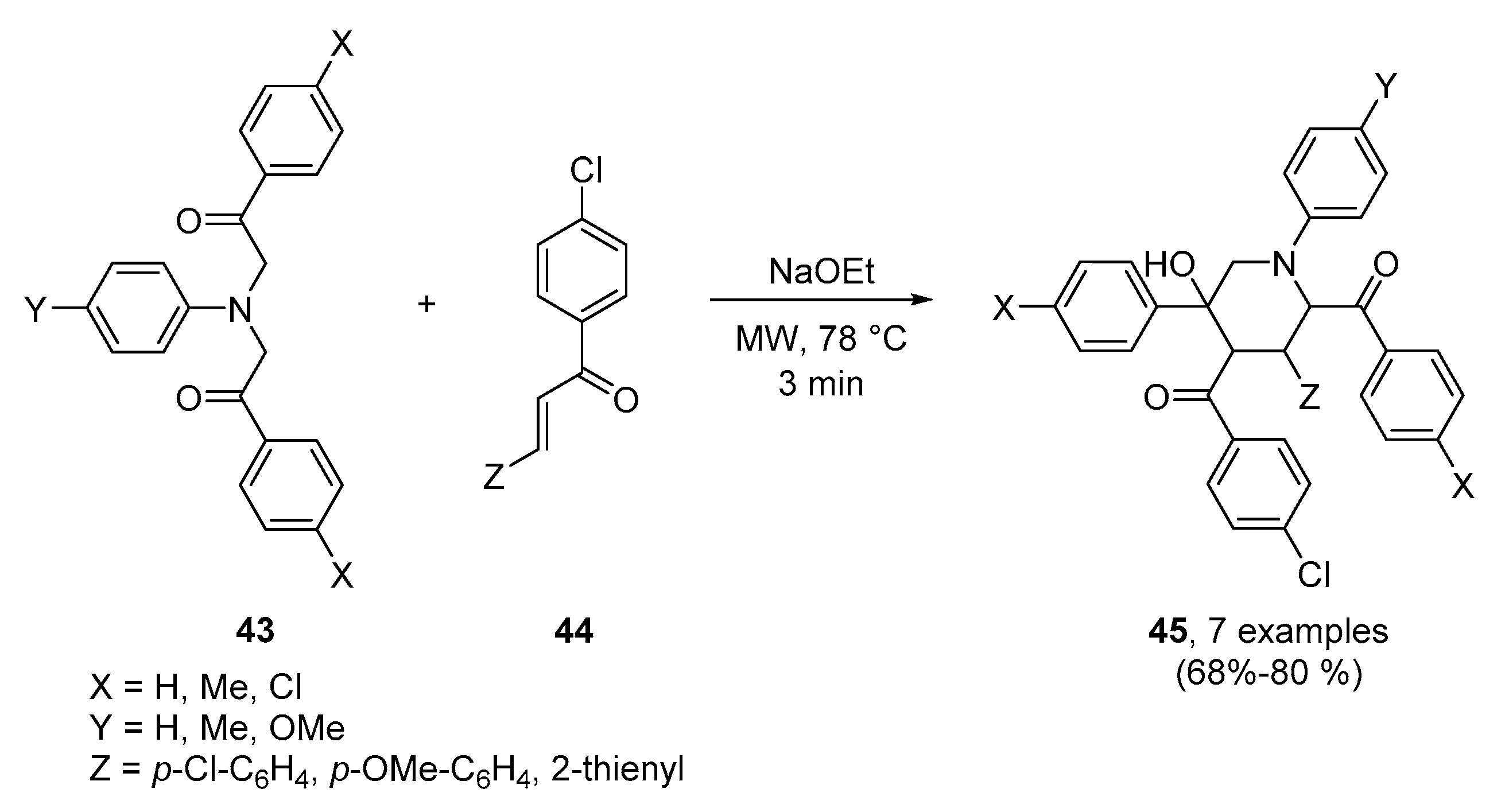

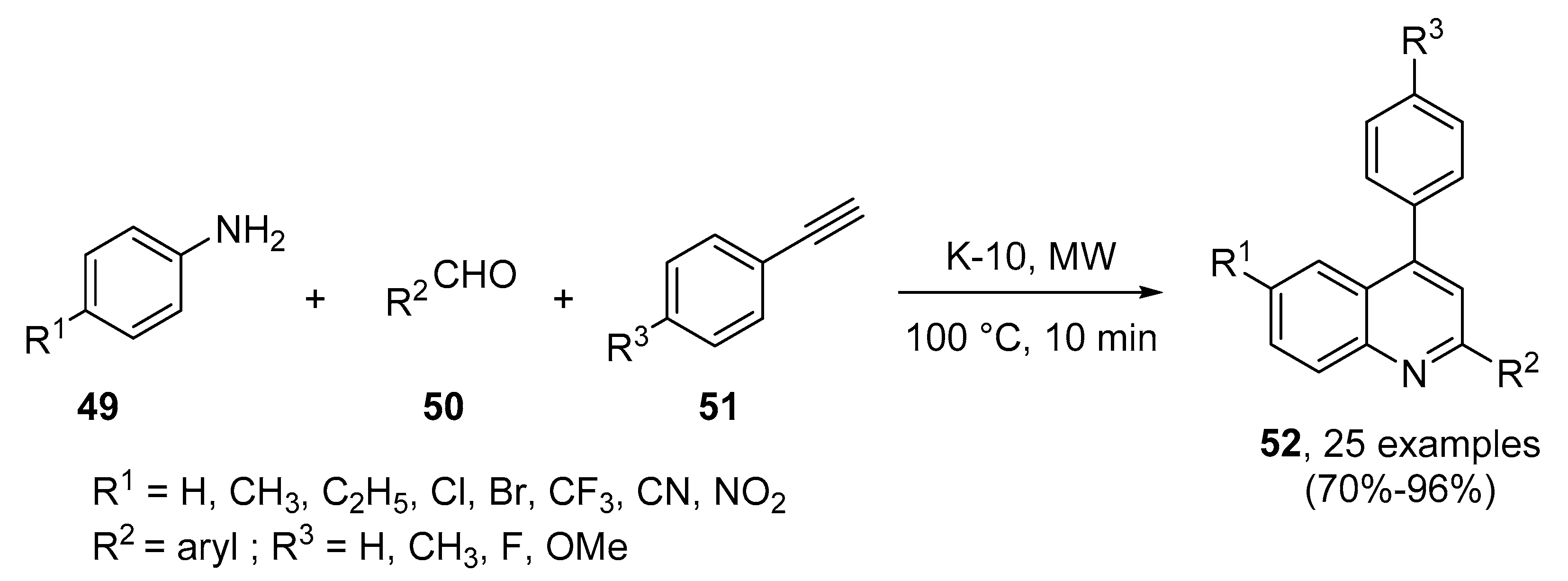
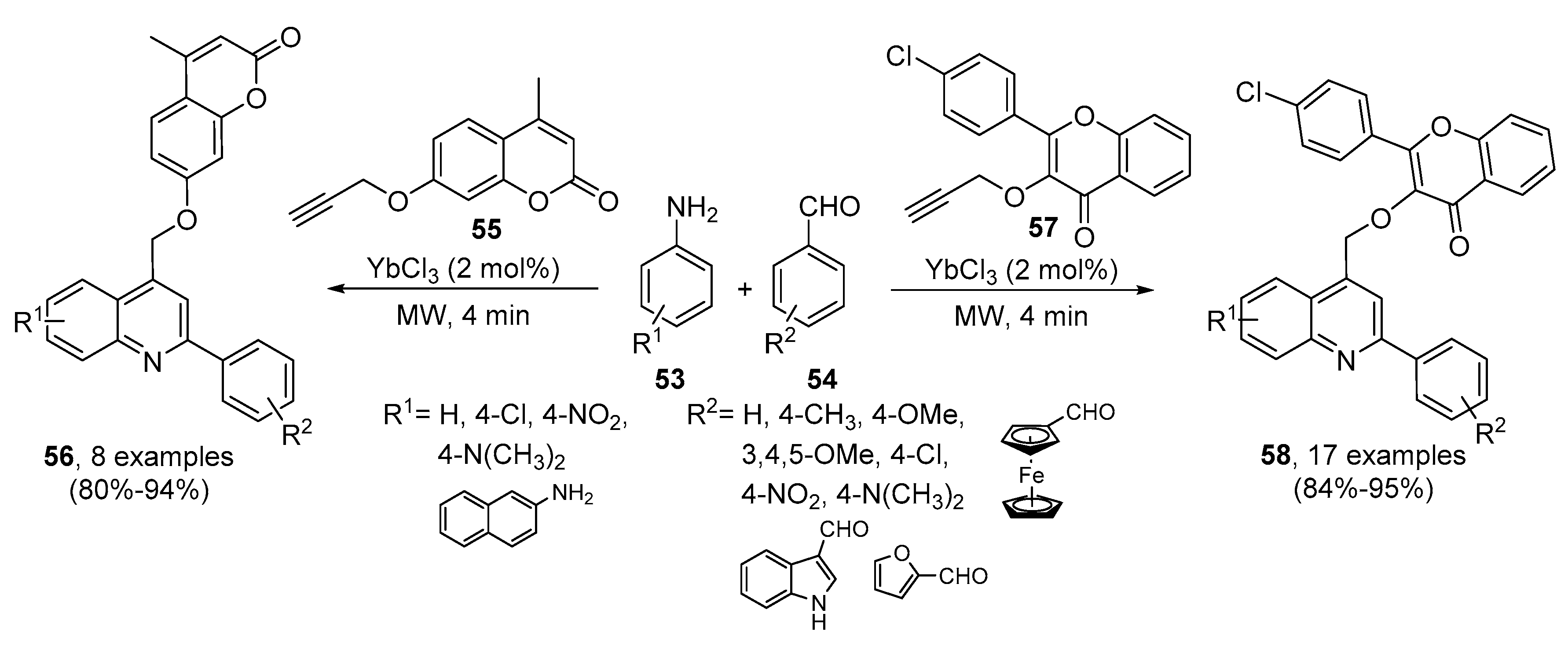
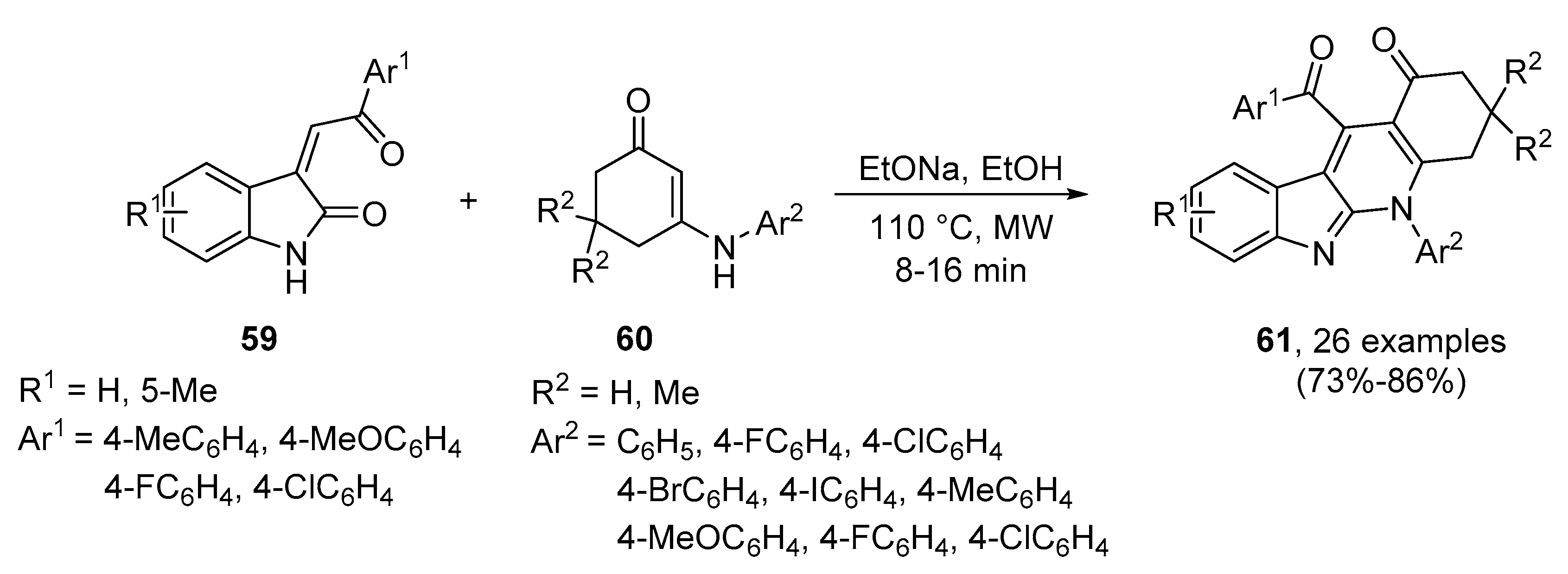
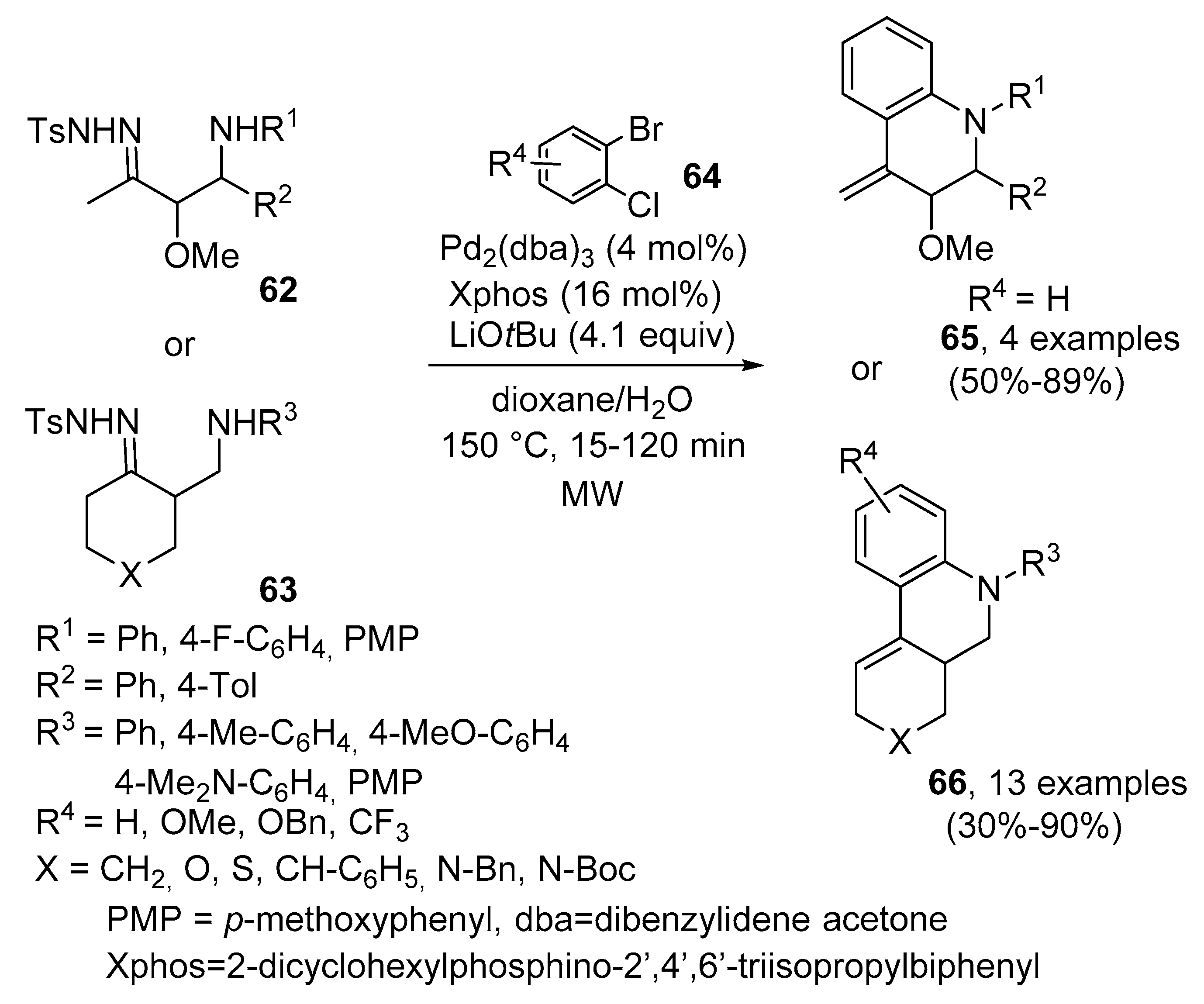

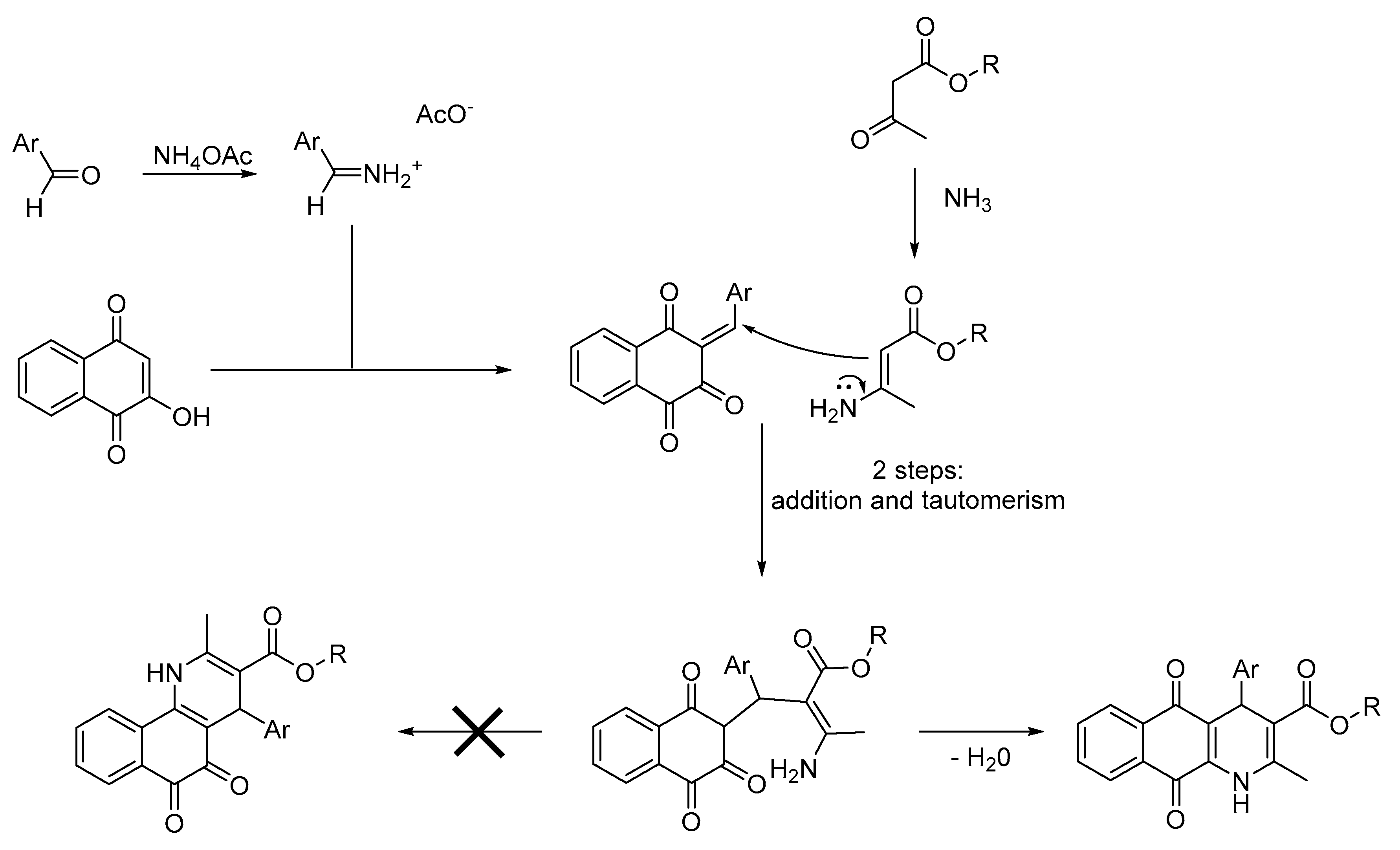

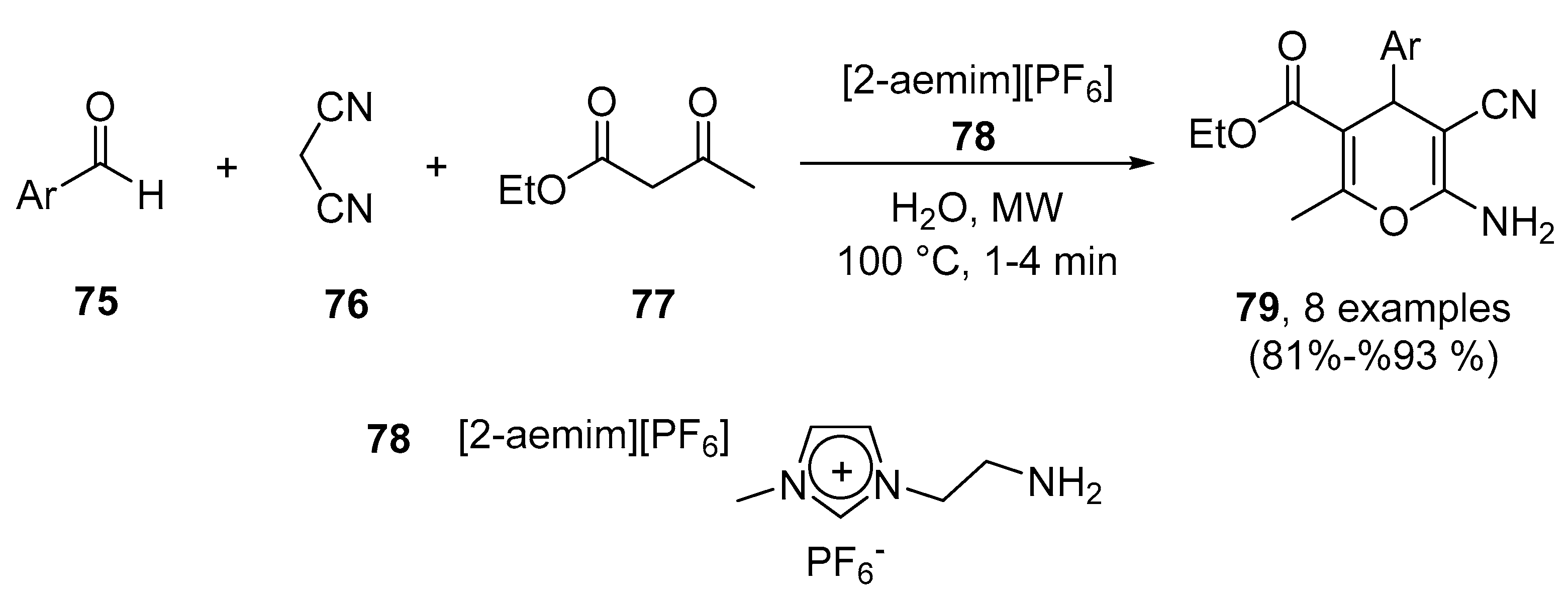

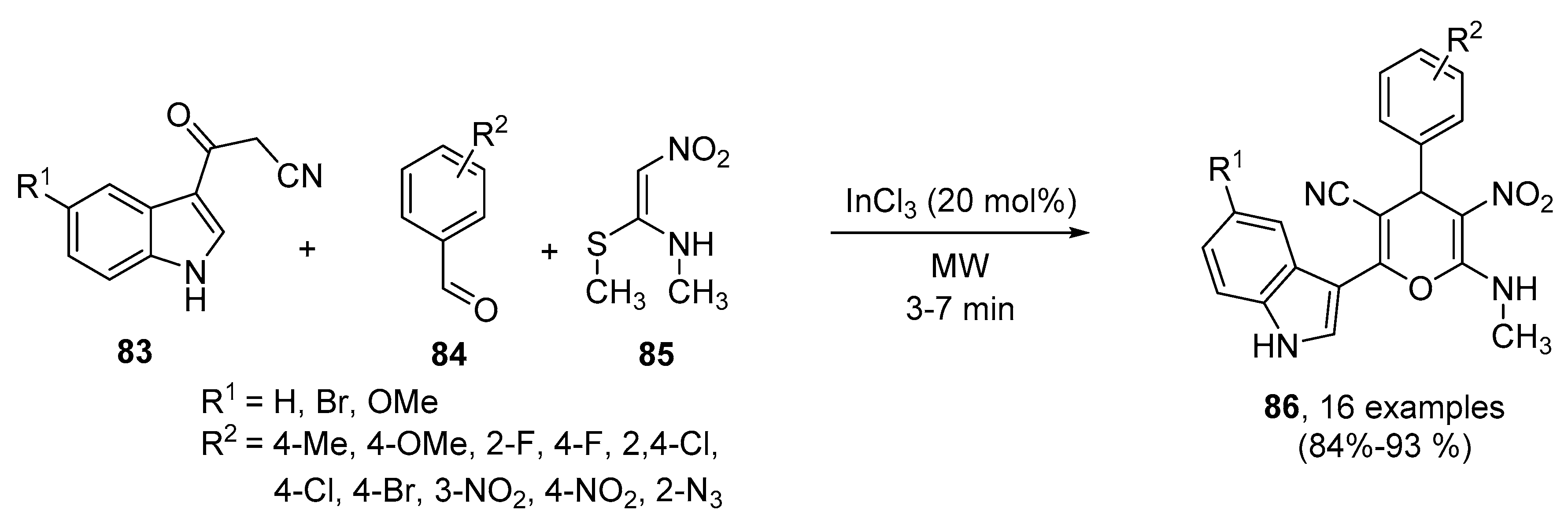
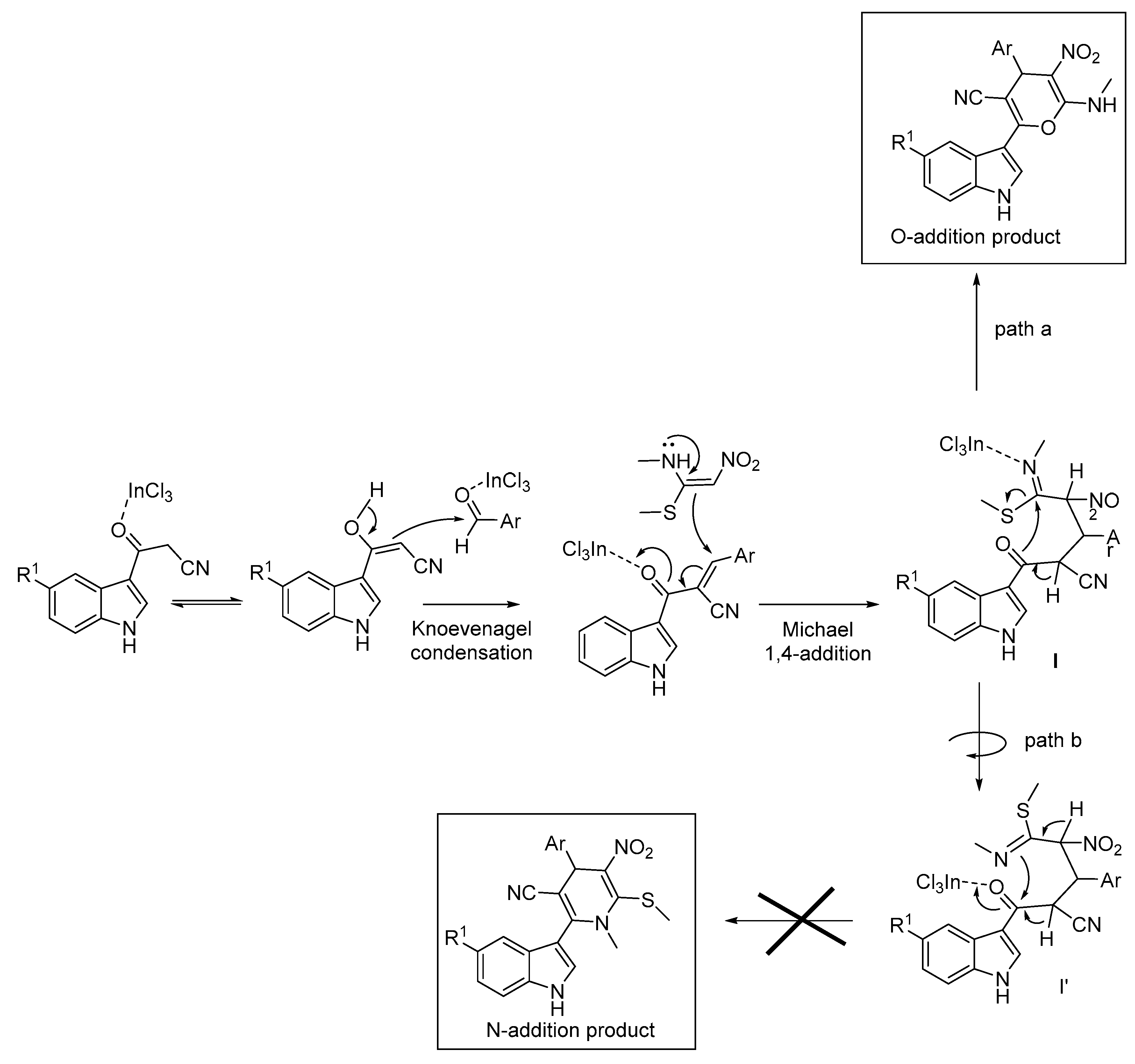
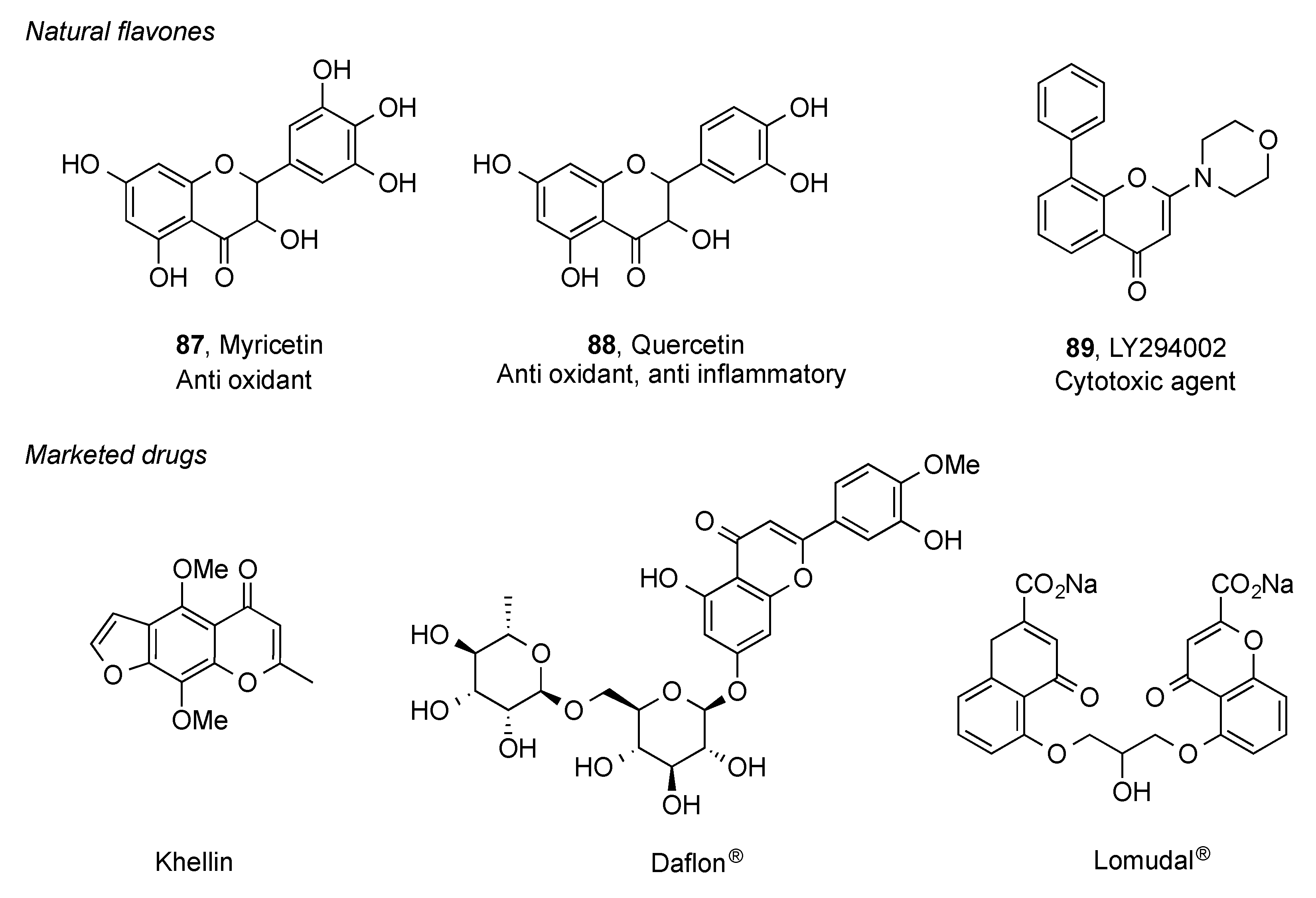
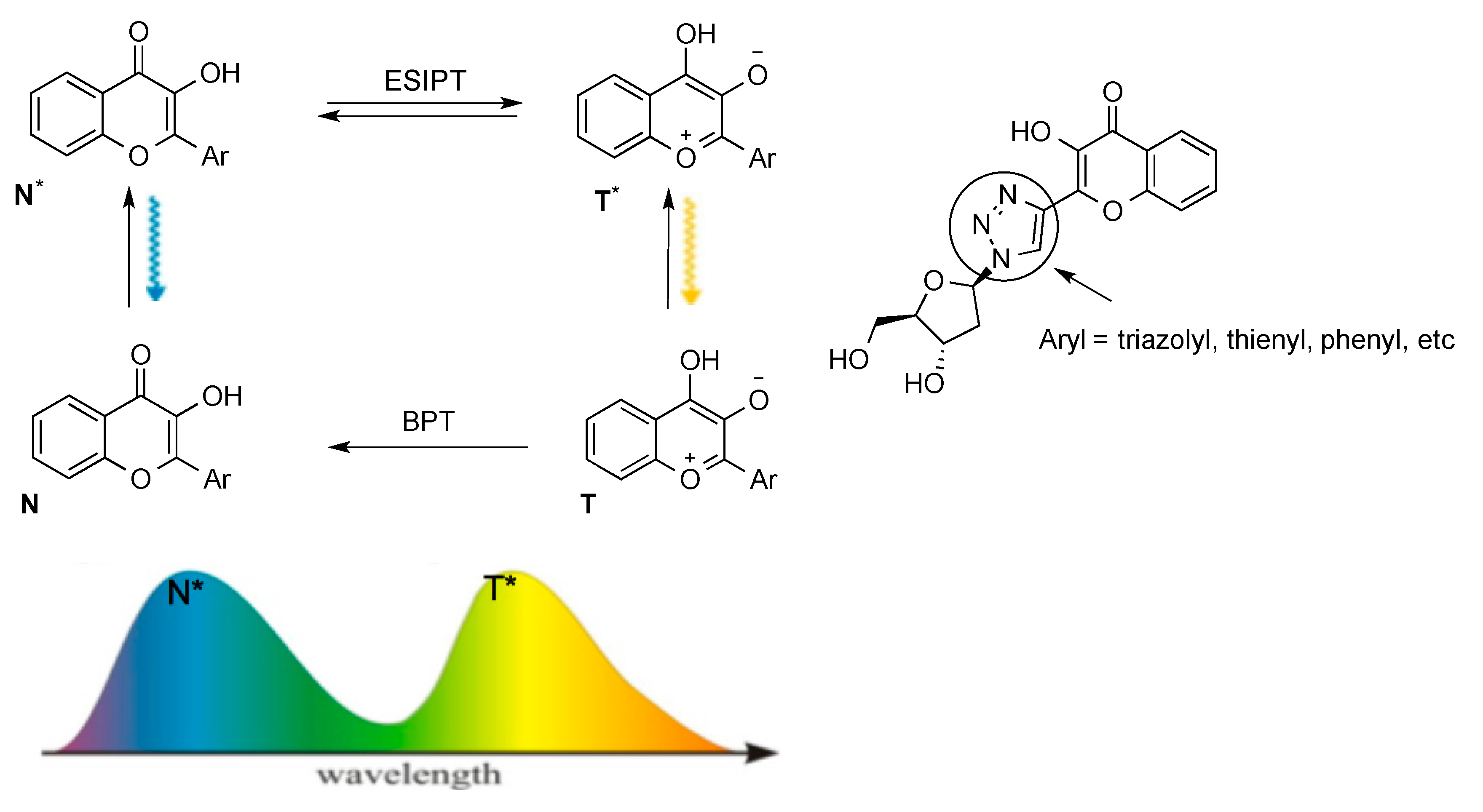
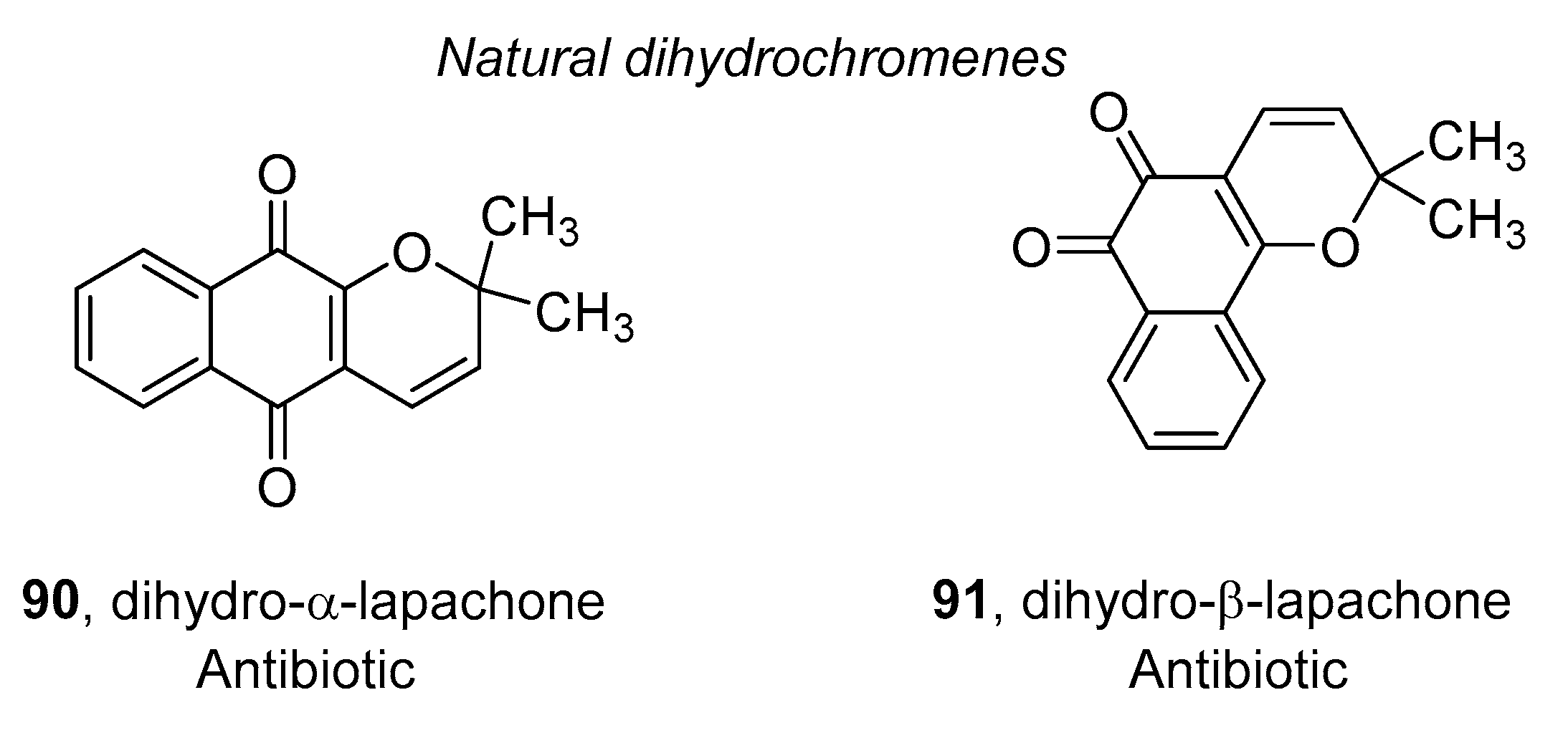
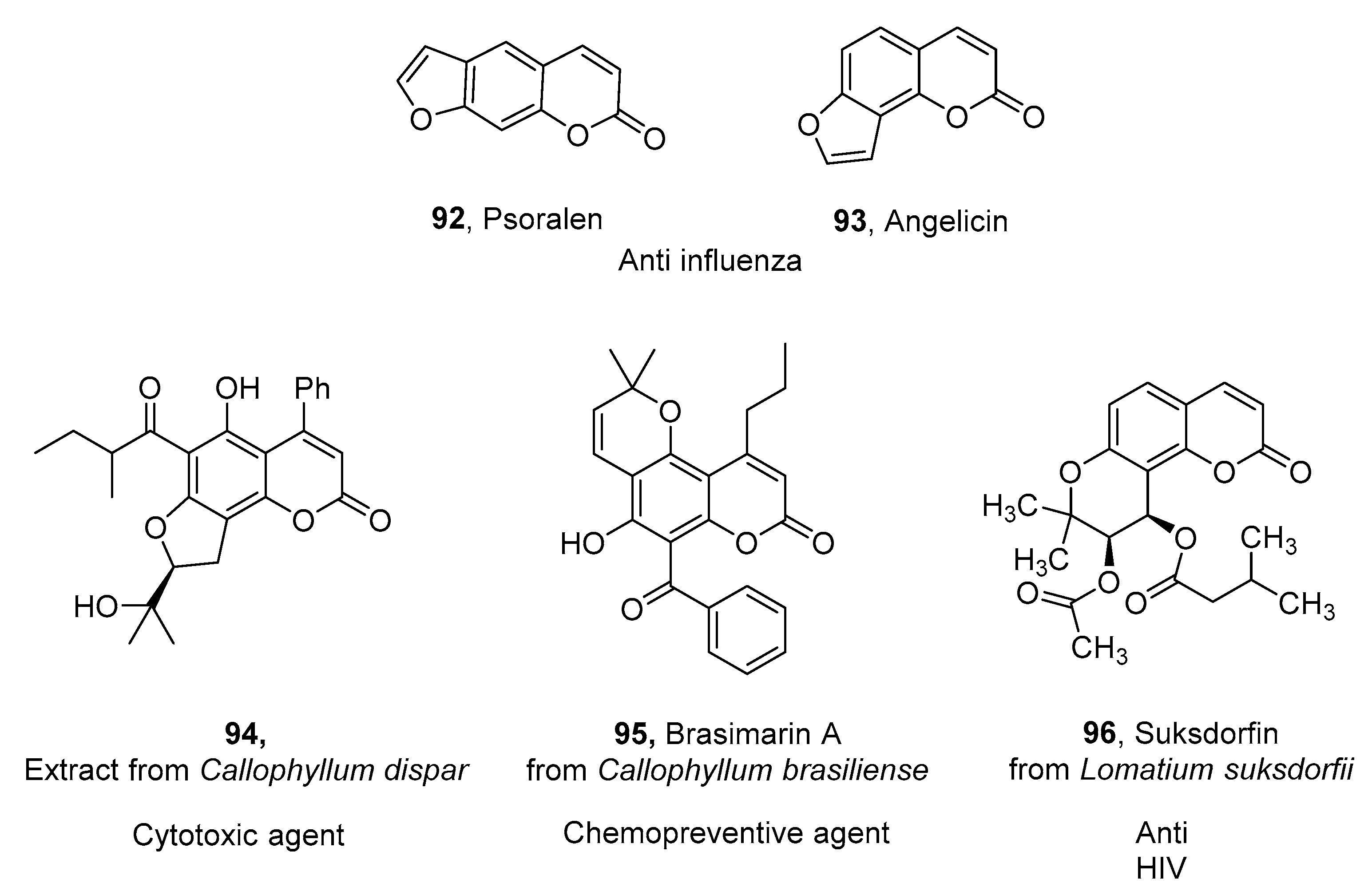
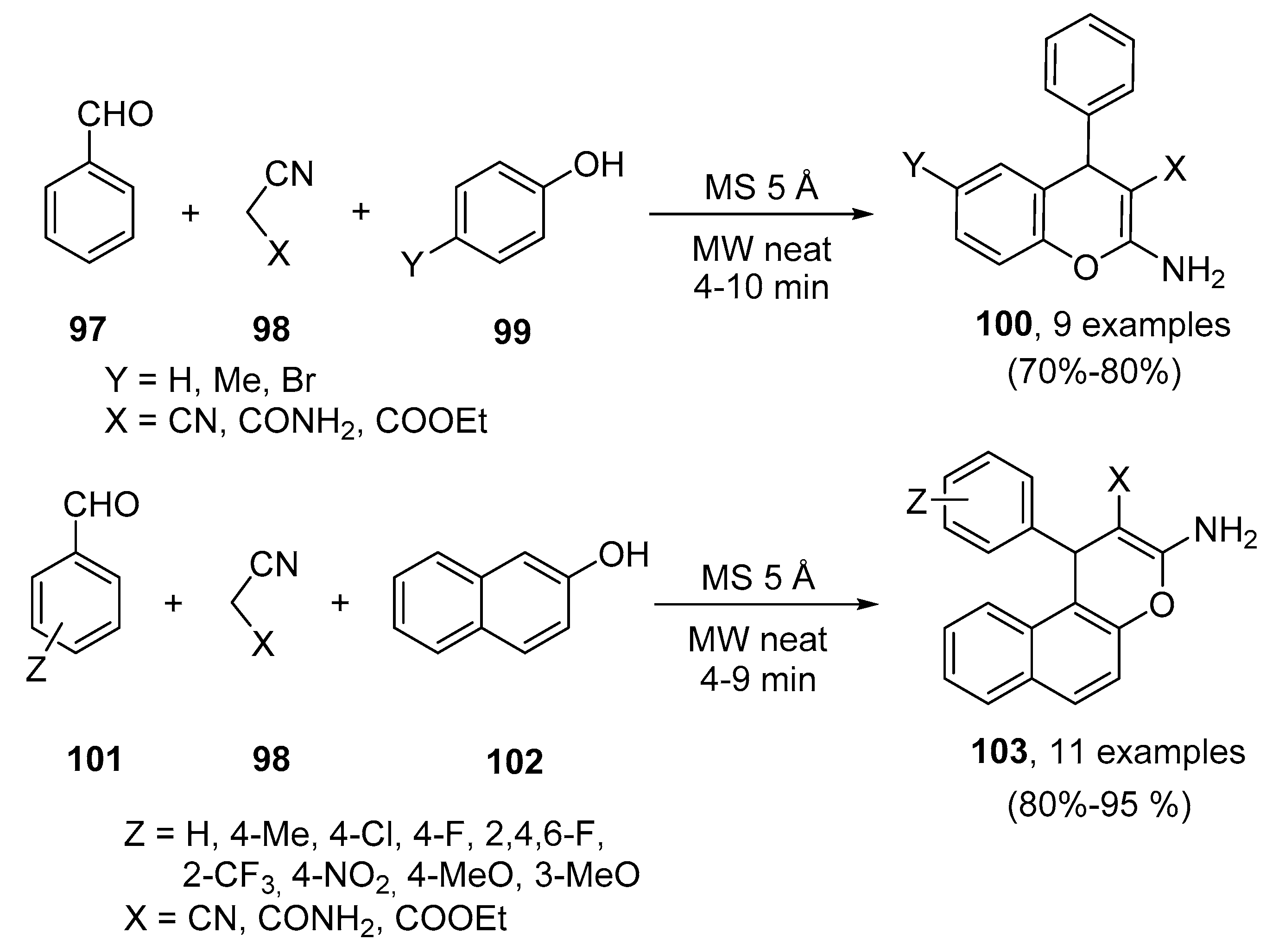
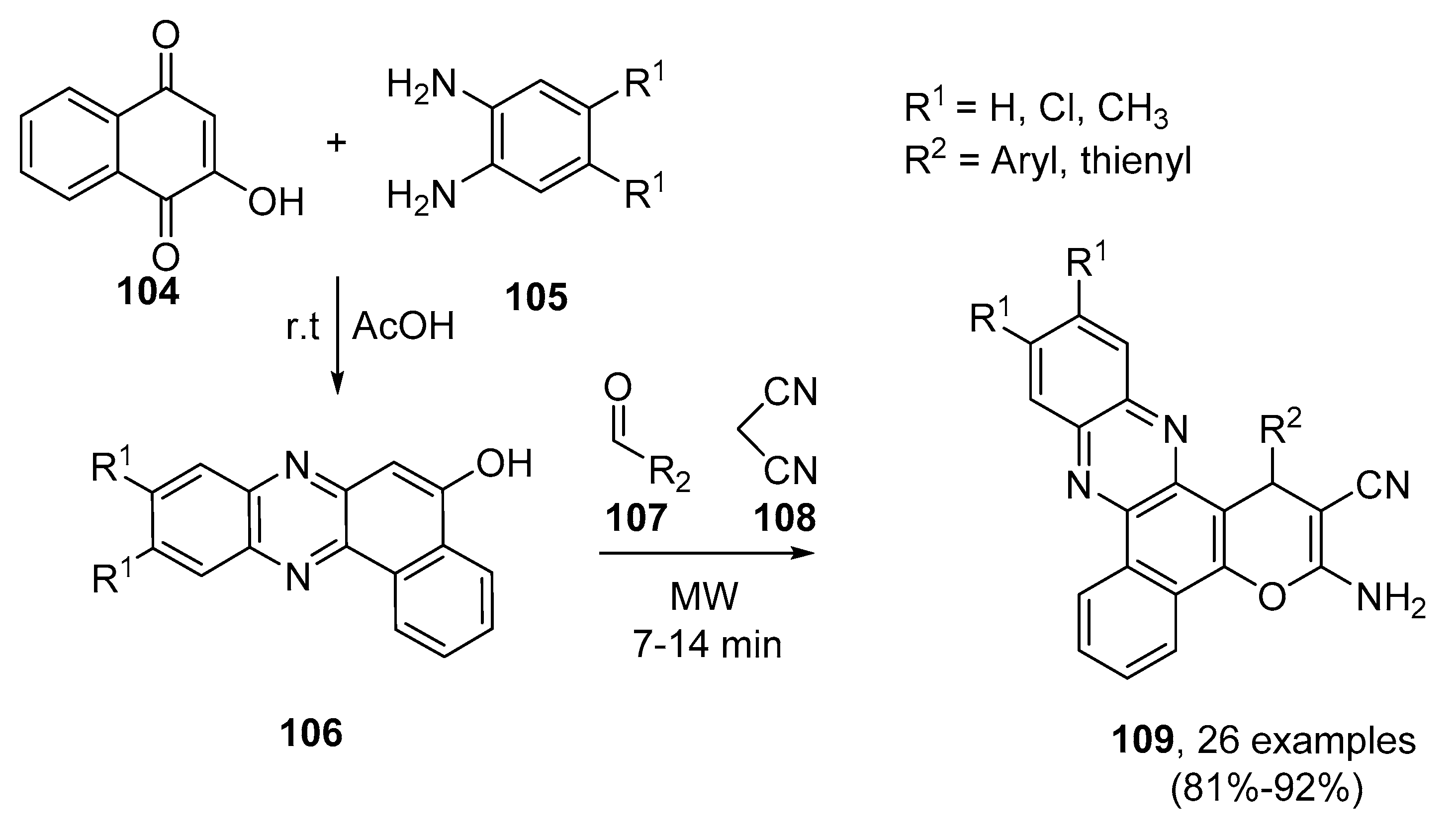

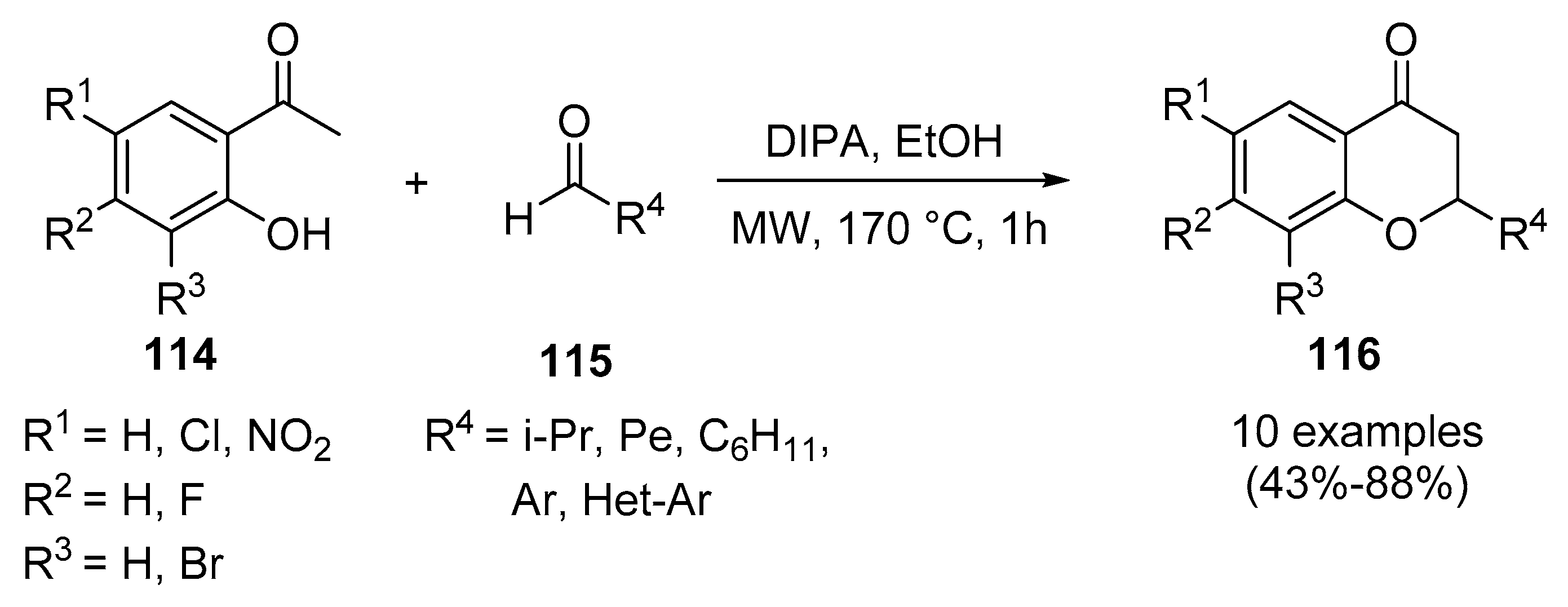
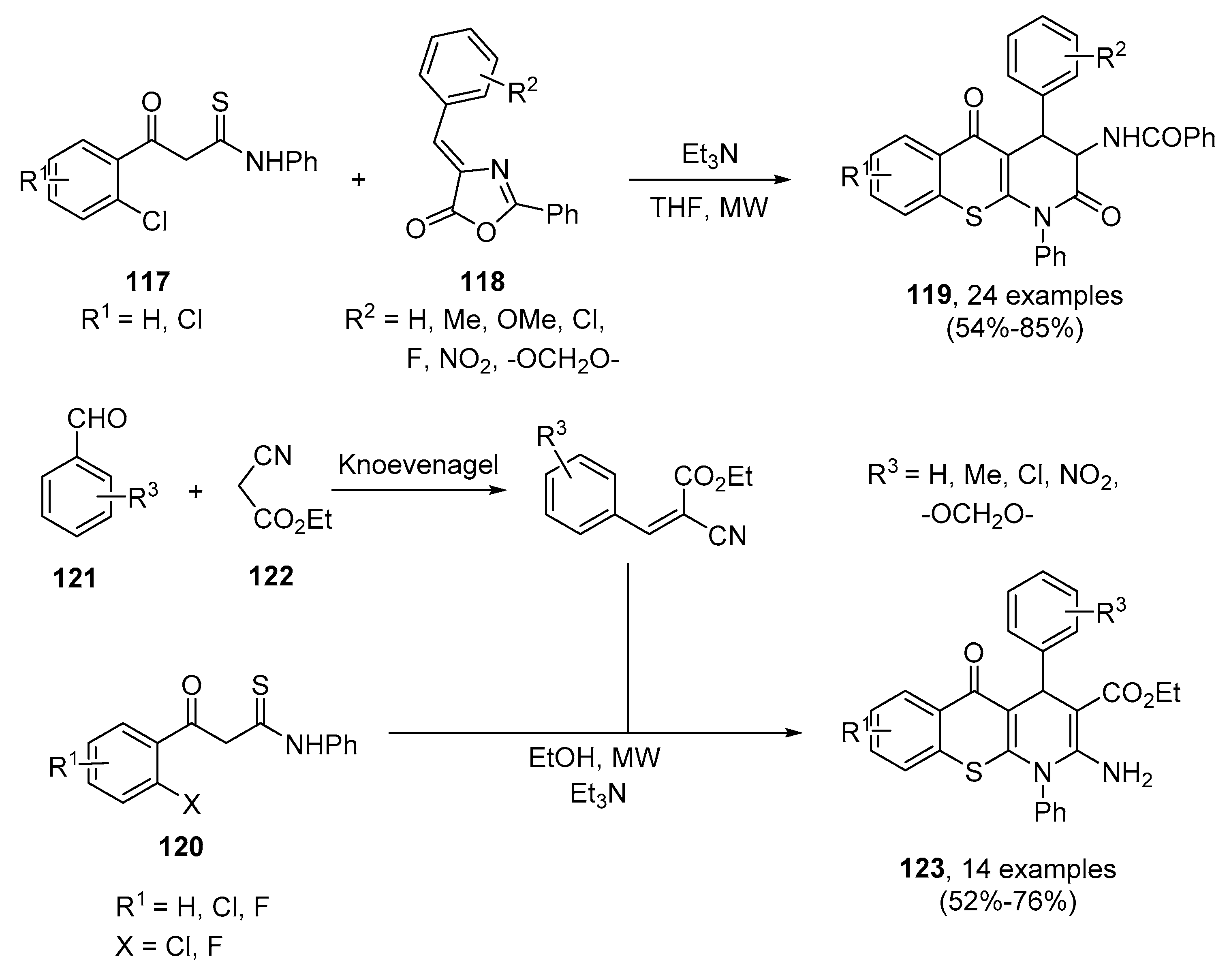
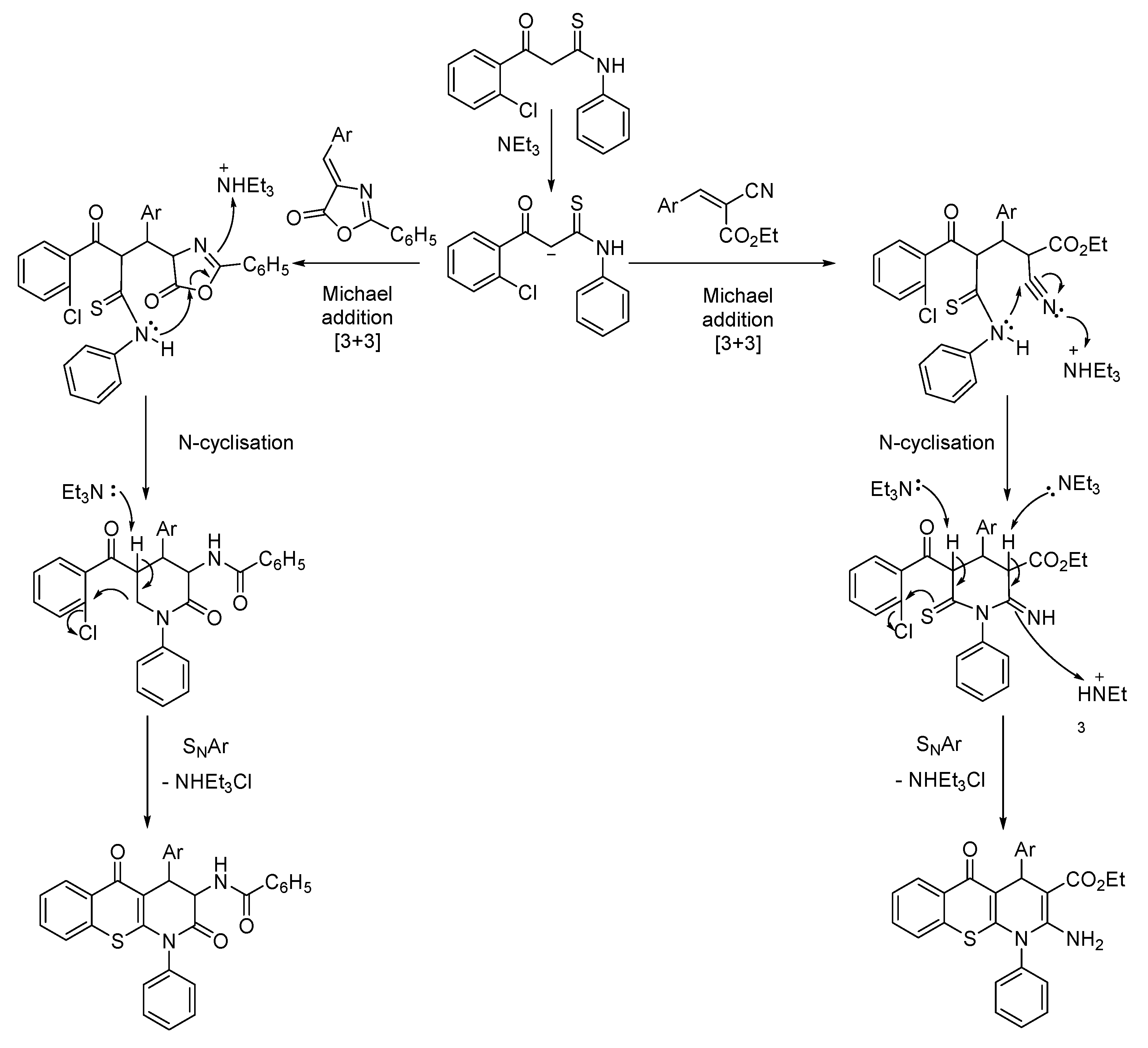
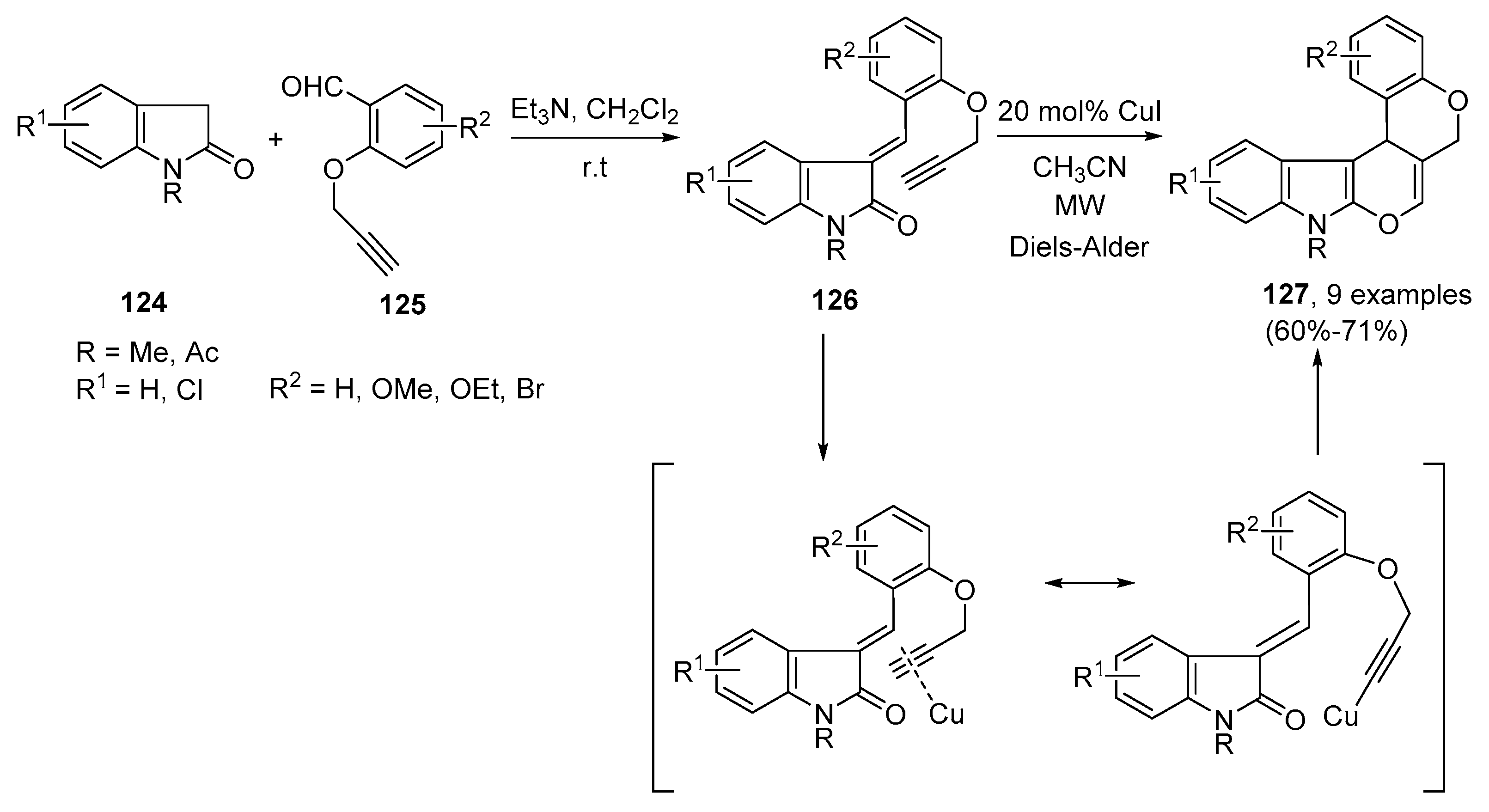
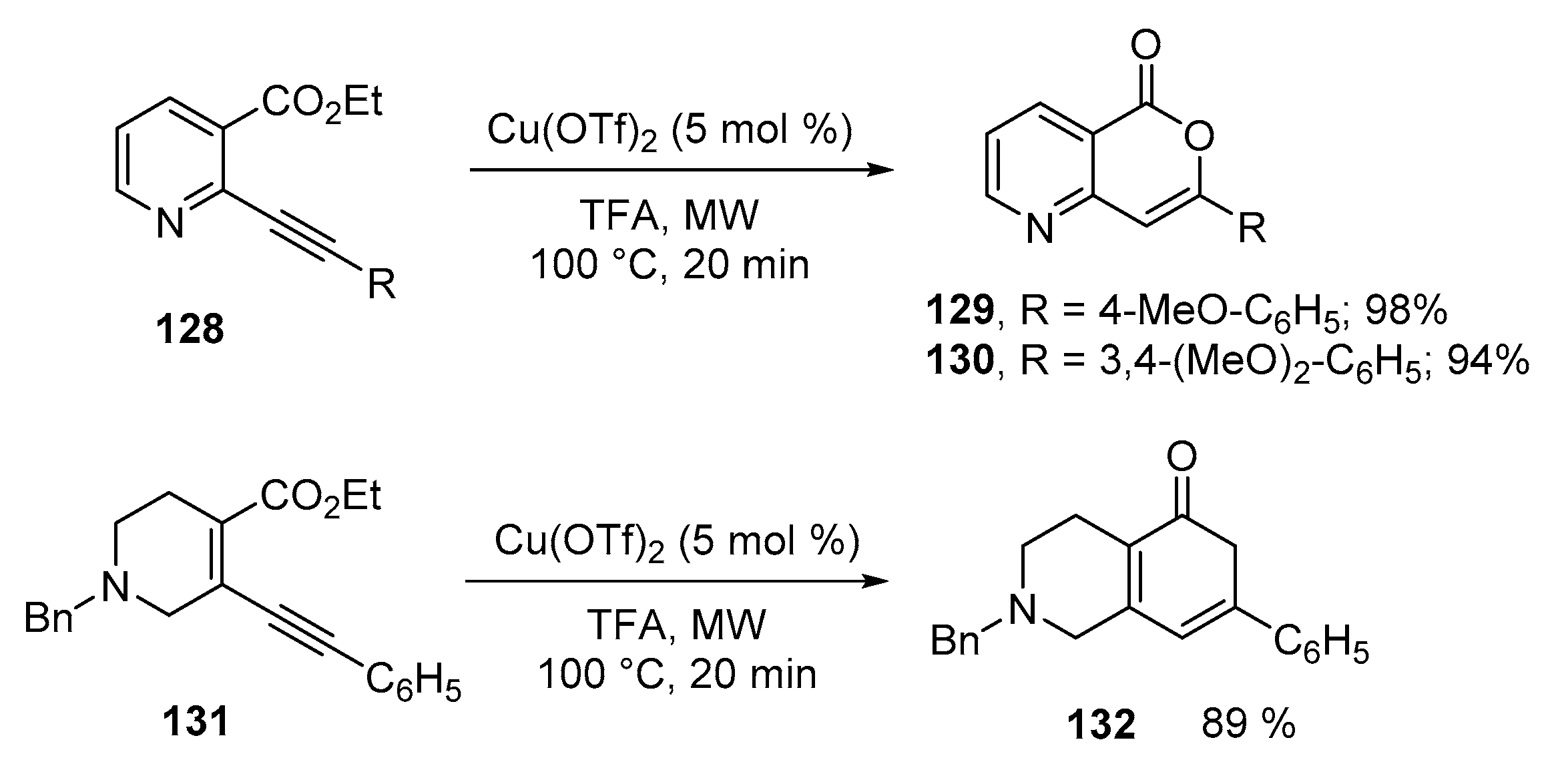

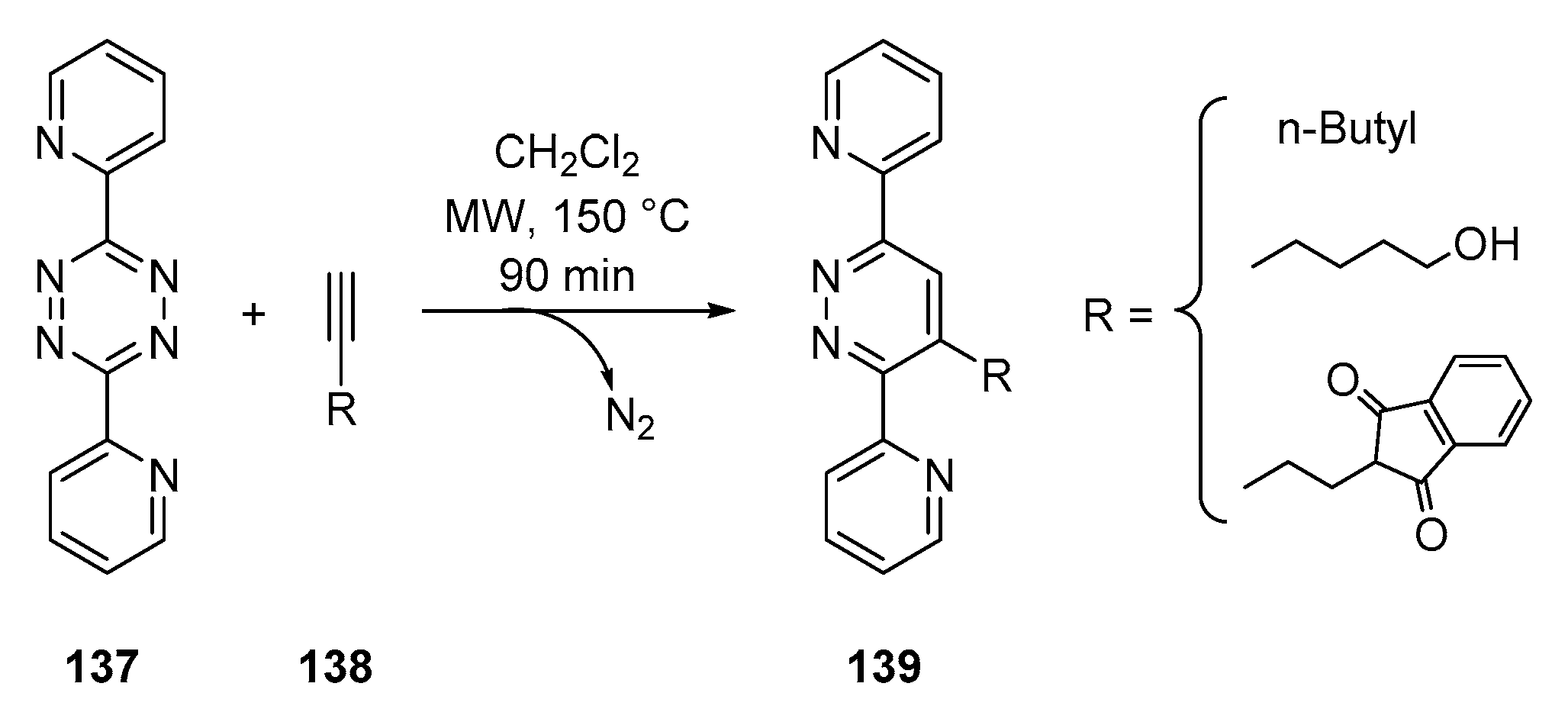
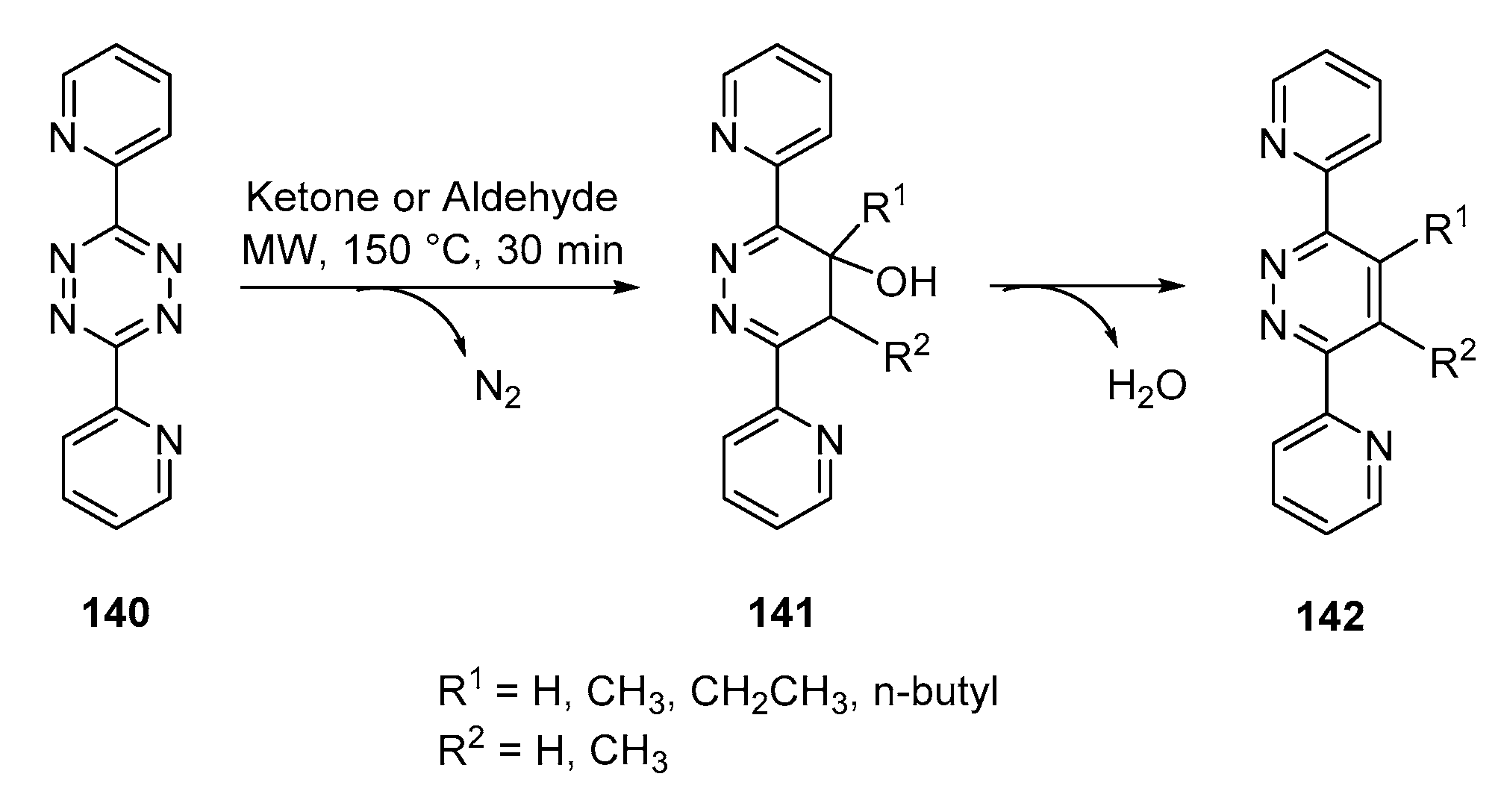
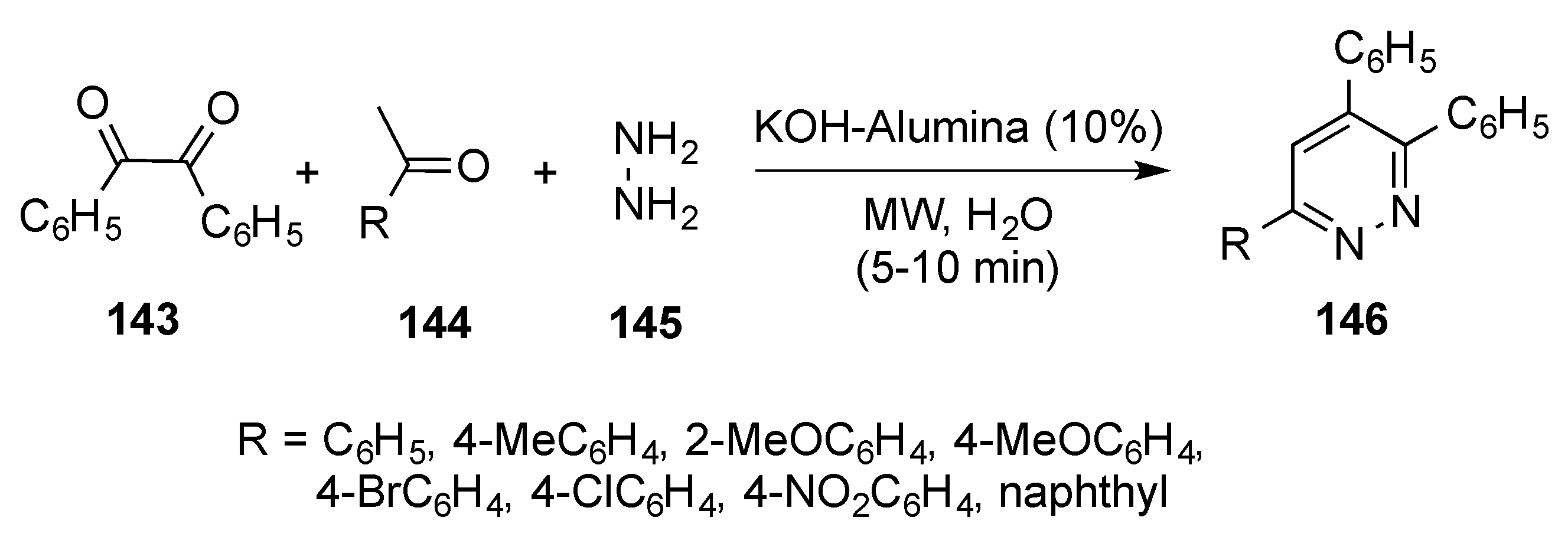


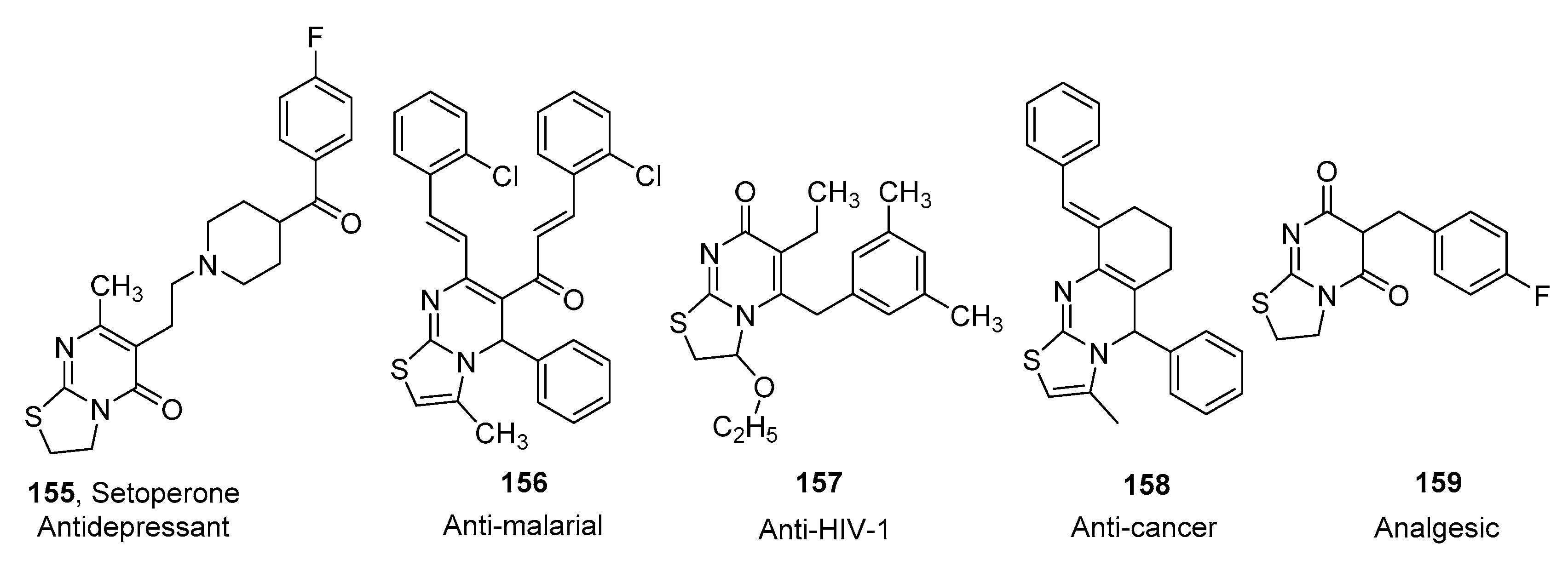

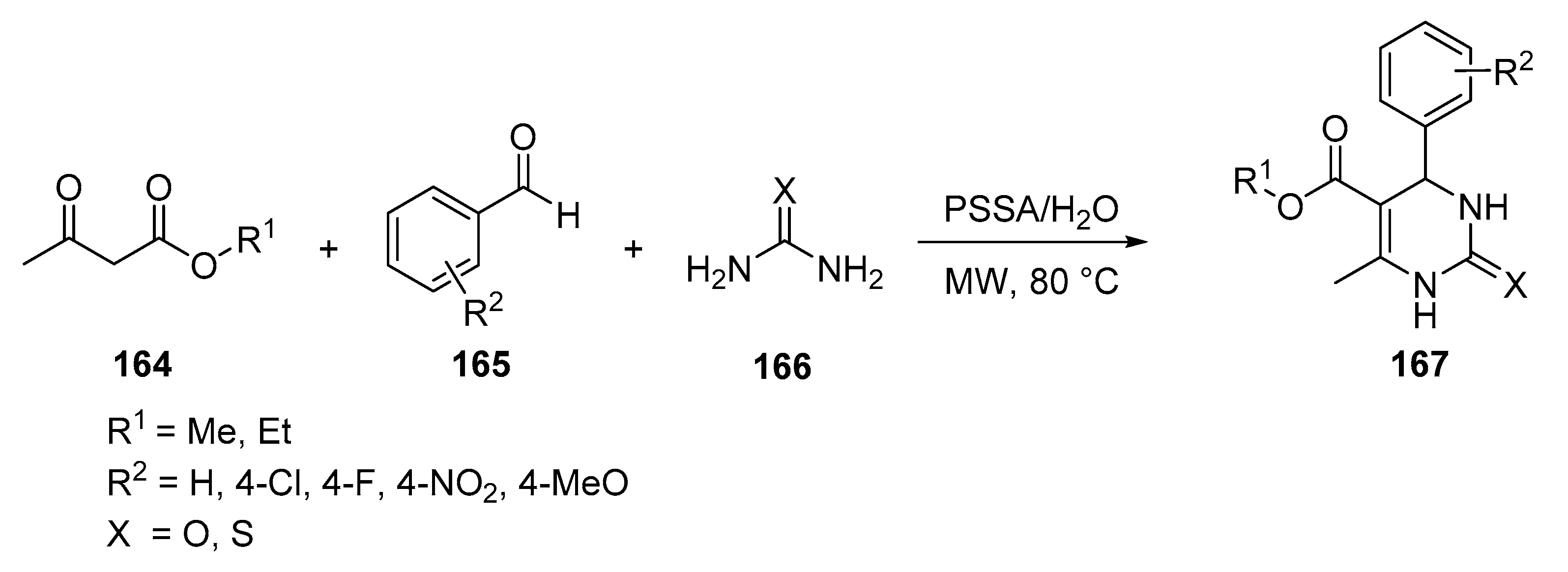
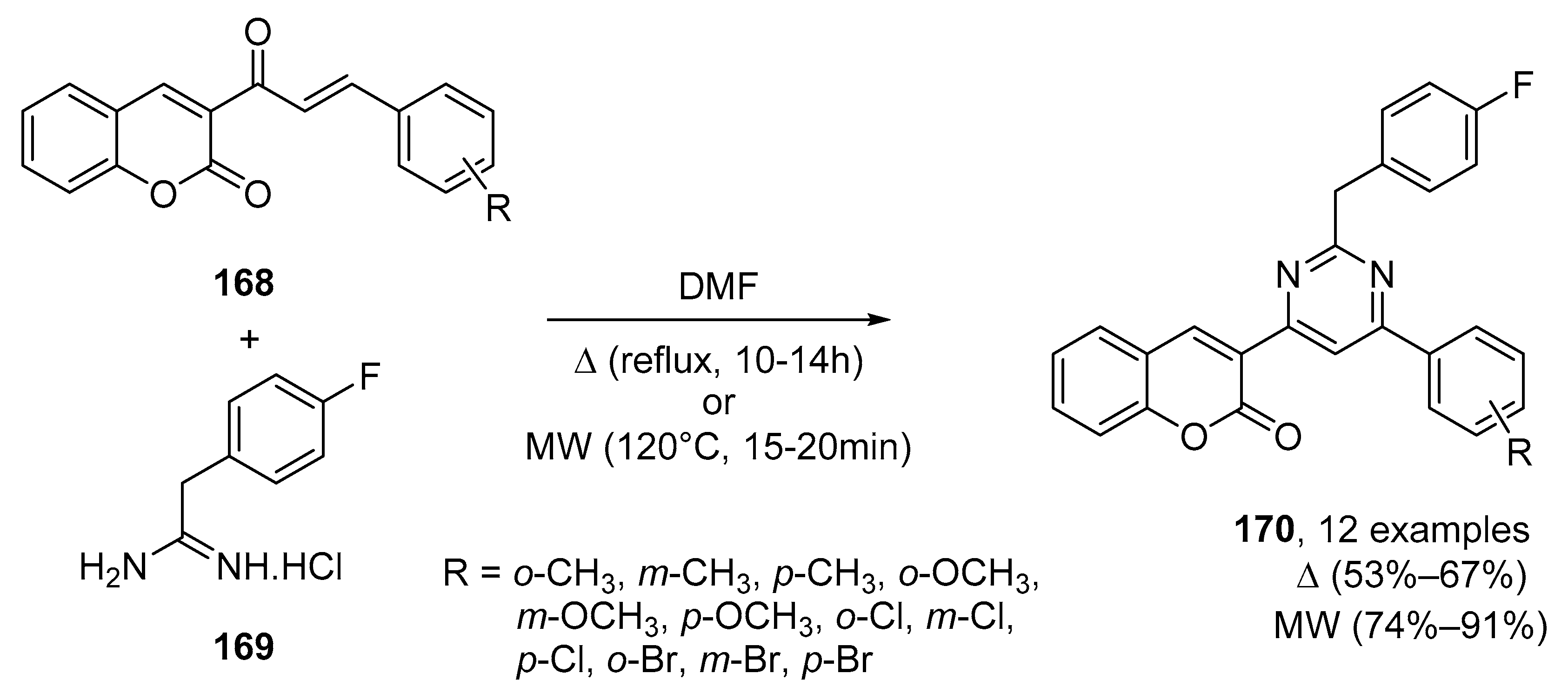
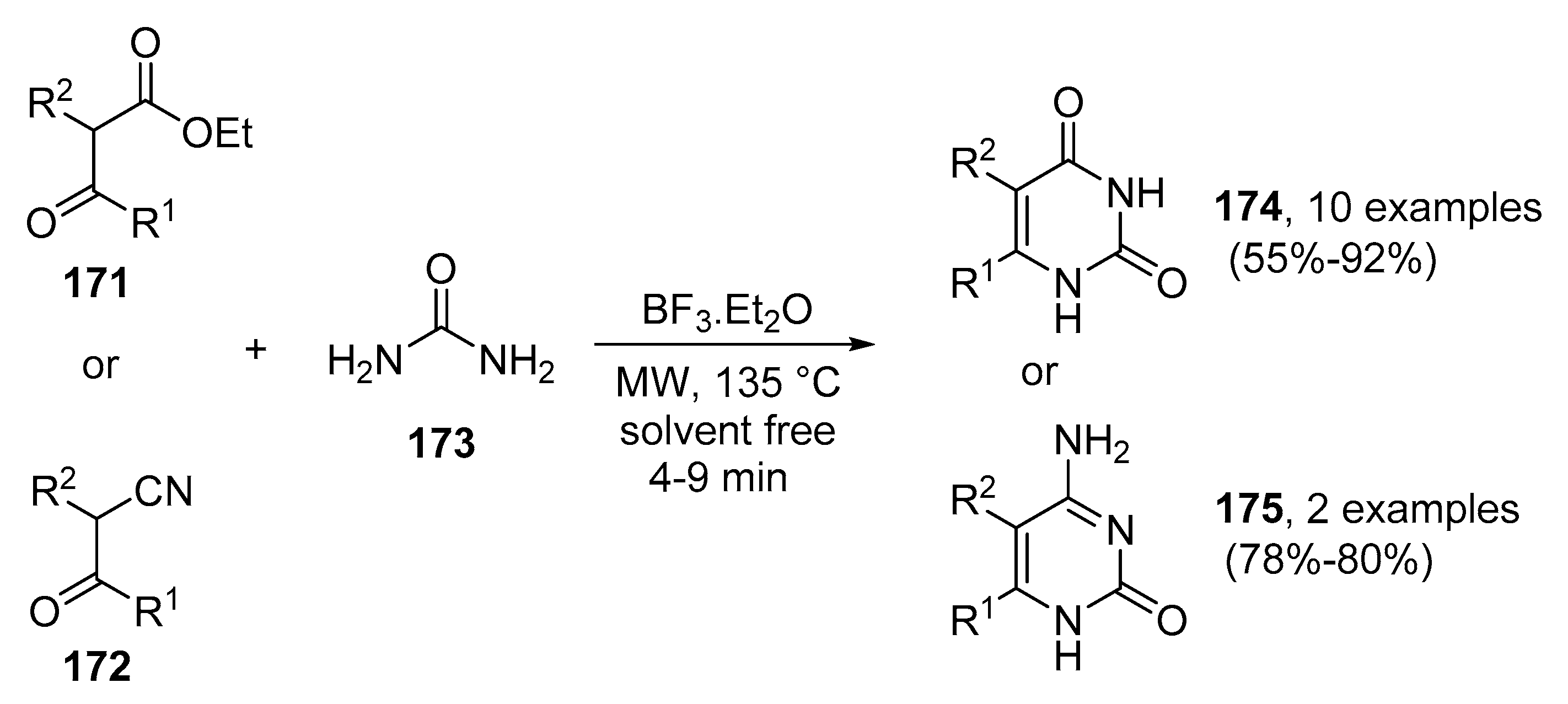


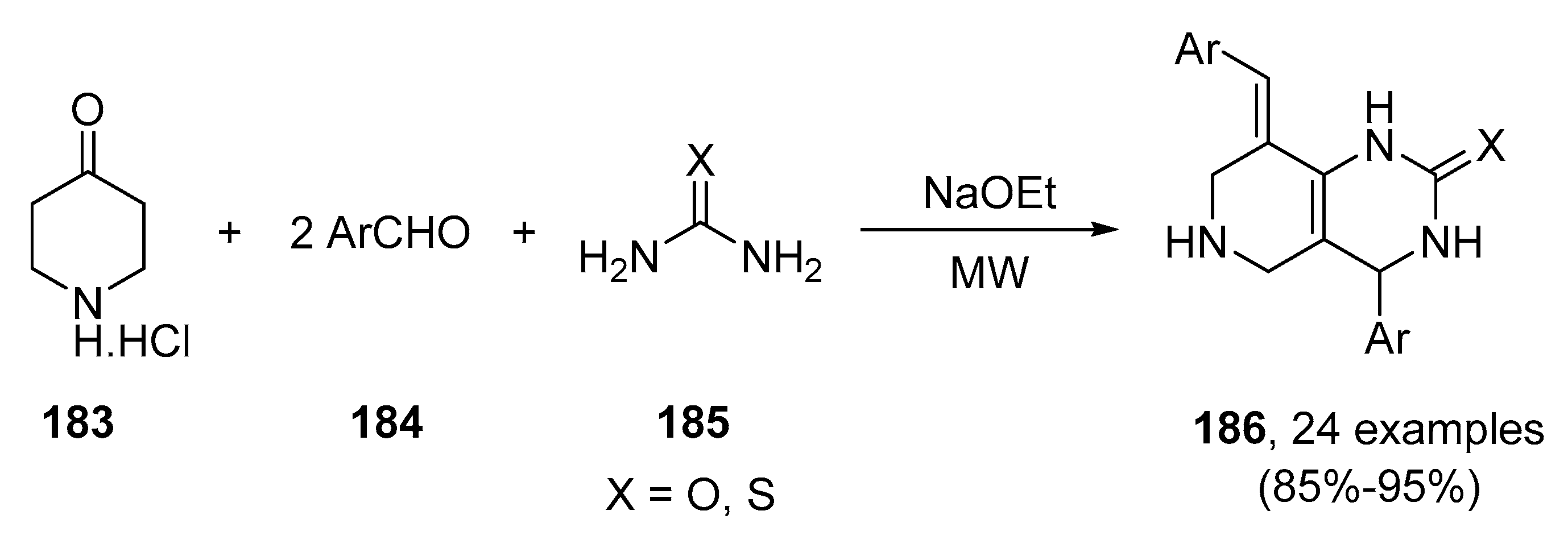

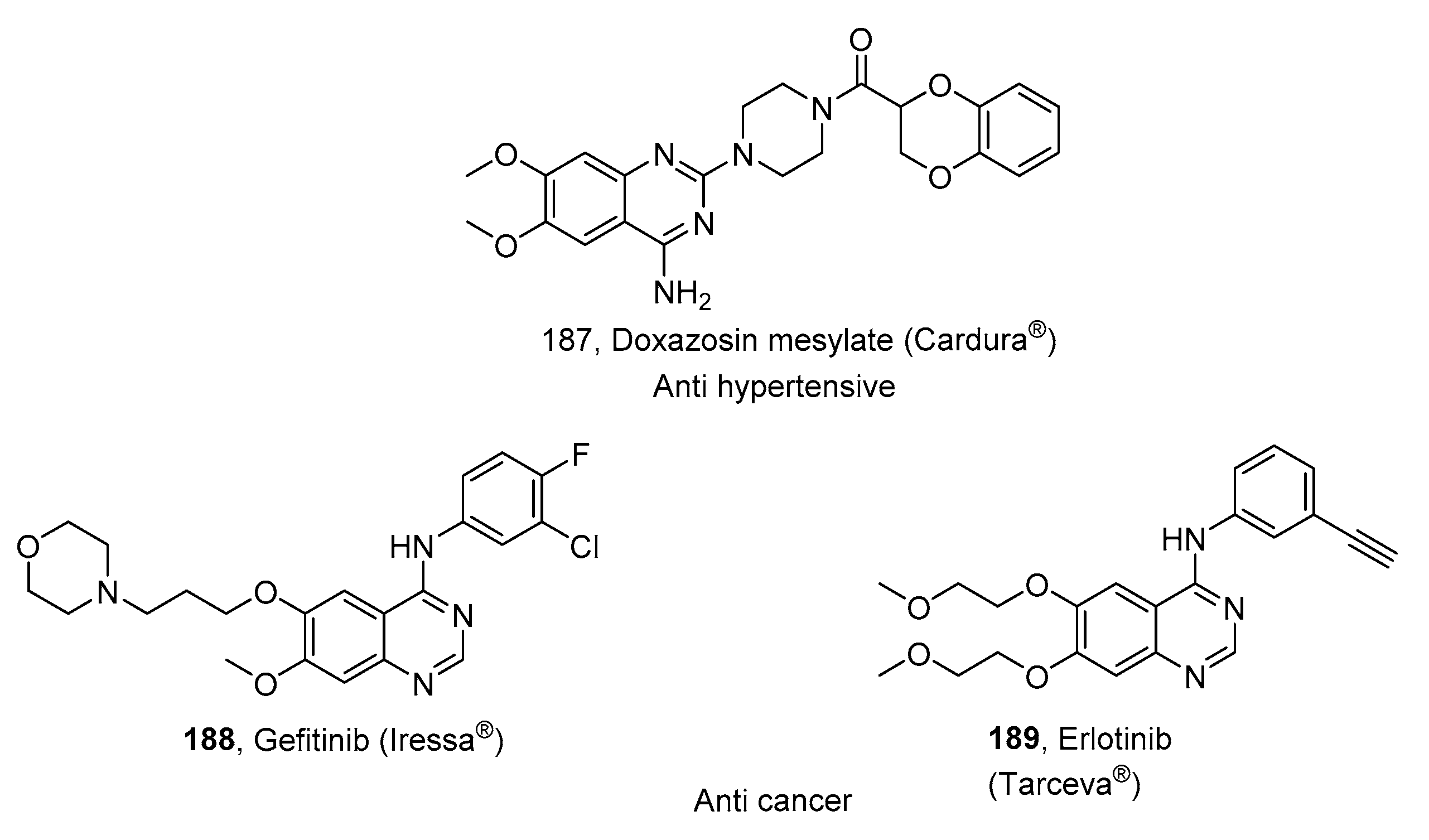
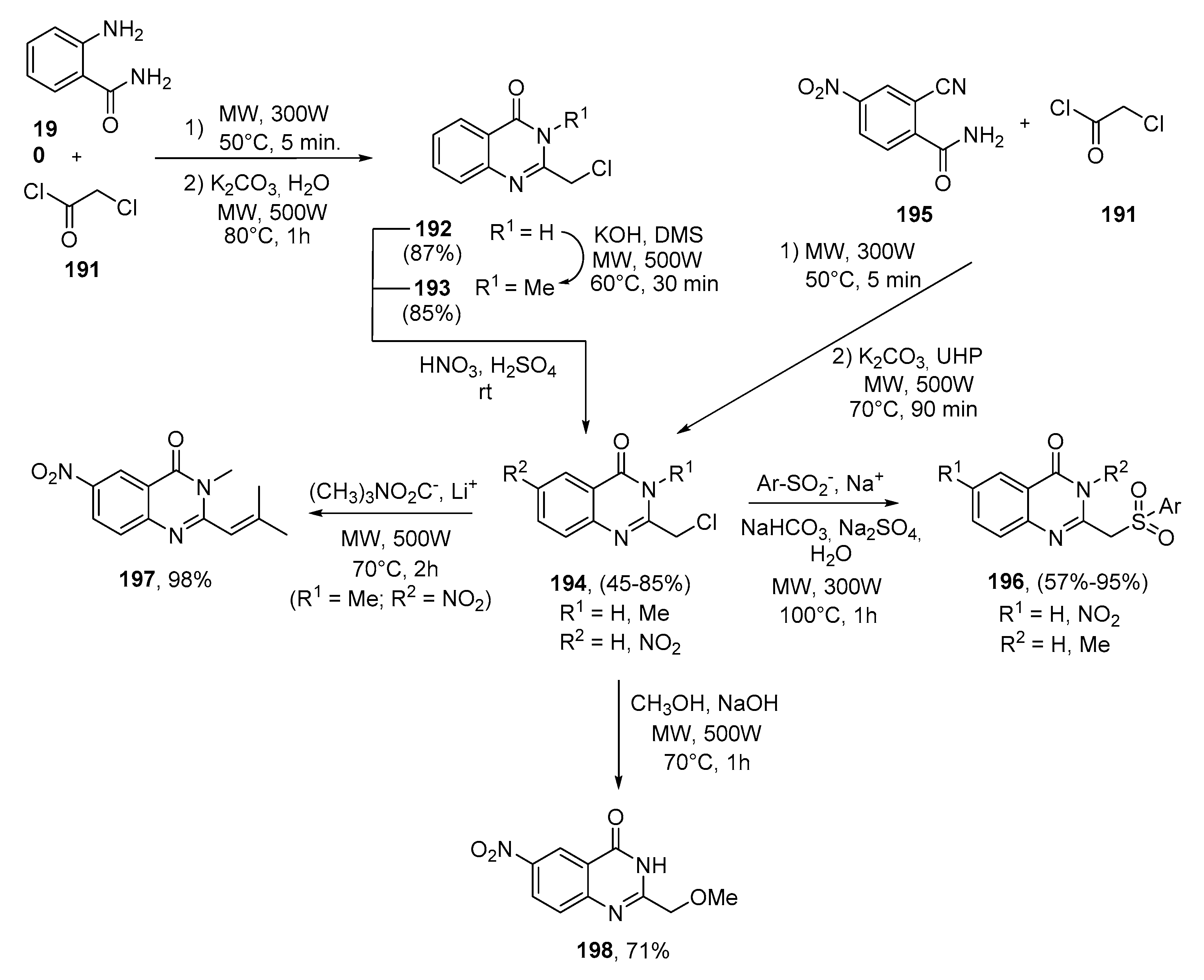

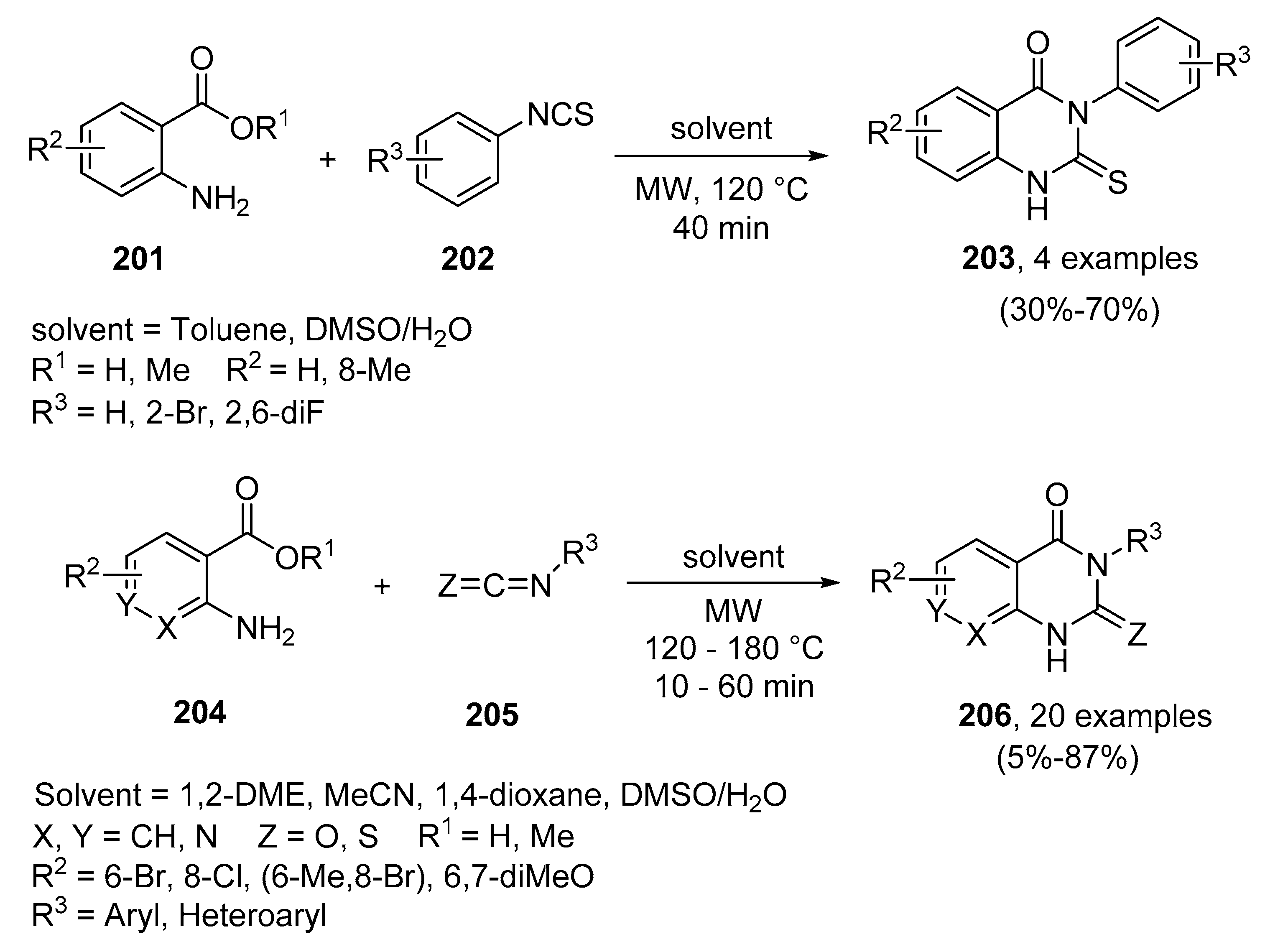
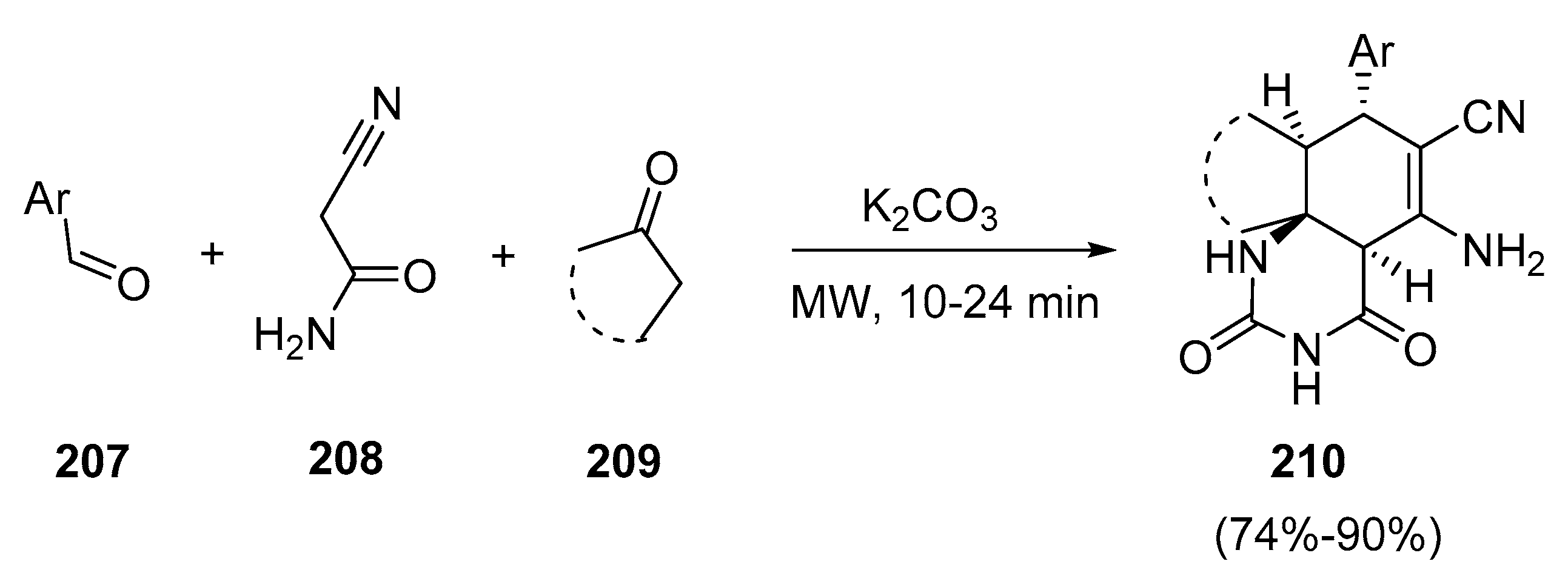
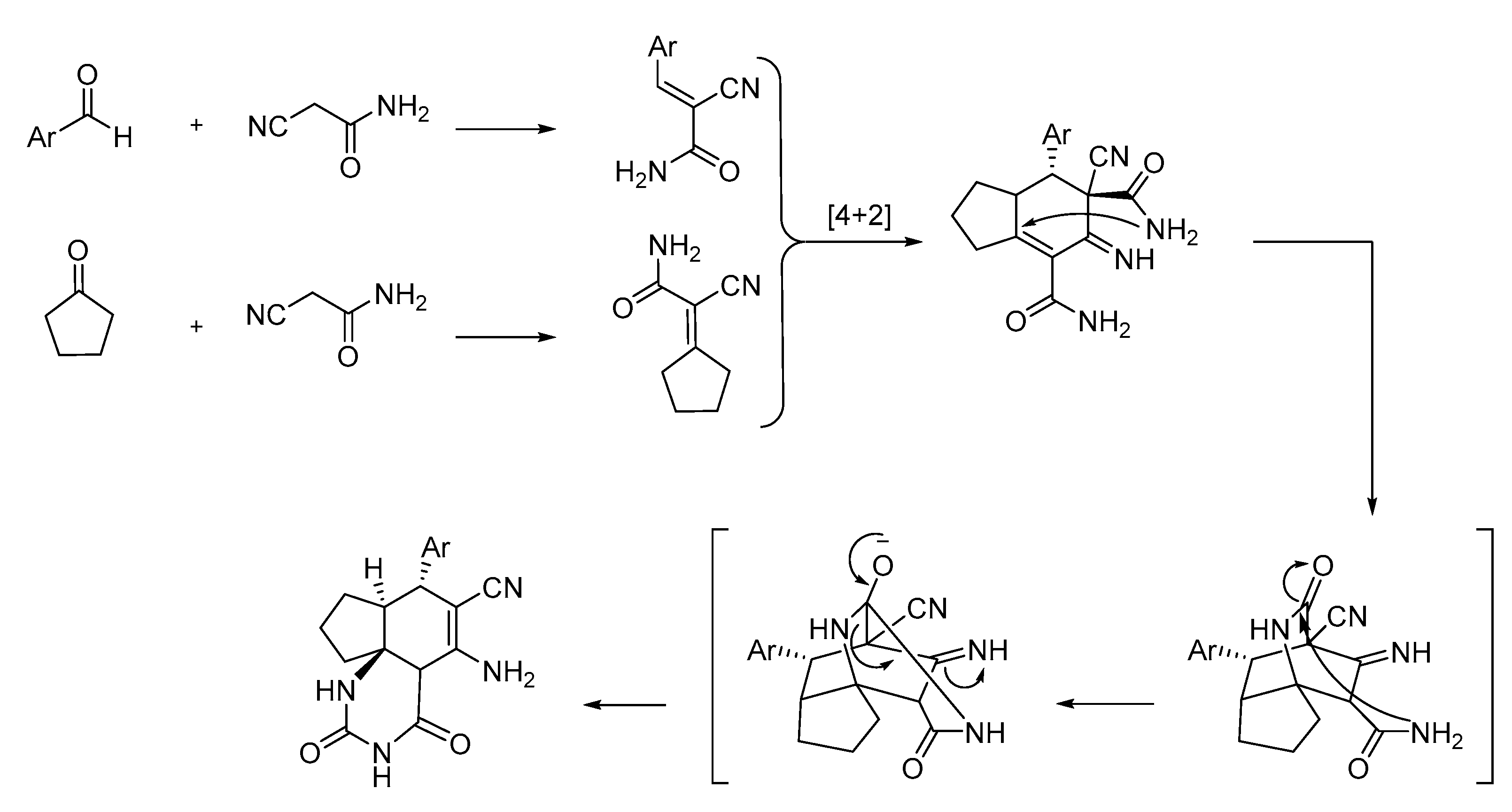

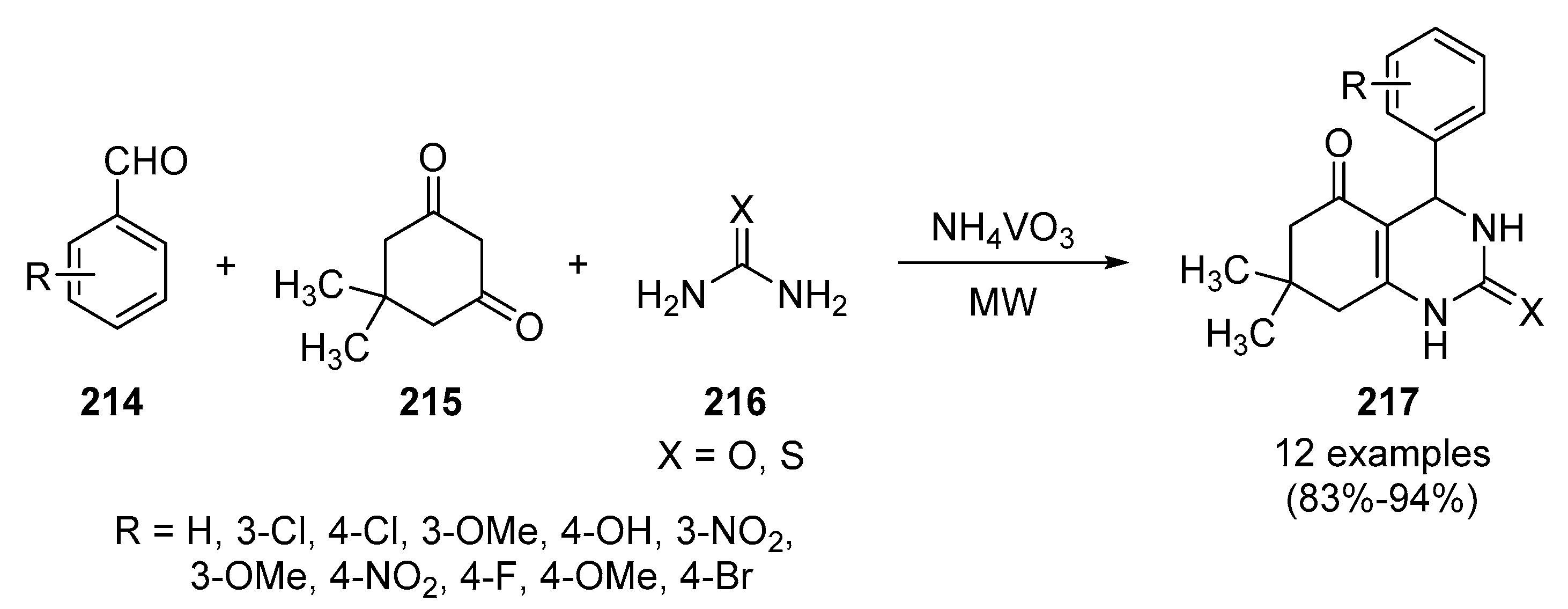
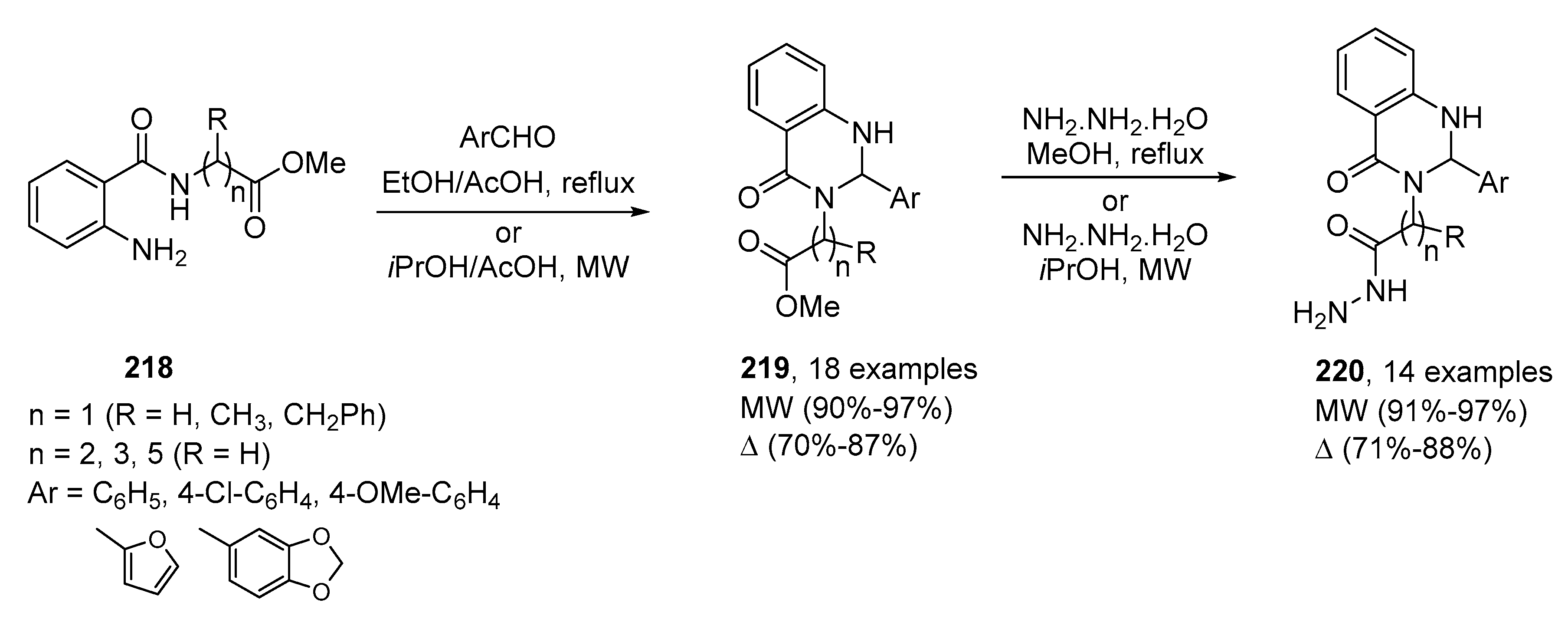
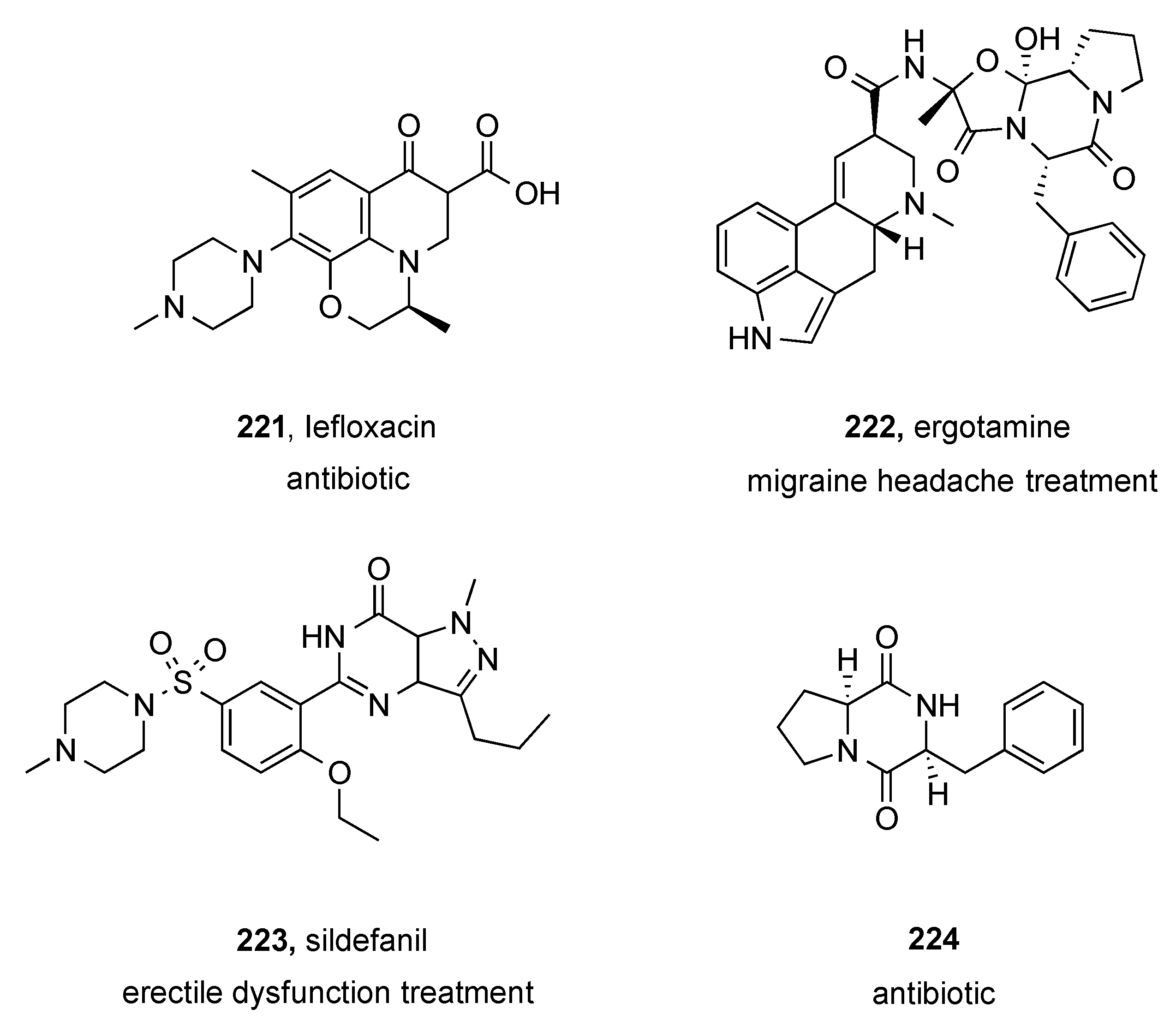
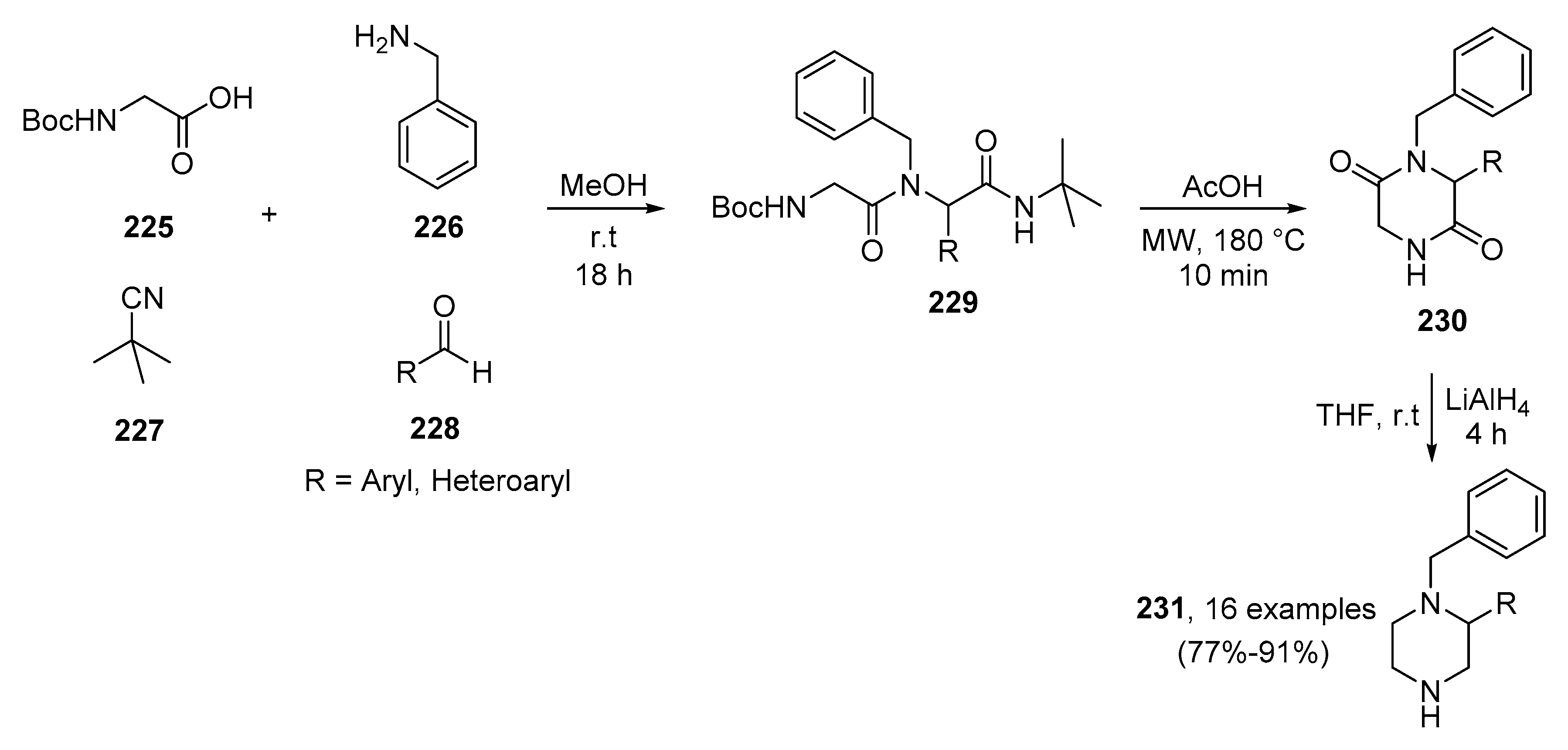
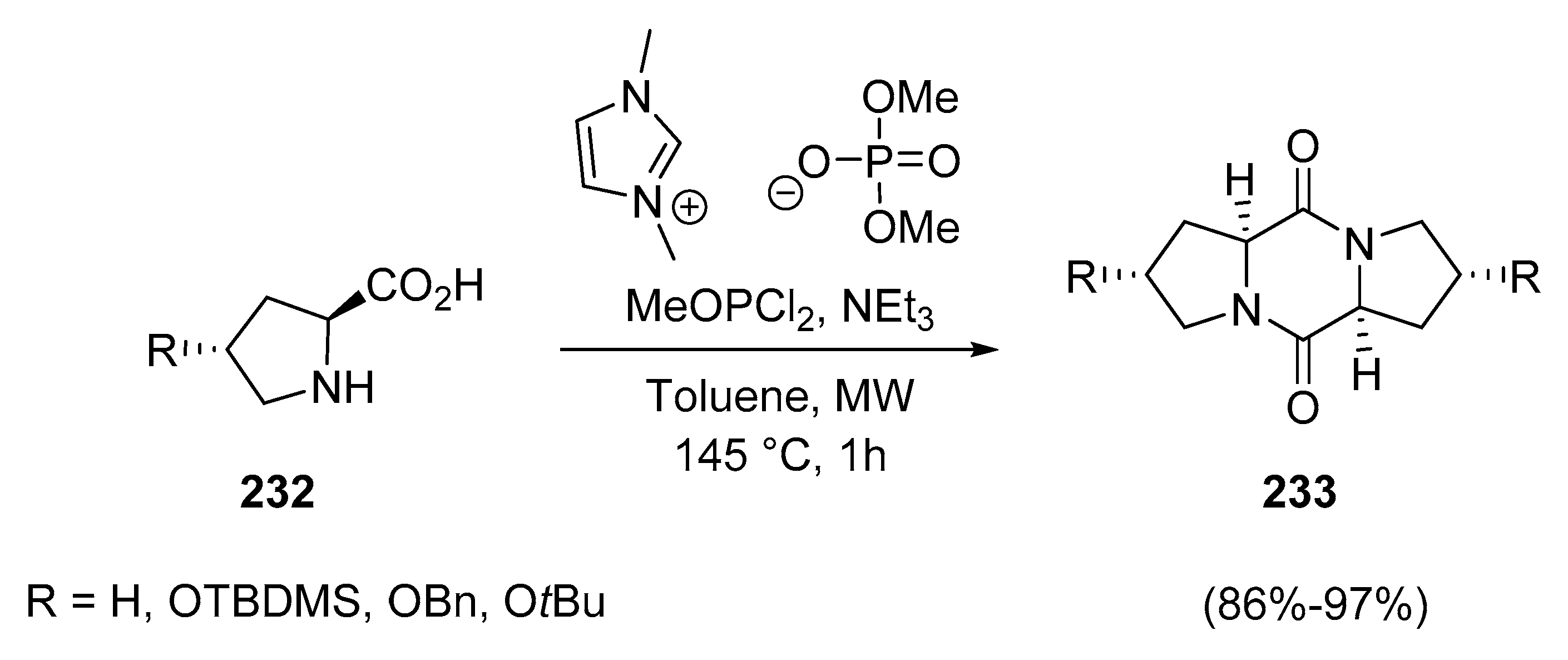



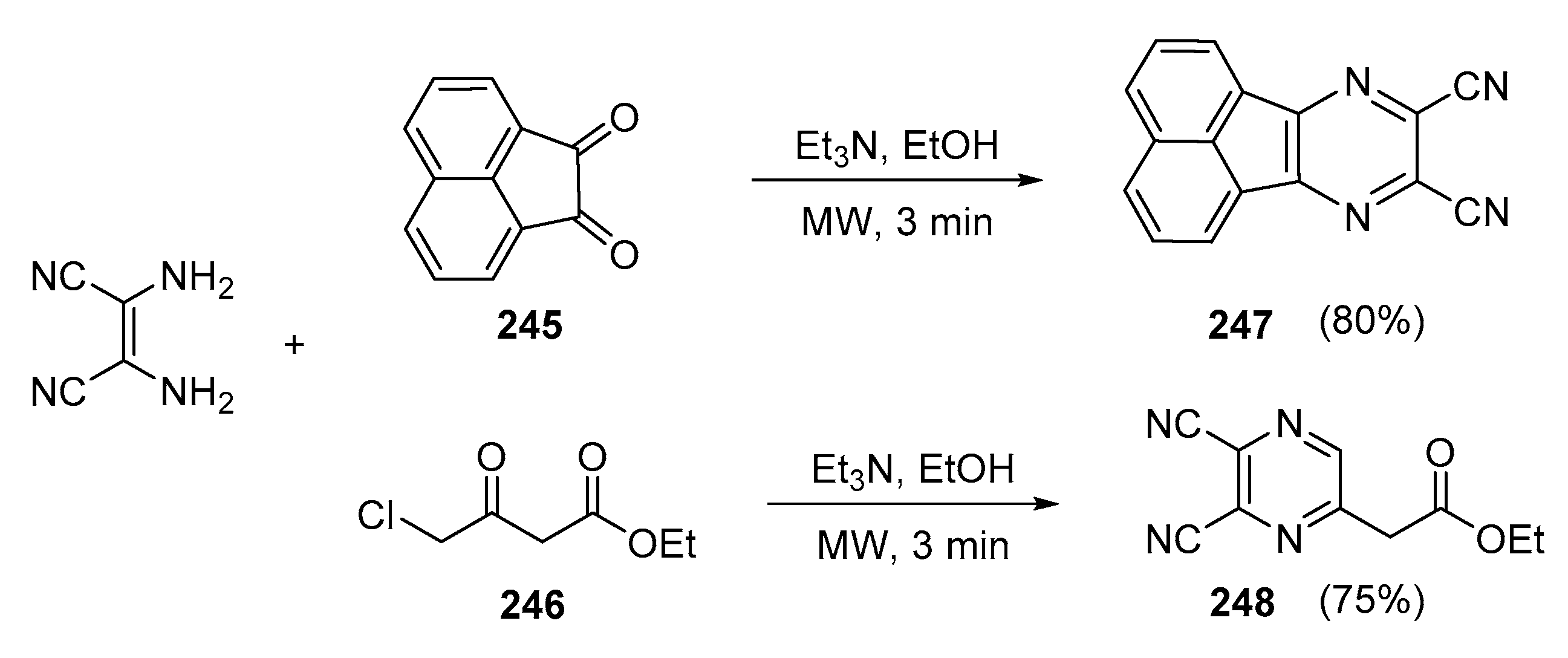


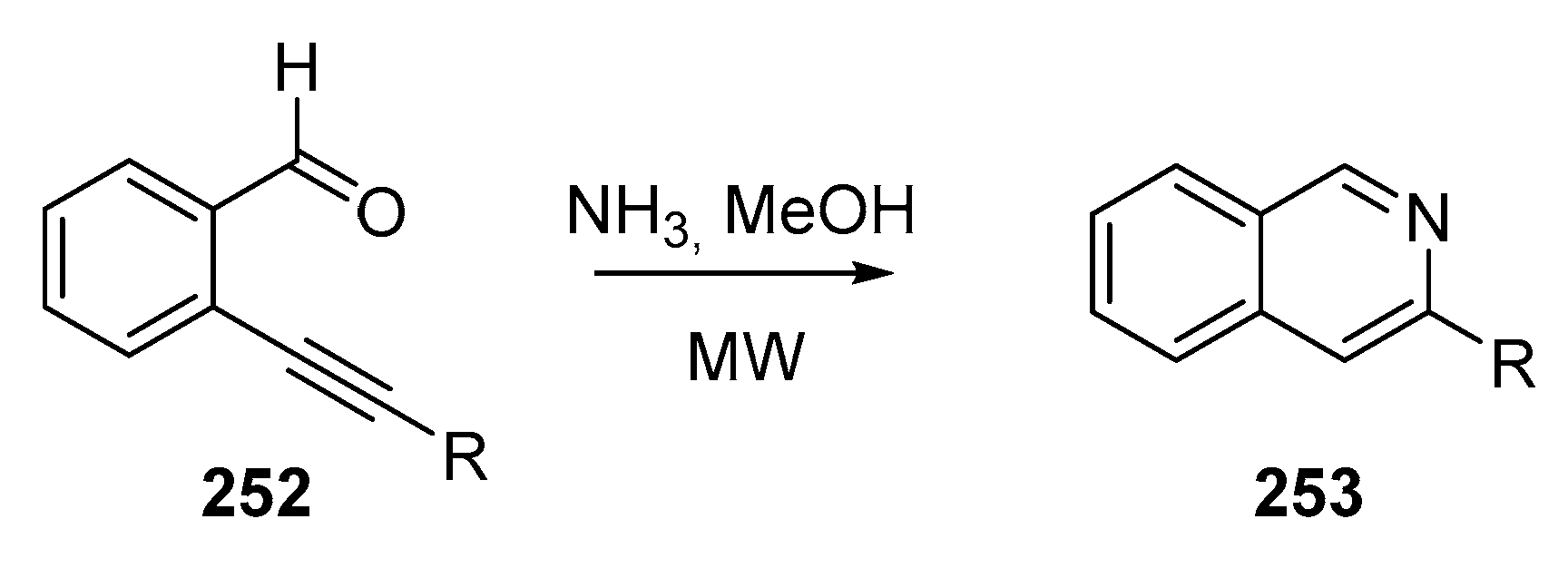
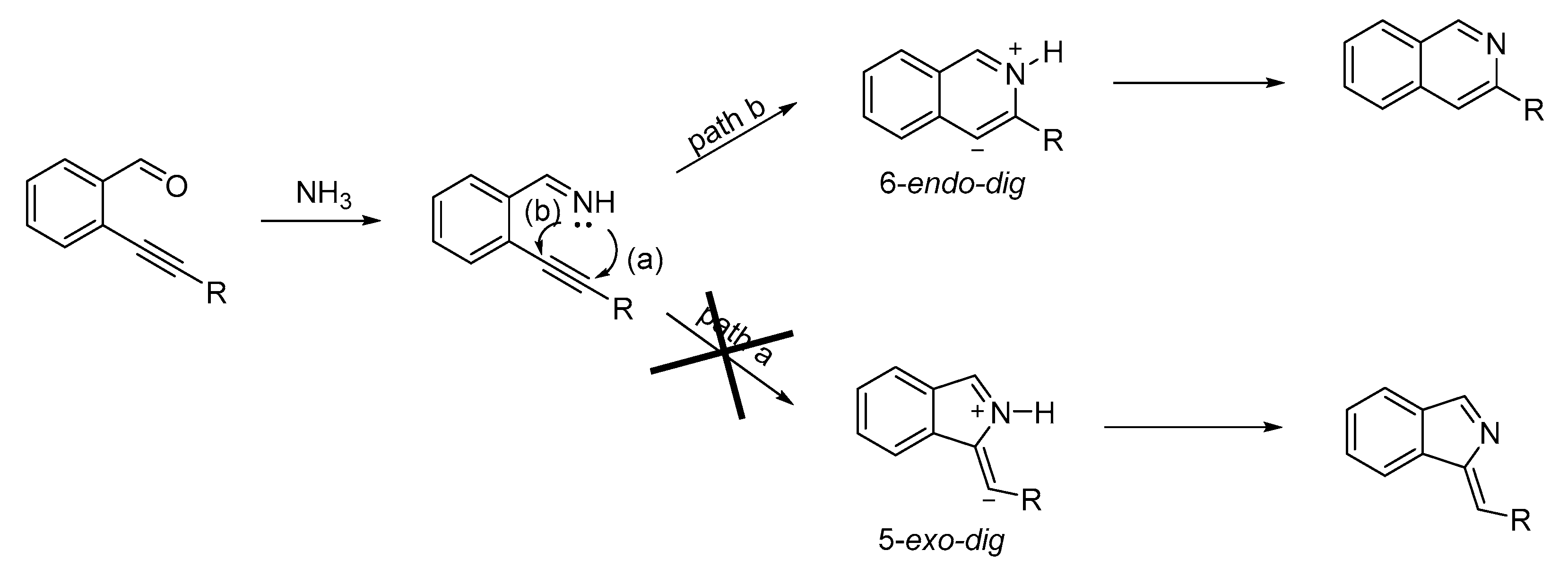

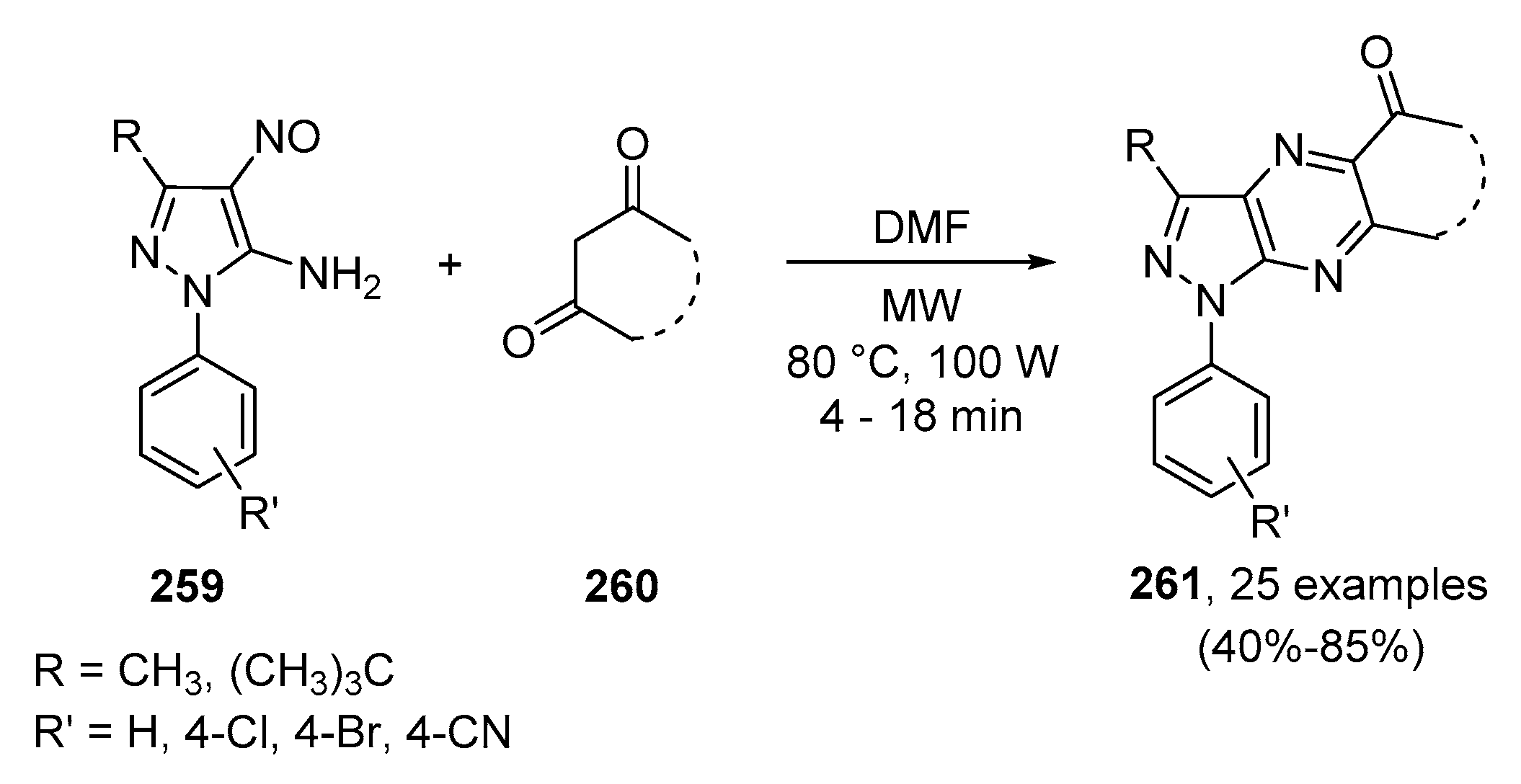
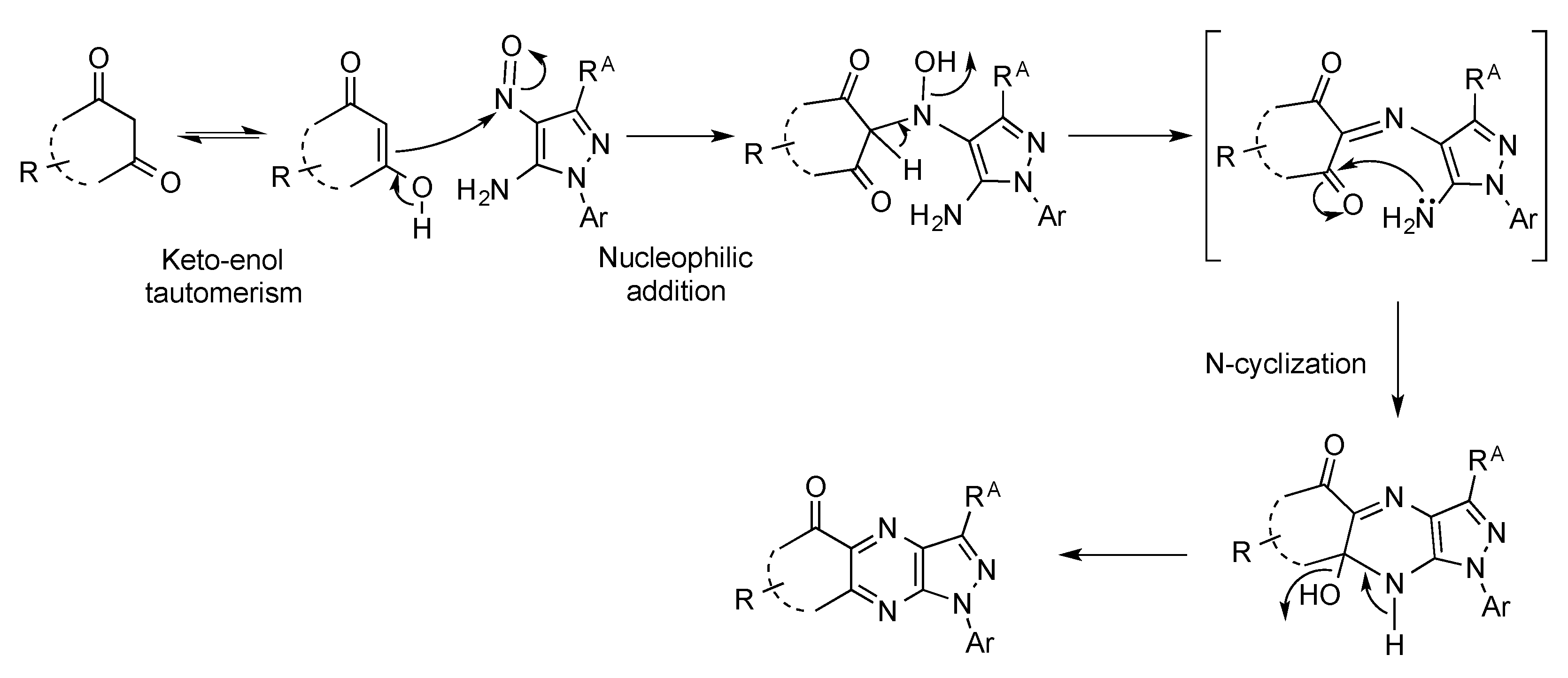
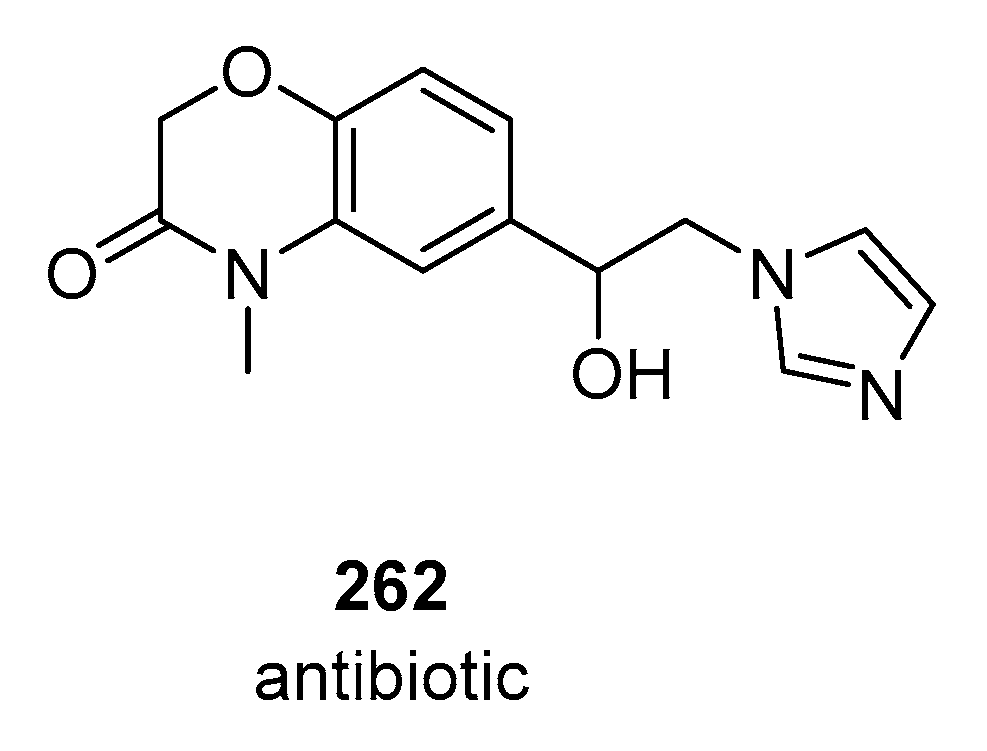

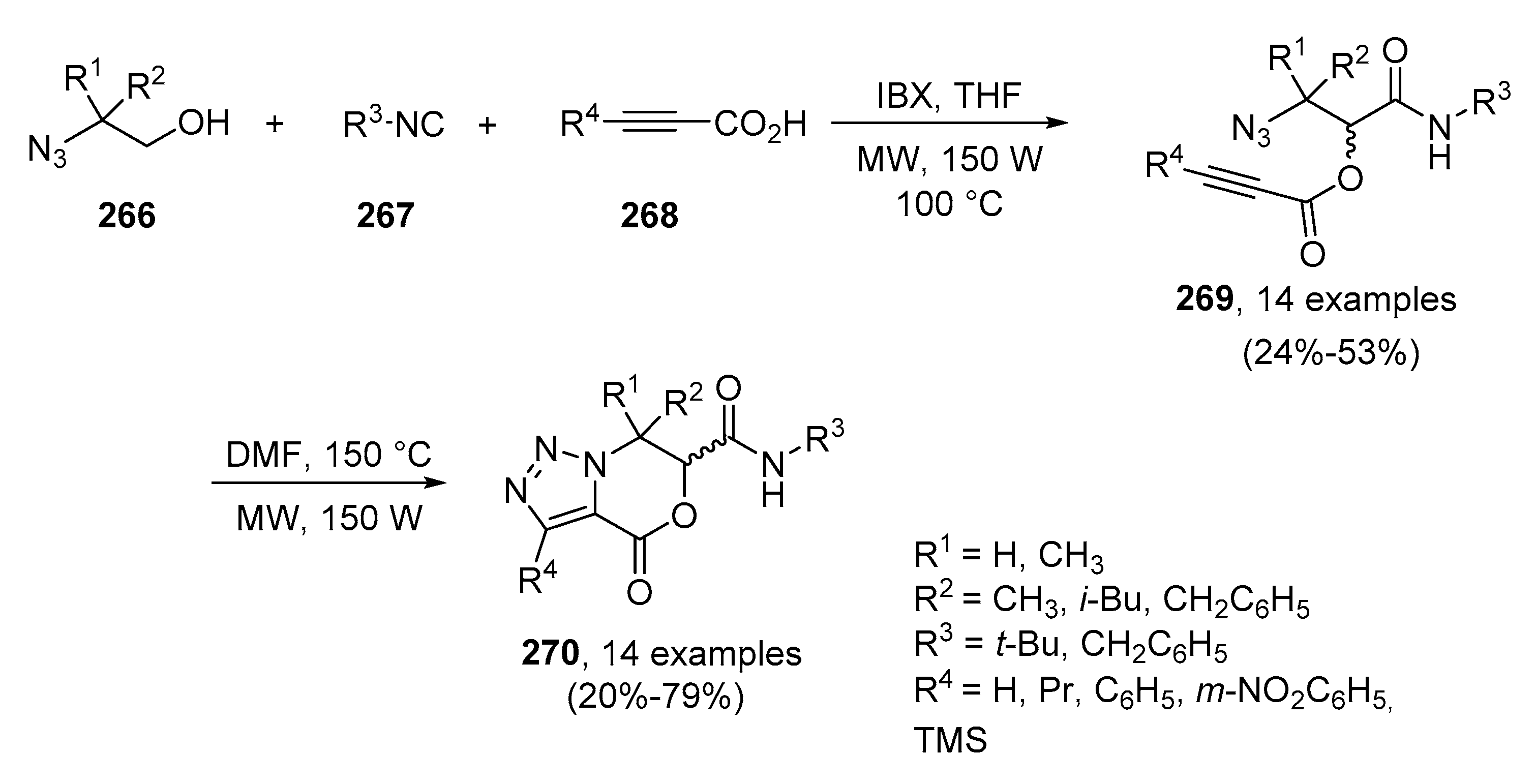
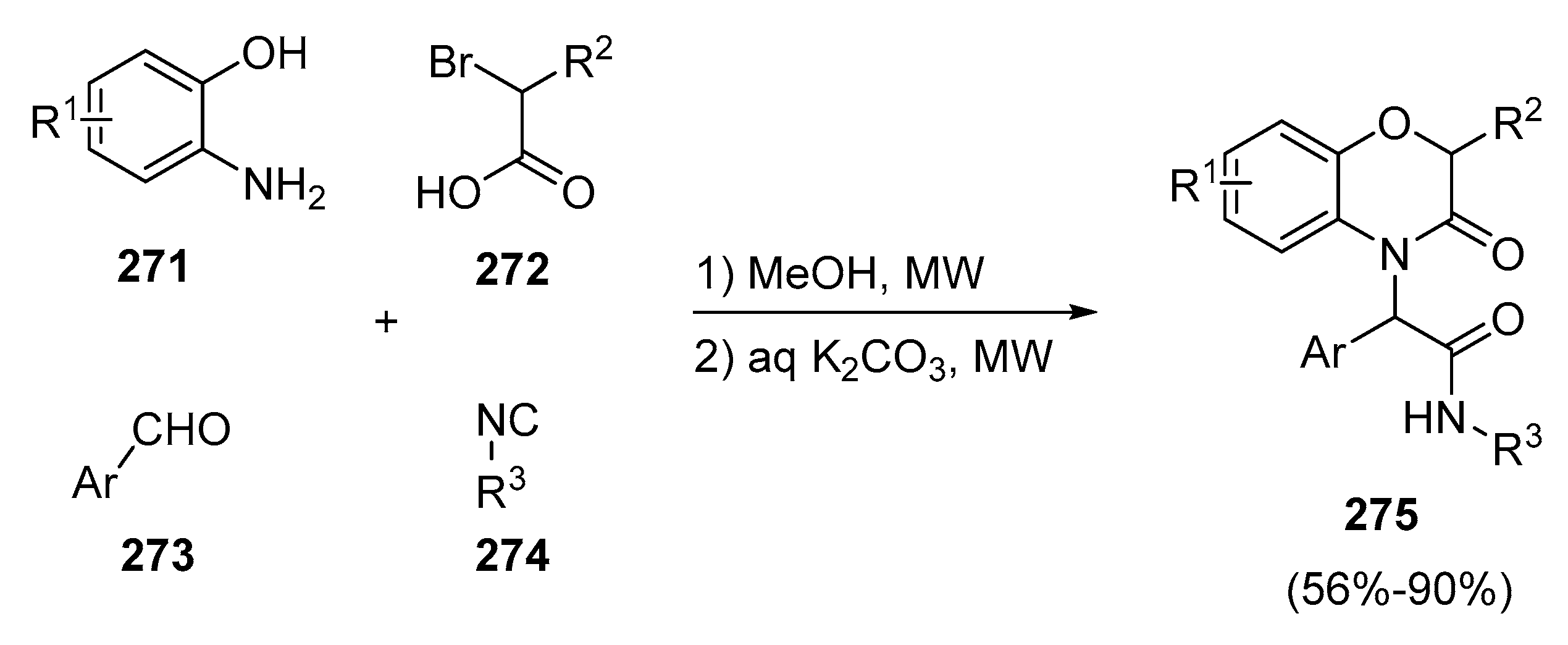
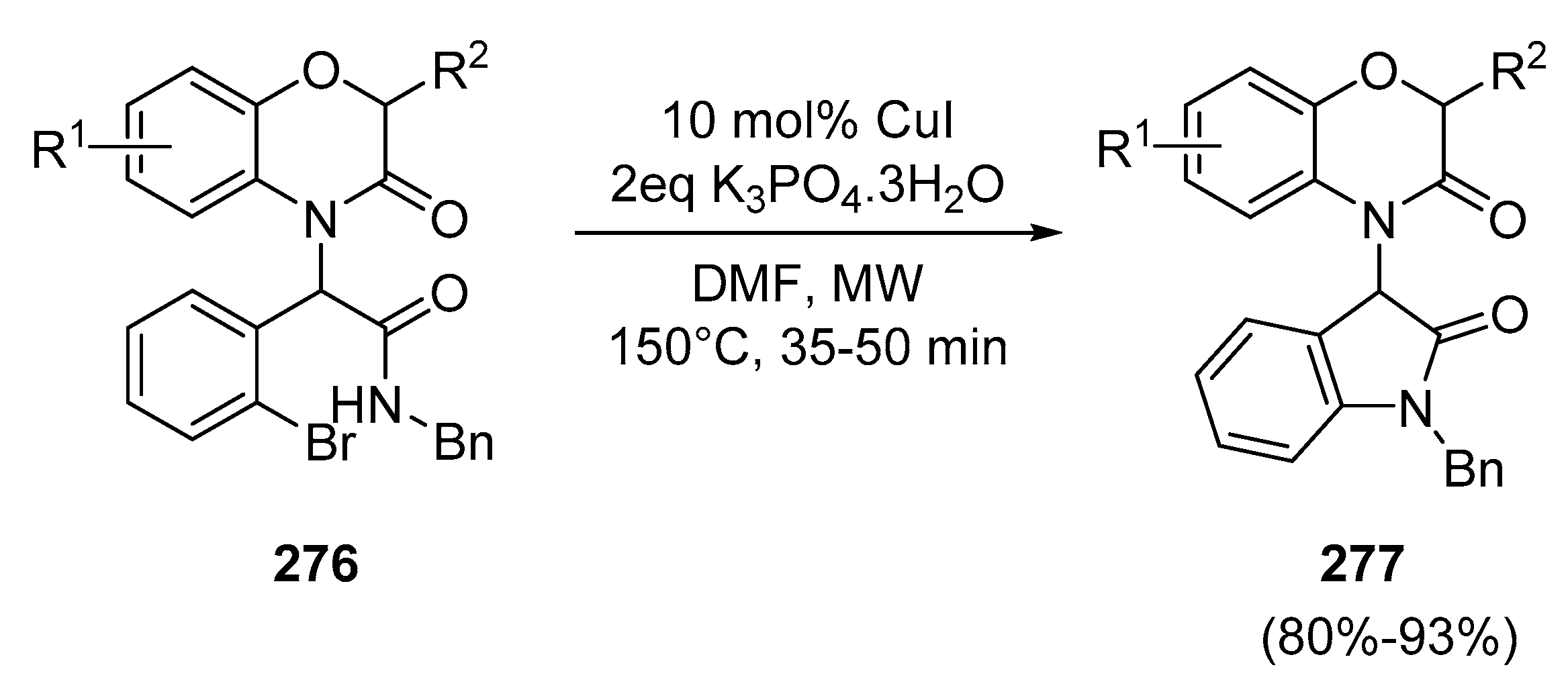
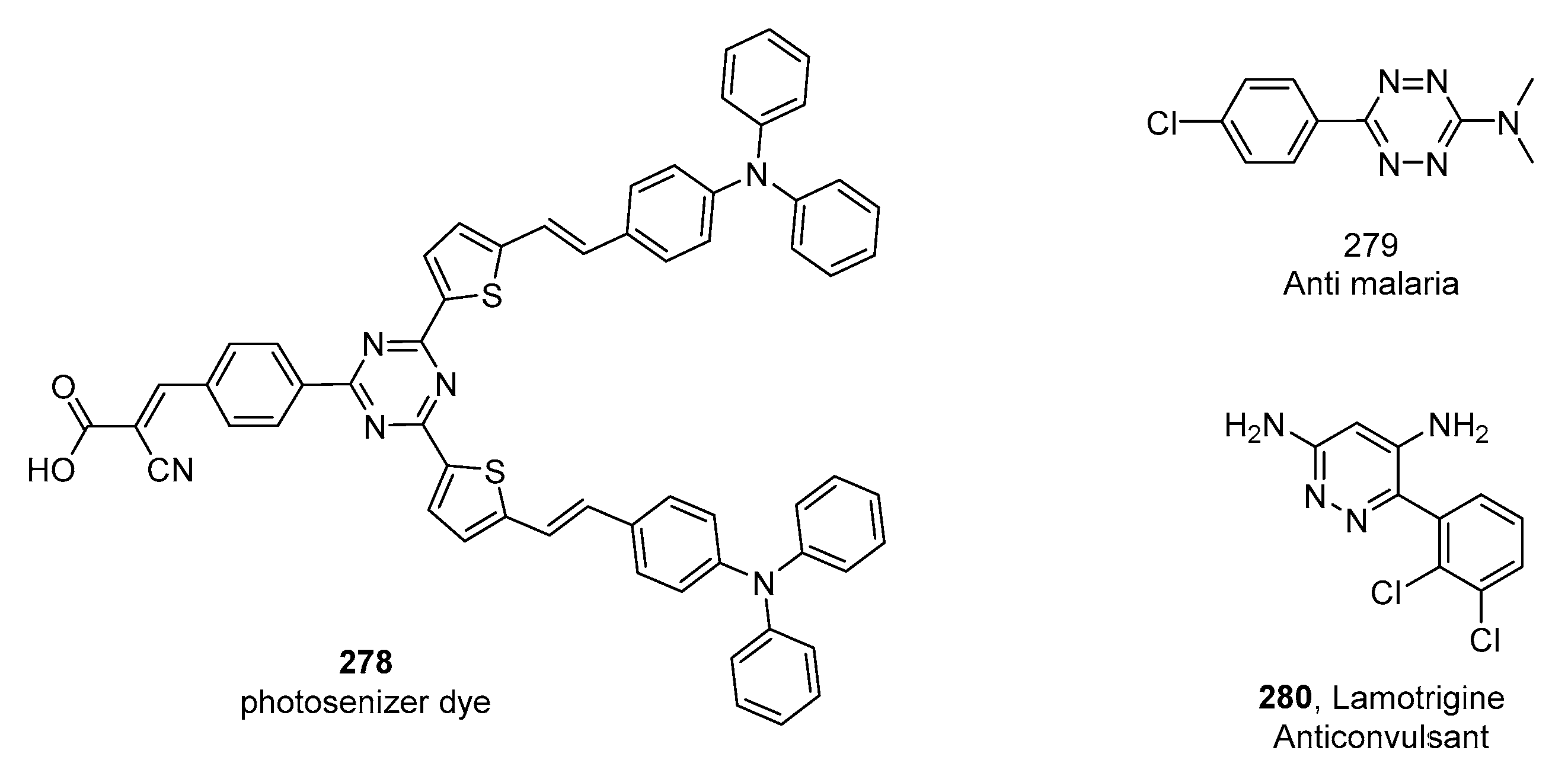
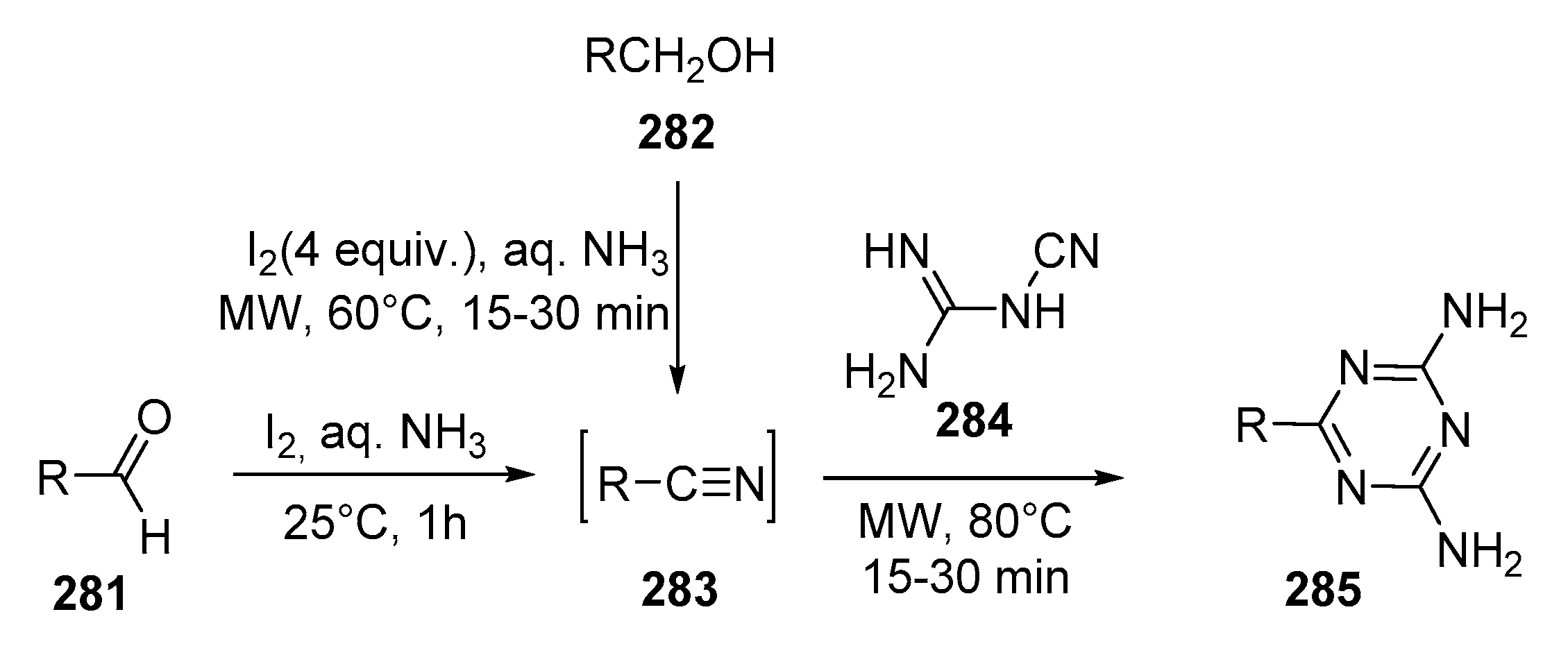
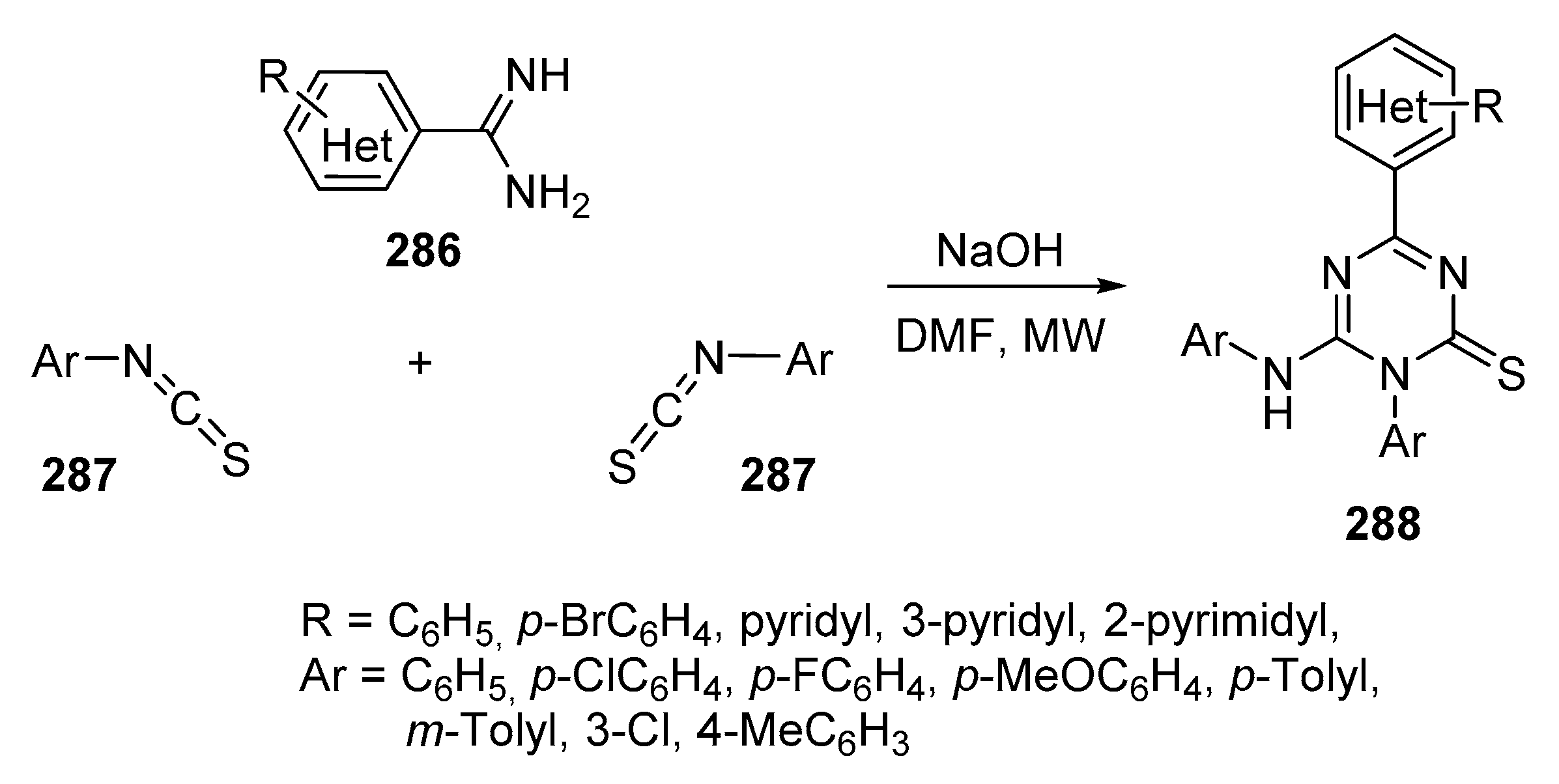

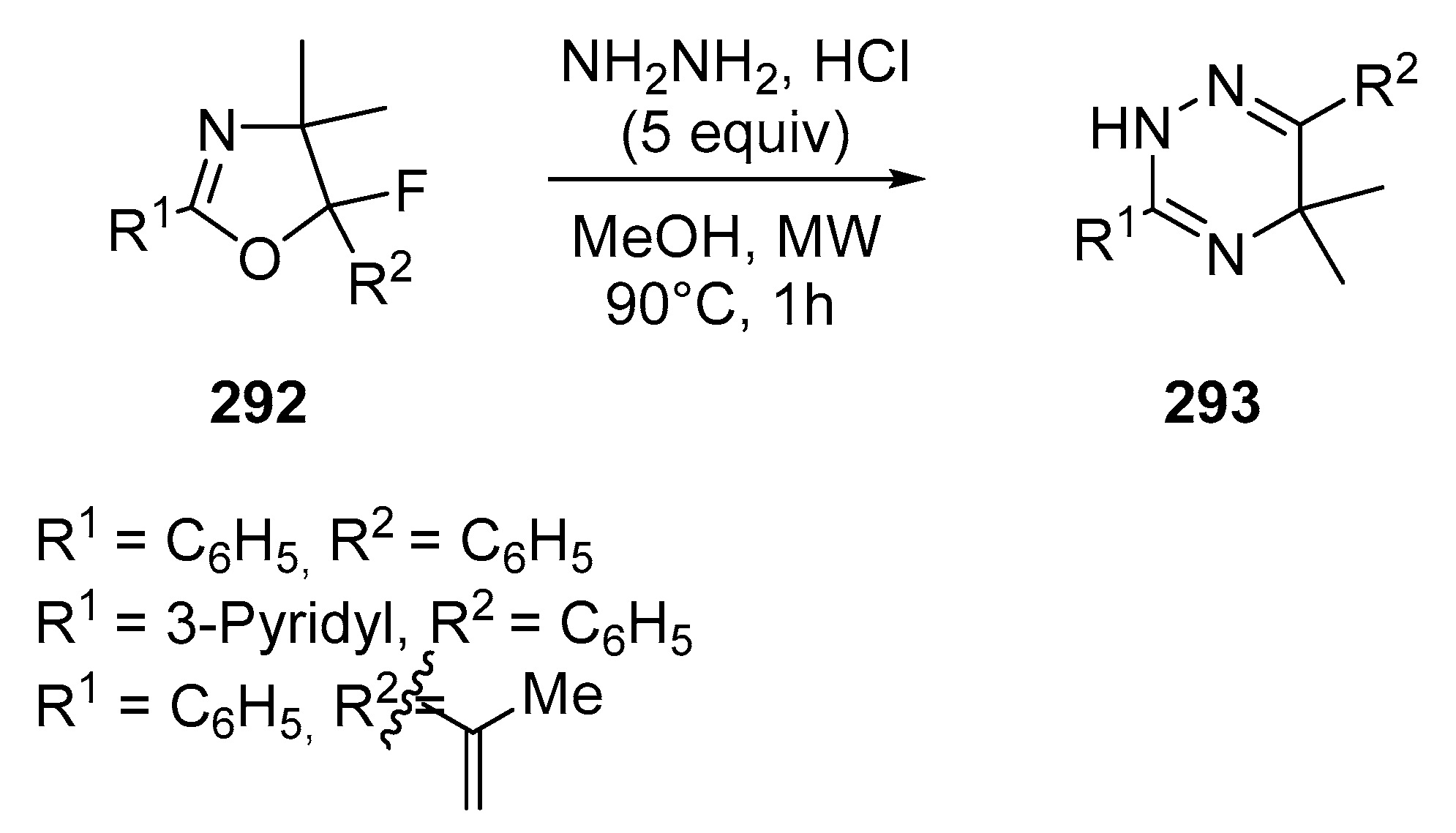

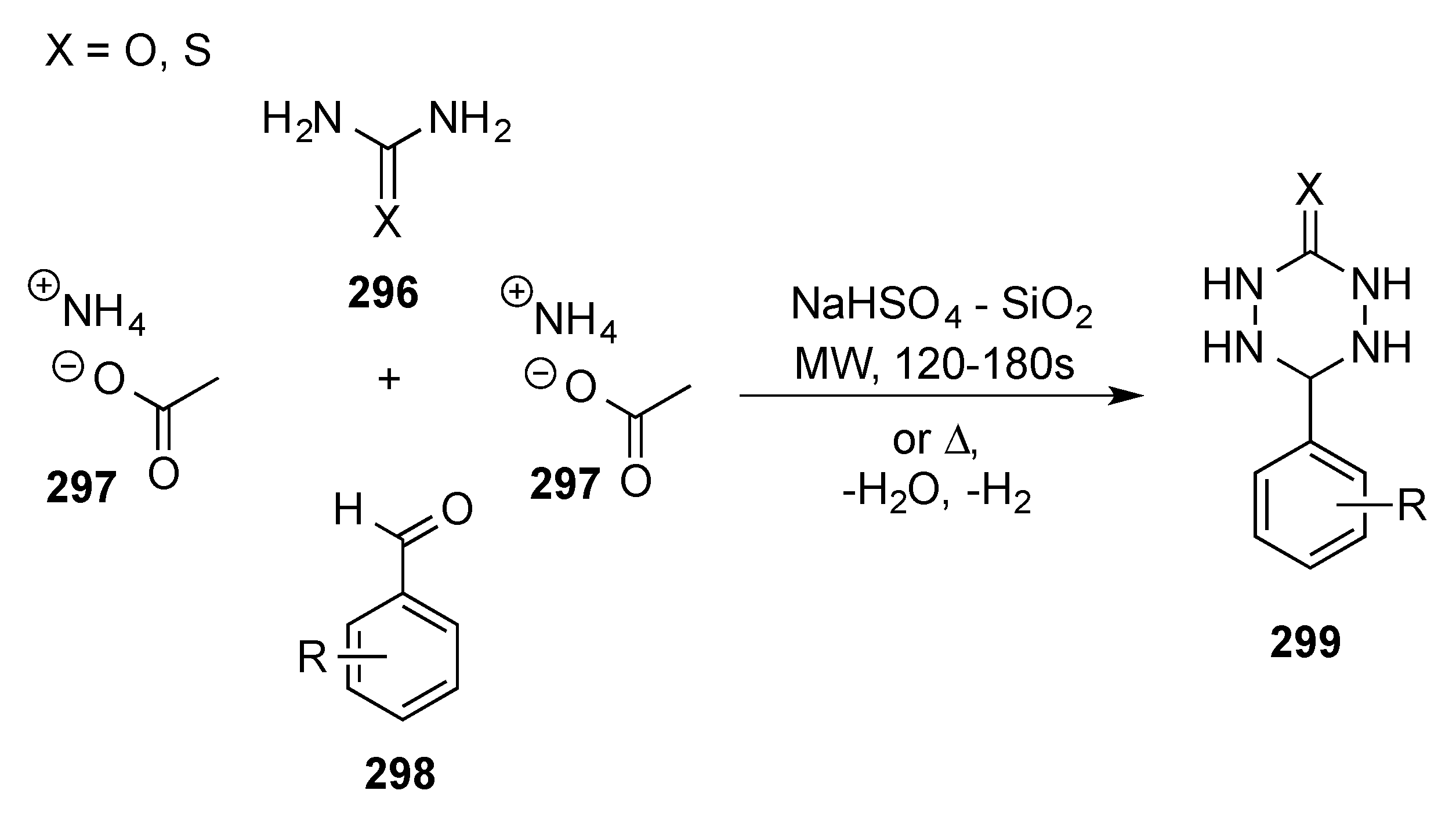

© 2016 by the authors. Licensee MDPI, Basel, Switzerland. This article is an open access article distributed under the terms and conditions of the Creative Commons by Attribution (CC-BY) license ( http://creativecommons.org/licenses/by/4.0/).
Share and Cite
Driowya, M.; Saber, A.; Marzag, H.; Demange, L.; Benhida, R.; Bougrin, K. Microwave-Assisted Synthesis of Bioactive Six-Membered Heterocycles and Their Fused Analogues. Molecules 2016, 21, 492. https://doi.org/10.3390/molecules21040492
Driowya M, Saber A, Marzag H, Demange L, Benhida R, Bougrin K. Microwave-Assisted Synthesis of Bioactive Six-Membered Heterocycles and Their Fused Analogues. Molecules. 2016; 21(4):492. https://doi.org/10.3390/molecules21040492
Chicago/Turabian StyleDriowya, Mohsine, Aziza Saber, Hamid Marzag, Luc Demange, Rachid Benhida, and Khalid Bougrin. 2016. "Microwave-Assisted Synthesis of Bioactive Six-Membered Heterocycles and Their Fused Analogues" Molecules 21, no. 4: 492. https://doi.org/10.3390/molecules21040492





